Enterprise Resource Planning (ERP) Systems and ERP Quality
VerifiedAdded on 2022/08/18
|26
|12802
|17
Assignment
AI Summary
Contribute Materials
Your contribution can guide someone’s learning journey. Share your
documents today.
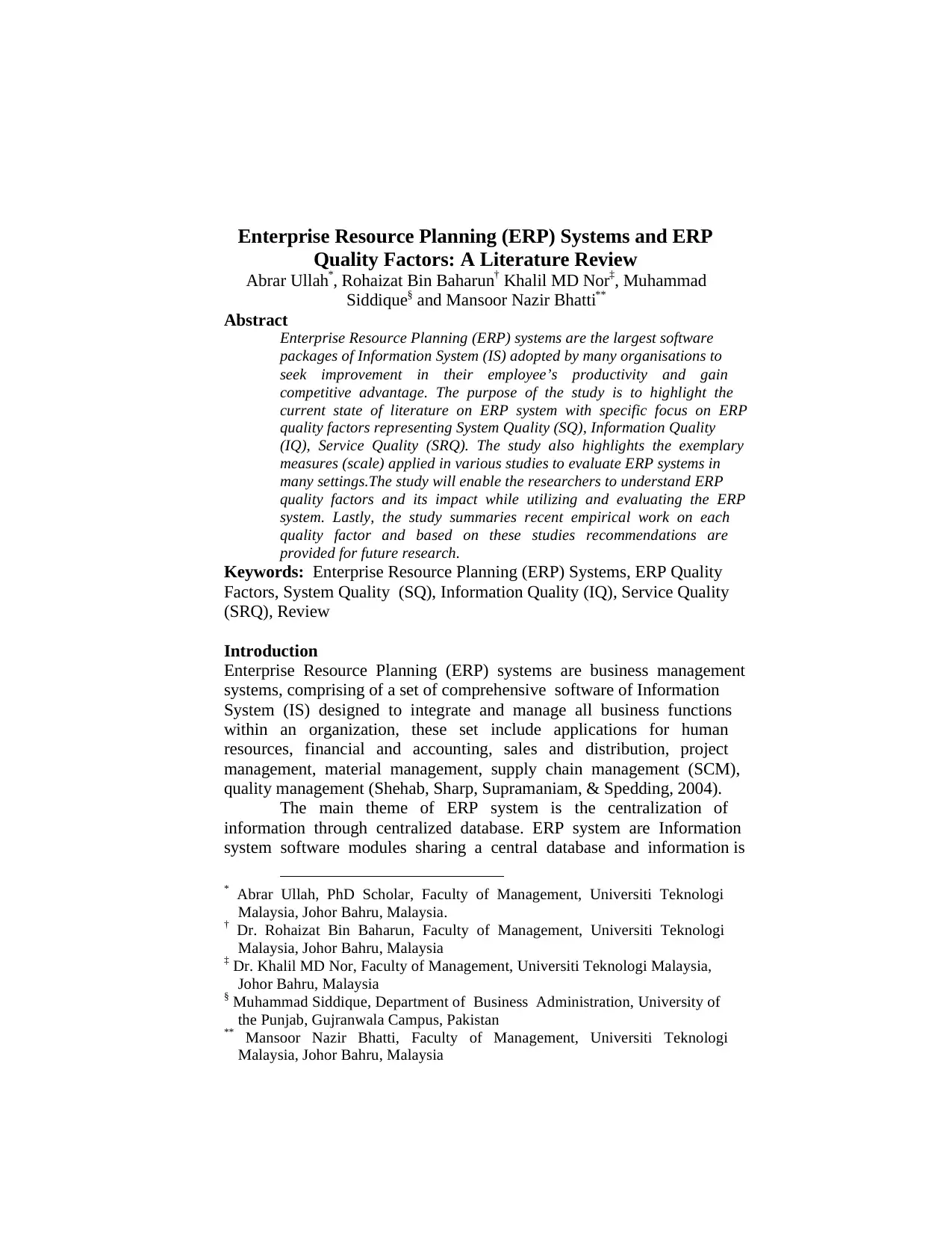
Enterprise Resource Planning (ERP) Systems and ERP
Quality Factors: A Literature Review
Abrar Ullah*, Rohaizat Bin Baharun† Khalil MD Nor‡, Muhammad
Siddique§ and Mansoor Nazir Bhatti**
Abstract
Enterprise Resource Planning (ERP) systems are the largest software
packages of Information System (IS) adopted by many organisations to
seek improvement in their employee’s productivity and gain
competitive advantage. The purpose of the study is to highlight the
current state of literature on ERP system with specific focus on ERP
quality factors representing System Quality (SQ), Information Quality
(IQ), Service Quality (SRQ). The study also highlights the exemplary
measures (scale) applied in various studies to evaluate ERP systems in
many settings.The study will enable the researchers to understand ERP
quality factors and its impact while utilizing and evaluating the ERP
system. Lastly, the study summaries recent empirical work on each
quality factor and based on these studies recommendations are
provided for future research.
Keywords: Enterprise Resource Planning (ERP) Systems, ERP Quality
Factors, System Quality (SQ), Information Quality (IQ), Service Quality
(SRQ), Review
Introduction
Enterprise Resource Planning (ERP) systems are business management
systems, comprising of a set of comprehensive software of Information
System (IS) designed to integrate and manage all business functions
within an organization, these set include applications for human
resources, financial and accounting, sales and distribution, project
management, material management, supply chain management (SCM),
quality management (Shehab, Sharp, Supramaniam, & Spedding, 2004).
The main theme of ERP system is the centralization of
information through centralized database. ERP system are Information
system software modules sharing a central database and information is
* Abrar Ullah, PhD Scholar, Faculty of Management, Universiti Teknologi
Malaysia, Johor Bahru, Malaysia.
† Dr. Rohaizat Bin Baharun, Faculty of Management, Universiti Teknologi
Malaysia, Johor Bahru, Malaysia
‡ Dr. Khalil MD Nor, Faculty of Management, Universiti Teknologi Malaysia,
Johor Bahru, Malaysia
§ Muhammad Siddique, Department of Business Administration, University of
the Punjab, Gujranwala Campus, Pakistan
** Mansoor Nazir Bhatti, Faculty of Management, Universiti Teknologi
Malaysia, Johor Bahru, Malaysia
Quality Factors: A Literature Review
Abrar Ullah*, Rohaizat Bin Baharun† Khalil MD Nor‡, Muhammad
Siddique§ and Mansoor Nazir Bhatti**
Abstract
Enterprise Resource Planning (ERP) systems are the largest software
packages of Information System (IS) adopted by many organisations to
seek improvement in their employee’s productivity and gain
competitive advantage. The purpose of the study is to highlight the
current state of literature on ERP system with specific focus on ERP
quality factors representing System Quality (SQ), Information Quality
(IQ), Service Quality (SRQ). The study also highlights the exemplary
measures (scale) applied in various studies to evaluate ERP systems in
many settings.The study will enable the researchers to understand ERP
quality factors and its impact while utilizing and evaluating the ERP
system. Lastly, the study summaries recent empirical work on each
quality factor and based on these studies recommendations are
provided for future research.
Keywords: Enterprise Resource Planning (ERP) Systems, ERP Quality
Factors, System Quality (SQ), Information Quality (IQ), Service Quality
(SRQ), Review
Introduction
Enterprise Resource Planning (ERP) systems are business management
systems, comprising of a set of comprehensive software of Information
System (IS) designed to integrate and manage all business functions
within an organization, these set include applications for human
resources, financial and accounting, sales and distribution, project
management, material management, supply chain management (SCM),
quality management (Shehab, Sharp, Supramaniam, & Spedding, 2004).
The main theme of ERP system is the centralization of
information through centralized database. ERP system are Information
system software modules sharing a central database and information is
* Abrar Ullah, PhD Scholar, Faculty of Management, Universiti Teknologi
Malaysia, Johor Bahru, Malaysia.
† Dr. Rohaizat Bin Baharun, Faculty of Management, Universiti Teknologi
Malaysia, Johor Bahru, Malaysia
‡ Dr. Khalil MD Nor, Faculty of Management, Universiti Teknologi Malaysia,
Johor Bahru, Malaysia
§ Muhammad Siddique, Department of Business Administration, University of
the Punjab, Gujranwala Campus, Pakistan
** Mansoor Nazir Bhatti, Faculty of Management, Universiti Teknologi
Malaysia, Johor Bahru, Malaysia
Secure Best Marks with AI Grader
Need help grading? Try our AI Grader for instant feedback on your assignments.
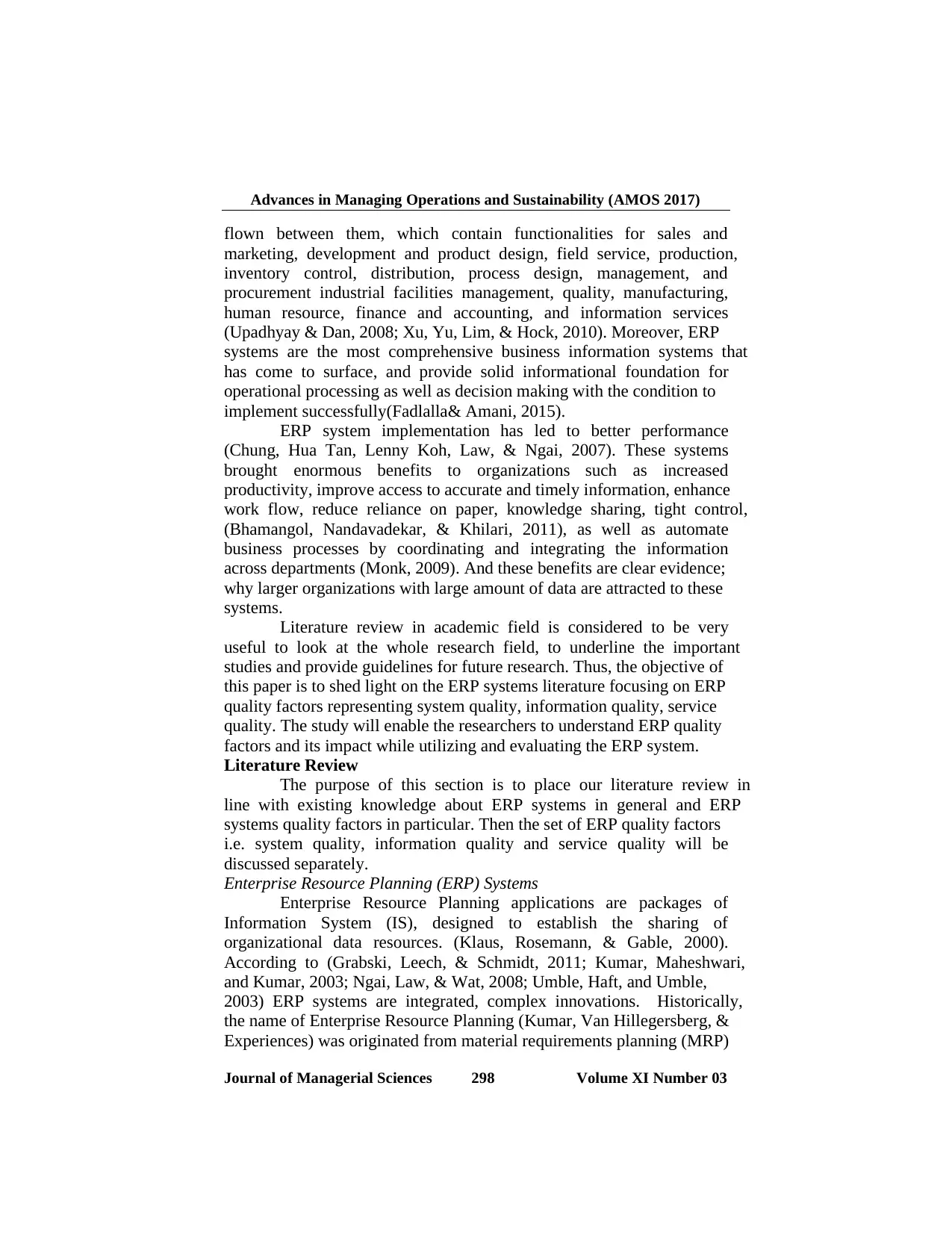
Advances in Managing Operations and Sustainability (AMOS 2017)
Journal of Managerial Sciences 298 Volume XI Number 03
flown between them, which contain functionalities for sales and
marketing, development and product design, field service, production,
inventory control, distribution, process design, management, and
procurement industrial facilities management, quality, manufacturing,
human resource, finance and accounting, and information services
(Upadhyay & Dan, 2008; Xu, Yu, Lim, & Hock, 2010). Moreover, ERP
systems are the most comprehensive business information systems that
has come to surface, and provide solid informational foundation for
operational processing as well as decision making with the condition to
implement successfully(Fadlalla& Amani, 2015).
ERP system implementation has led to better performance
(Chung, Hua Tan, Lenny Koh, Law, & Ngai, 2007). These systems
brought enormous benefits to organizations such as increased
productivity, improve access to accurate and timely information, enhance
work flow, reduce reliance on paper, knowledge sharing, tight control,
(Bhamangol, Nandavadekar, & Khilari, 2011), as well as automate
business processes by coordinating and integrating the information
across departments (Monk, 2009). And these benefits are clear evidence;
why larger organizations with large amount of data are attracted to these
systems.
Literature review in academic field is considered to be very
useful to look at the whole research field, to underline the important
studies and provide guidelines for future research. Thus, the objective of
this paper is to shed light on the ERP systems literature focusing on ERP
quality factors representing system quality, information quality, service
quality. The study will enable the researchers to understand ERP quality
factors and its impact while utilizing and evaluating the ERP system.
Literature Review
The purpose of this section is to place our literature review in
line with existing knowledge about ERP systems in general and ERP
systems quality factors in particular. Then the set of ERP quality factors
i.e. system quality, information quality and service quality will be
discussed separately.
Enterprise Resource Planning (ERP) Systems
Enterprise Resource Planning applications are packages of
Information System (IS), designed to establish the sharing of
organizational data resources. (Klaus, Rosemann, & Gable, 2000).
According to (Grabski, Leech, & Schmidt, 2011; Kumar, Maheshwari,
and Kumar, 2003; Ngai, Law, & Wat, 2008; Umble, Haft, and Umble,
2003) ERP systems are integrated, complex innovations. Historically,
the name of Enterprise Resource Planning (Kumar, Van Hillegersberg, &
Experiences) was originated from material requirements planning (MRP)
Journal of Managerial Sciences 298 Volume XI Number 03
flown between them, which contain functionalities for sales and
marketing, development and product design, field service, production,
inventory control, distribution, process design, management, and
procurement industrial facilities management, quality, manufacturing,
human resource, finance and accounting, and information services
(Upadhyay & Dan, 2008; Xu, Yu, Lim, & Hock, 2010). Moreover, ERP
systems are the most comprehensive business information systems that
has come to surface, and provide solid informational foundation for
operational processing as well as decision making with the condition to
implement successfully(Fadlalla& Amani, 2015).
ERP system implementation has led to better performance
(Chung, Hua Tan, Lenny Koh, Law, & Ngai, 2007). These systems
brought enormous benefits to organizations such as increased
productivity, improve access to accurate and timely information, enhance
work flow, reduce reliance on paper, knowledge sharing, tight control,
(Bhamangol, Nandavadekar, & Khilari, 2011), as well as automate
business processes by coordinating and integrating the information
across departments (Monk, 2009). And these benefits are clear evidence;
why larger organizations with large amount of data are attracted to these
systems.
Literature review in academic field is considered to be very
useful to look at the whole research field, to underline the important
studies and provide guidelines for future research. Thus, the objective of
this paper is to shed light on the ERP systems literature focusing on ERP
quality factors representing system quality, information quality, service
quality. The study will enable the researchers to understand ERP quality
factors and its impact while utilizing and evaluating the ERP system.
Literature Review
The purpose of this section is to place our literature review in
line with existing knowledge about ERP systems in general and ERP
systems quality factors in particular. Then the set of ERP quality factors
i.e. system quality, information quality and service quality will be
discussed separately.
Enterprise Resource Planning (ERP) Systems
Enterprise Resource Planning applications are packages of
Information System (IS), designed to establish the sharing of
organizational data resources. (Klaus, Rosemann, & Gable, 2000).
According to (Grabski, Leech, & Schmidt, 2011; Kumar, Maheshwari,
and Kumar, 2003; Ngai, Law, & Wat, 2008; Umble, Haft, and Umble,
2003) ERP systems are integrated, complex innovations. Historically,
the name of Enterprise Resource Planning (Kumar, Van Hillegersberg, &
Experiences) was originated from material requirements planning (MRP)
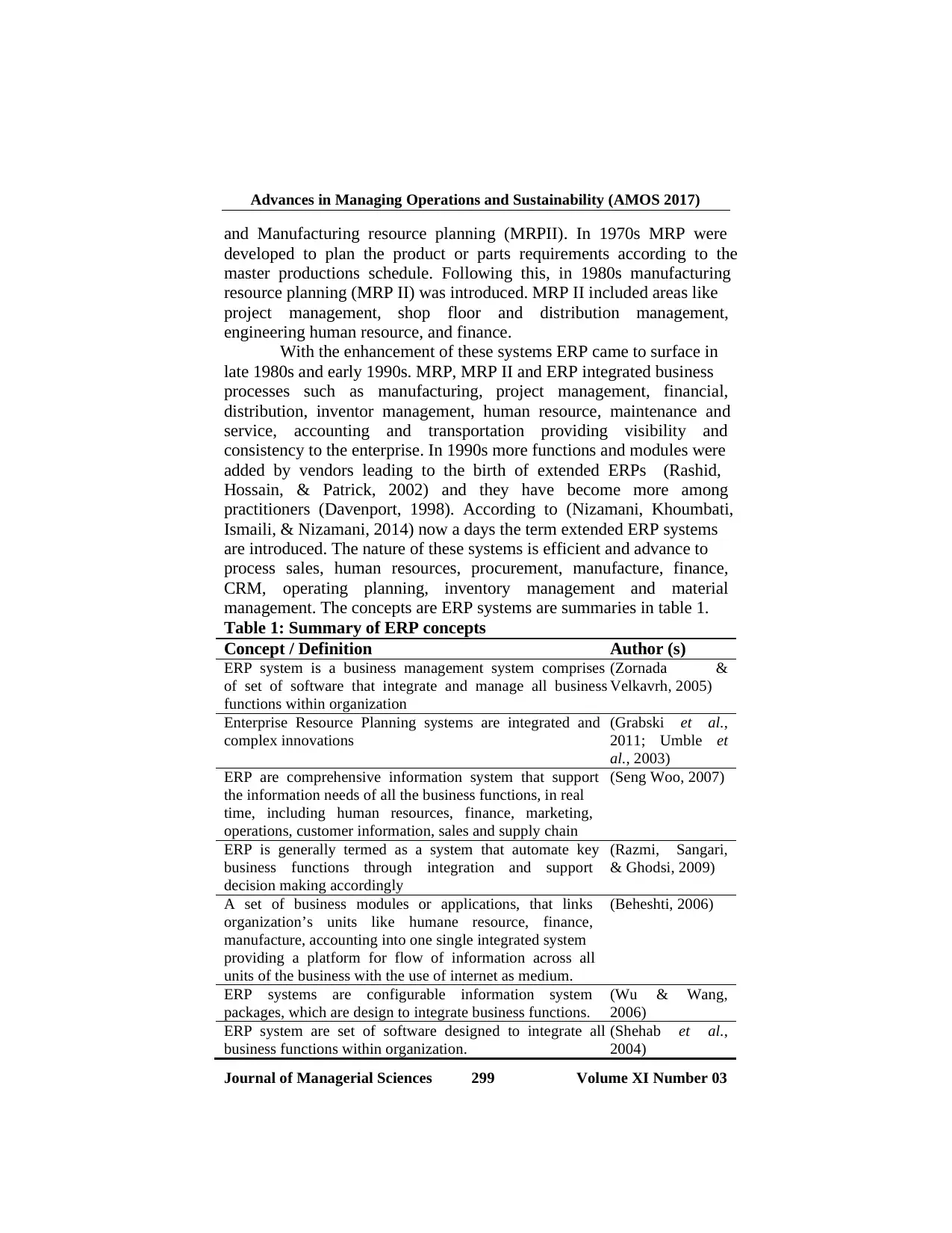
Advances in Managing Operations and Sustainability (AMOS 2017)
Journal of Managerial Sciences 299 Volume XI Number 03
and Manufacturing resource planning (MRPII). In 1970s MRP were
developed to plan the product or parts requirements according to the
master productions schedule. Following this, in 1980s manufacturing
resource planning (MRP II) was introduced. MRP II included areas like
project management, shop floor and distribution management,
engineering human resource, and finance.
With the enhancement of these systems ERP came to surface in
late 1980s and early 1990s. MRP, MRP II and ERP integrated business
processes such as manufacturing, project management, financial,
distribution, inventor management, human resource, maintenance and
service, accounting and transportation providing visibility and
consistency to the enterprise. In 1990s more functions and modules were
added by vendors leading to the birth of extended ERPs (Rashid,
Hossain, & Patrick, 2002) and they have become more among
practitioners (Davenport, 1998). According to (Nizamani, Khoumbati,
Ismaili, & Nizamani, 2014) now a days the term extended ERP systems
are introduced. The nature of these systems is efficient and advance to
process sales, human resources, procurement, manufacture, finance,
CRM, operating planning, inventory management and material
management. The concepts are ERP systems are summaries in table 1.
Table 1: Summary of ERP concepts
Concept / Definition Author (s)
ERP system is a business management system comprises
of set of software that integrate and manage all business
functions within organization
(Zornada &
Velkavrh, 2005)
Enterprise Resource Planning systems are integrated and
complex innovations
(Grabski et al.,
2011; Umble et
al., 2003)
ERP are comprehensive information system that support
the information needs of all the business functions, in real
time, including human resources, finance, marketing,
operations, customer information, sales and supply chain
(Seng Woo, 2007)
ERP is generally termed as a system that automate key
business functions through integration and support
decision making accordingly
(Razmi, Sangari,
& Ghodsi, 2009)
A set of business modules or applications, that links
organization’s units like humane resource, finance,
manufacture, accounting into one single integrated system
providing a platform for flow of information across all
units of the business with the use of internet as medium.
(Beheshti, 2006)
ERP systems are configurable information system
packages, which are design to integrate business functions.
(Wu & Wang,
2006)
ERP system are set of software designed to integrate all
business functions within organization.
(Shehab et al.,
2004)
Journal of Managerial Sciences 299 Volume XI Number 03
and Manufacturing resource planning (MRPII). In 1970s MRP were
developed to plan the product or parts requirements according to the
master productions schedule. Following this, in 1980s manufacturing
resource planning (MRP II) was introduced. MRP II included areas like
project management, shop floor and distribution management,
engineering human resource, and finance.
With the enhancement of these systems ERP came to surface in
late 1980s and early 1990s. MRP, MRP II and ERP integrated business
processes such as manufacturing, project management, financial,
distribution, inventor management, human resource, maintenance and
service, accounting and transportation providing visibility and
consistency to the enterprise. In 1990s more functions and modules were
added by vendors leading to the birth of extended ERPs (Rashid,
Hossain, & Patrick, 2002) and they have become more among
practitioners (Davenport, 1998). According to (Nizamani, Khoumbati,
Ismaili, & Nizamani, 2014) now a days the term extended ERP systems
are introduced. The nature of these systems is efficient and advance to
process sales, human resources, procurement, manufacture, finance,
CRM, operating planning, inventory management and material
management. The concepts are ERP systems are summaries in table 1.
Table 1: Summary of ERP concepts
Concept / Definition Author (s)
ERP system is a business management system comprises
of set of software that integrate and manage all business
functions within organization
(Zornada &
Velkavrh, 2005)
Enterprise Resource Planning systems are integrated and
complex innovations
(Grabski et al.,
2011; Umble et
al., 2003)
ERP are comprehensive information system that support
the information needs of all the business functions, in real
time, including human resources, finance, marketing,
operations, customer information, sales and supply chain
(Seng Woo, 2007)
ERP is generally termed as a system that automate key
business functions through integration and support
decision making accordingly
(Razmi, Sangari,
& Ghodsi, 2009)
A set of business modules or applications, that links
organization’s units like humane resource, finance,
manufacture, accounting into one single integrated system
providing a platform for flow of information across all
units of the business with the use of internet as medium.
(Beheshti, 2006)
ERP systems are configurable information system
packages, which are design to integrate business functions.
(Wu & Wang,
2006)
ERP system are set of software designed to integrate all
business functions within organization.
(Shehab et al.,
2004)
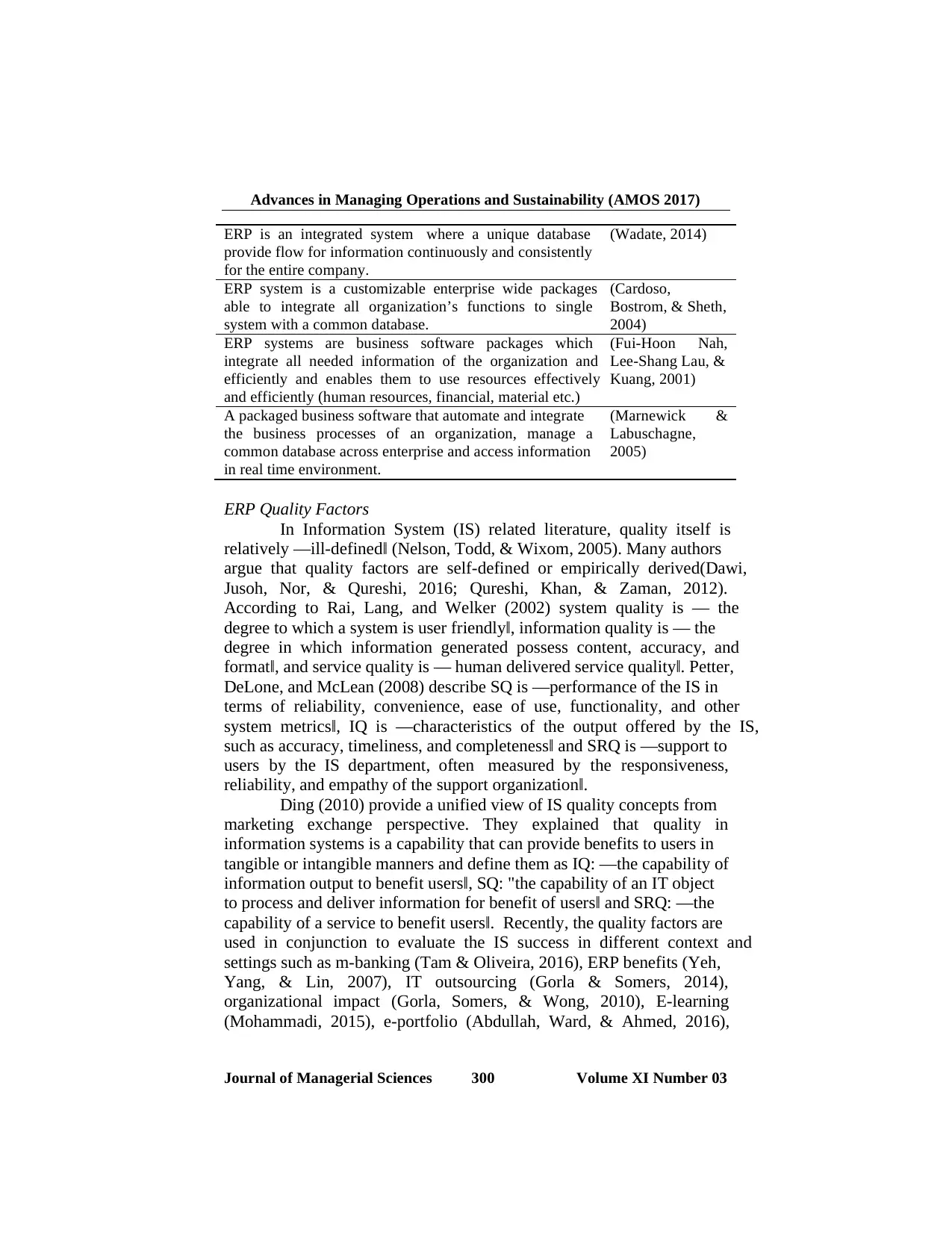
Advances in Managing Operations and Sustainability (AMOS 2017)
Journal of Managerial Sciences 300 Volume XI Number 03
ERP is an integrated system where a unique database
provide flow for information continuously and consistently
for the entire company.
(Wadate, 2014)
ERP system is a customizable enterprise wide packages
able to integrate all organization’s functions to single
system with a common database.
(Cardoso,
Bostrom, & Sheth,
2004)
ERP systems are business software packages which
integrate all needed information of the organization and
efficiently and enables them to use resources effectively
and efficiently (human resources, financial, material etc.)
(Fui-Hoon Nah,
Lee-Shang Lau, &
Kuang, 2001)
A packaged business software that automate and integrate
the business processes of an organization, manage a
common database across enterprise and access information
in real time environment.
(Marnewick &
Labuschagne,
2005)
ERP Quality Factors
In Information System (IS) related literature, quality itself is
relatively ―ill-defined‖ (Nelson, Todd, & Wixom, 2005). Many authors
argue that quality factors are self-defined or empirically derived(Dawi,
Jusoh, Nor, & Qureshi, 2016; Qureshi, Khan, & Zaman, 2012).
According to Rai, Lang, and Welker (2002) system quality is ― the
degree to which a system is user friendly‖, information quality is ― the
degree in which information generated possess content, accuracy, and
format‖, and service quality is ― human delivered service quality‖. Petter,
DeLone, and McLean (2008) describe SQ is ―performance of the IS in
terms of reliability, convenience, ease of use, functionality, and other
system metrics‖, IQ is ―characteristics of the output offered by the IS,
such as accuracy, timeliness, and completeness‖ and SRQ is ―support to
users by the IS department, often measured by the responsiveness,
reliability, and empathy of the support organization‖.
Ding (2010) provide a unified view of IS quality concepts from
marketing exchange perspective. They explained that quality in
information systems is a capability that can provide benefits to users in
tangible or intangible manners and define them as IQ: ―the capability of
information output to benefit users‖, SQ: "the capability of an IT object
to process and deliver information for benefit of users‖ and SRQ: ―the
capability of a service to benefit users‖. Recently, the quality factors are
used in conjunction to evaluate the IS success in different context and
settings such as m-banking (Tam & Oliveira, 2016), ERP benefits (Yeh,
Yang, & Lin, 2007), IT outsourcing (Gorla & Somers, 2014),
organizational impact (Gorla, Somers, & Wong, 2010), E-learning
(Mohammadi, 2015), e-portfolio (Abdullah, Ward, & Ahmed, 2016),
Journal of Managerial Sciences 300 Volume XI Number 03
ERP is an integrated system where a unique database
provide flow for information continuously and consistently
for the entire company.
(Wadate, 2014)
ERP system is a customizable enterprise wide packages
able to integrate all organization’s functions to single
system with a common database.
(Cardoso,
Bostrom, & Sheth,
2004)
ERP systems are business software packages which
integrate all needed information of the organization and
efficiently and enables them to use resources effectively
and efficiently (human resources, financial, material etc.)
(Fui-Hoon Nah,
Lee-Shang Lau, &
Kuang, 2001)
A packaged business software that automate and integrate
the business processes of an organization, manage a
common database across enterprise and access information
in real time environment.
(Marnewick &
Labuschagne,
2005)
ERP Quality Factors
In Information System (IS) related literature, quality itself is
relatively ―ill-defined‖ (Nelson, Todd, & Wixom, 2005). Many authors
argue that quality factors are self-defined or empirically derived(Dawi,
Jusoh, Nor, & Qureshi, 2016; Qureshi, Khan, & Zaman, 2012).
According to Rai, Lang, and Welker (2002) system quality is ― the
degree to which a system is user friendly‖, information quality is ― the
degree in which information generated possess content, accuracy, and
format‖, and service quality is ― human delivered service quality‖. Petter,
DeLone, and McLean (2008) describe SQ is ―performance of the IS in
terms of reliability, convenience, ease of use, functionality, and other
system metrics‖, IQ is ―characteristics of the output offered by the IS,
such as accuracy, timeliness, and completeness‖ and SRQ is ―support to
users by the IS department, often measured by the responsiveness,
reliability, and empathy of the support organization‖.
Ding (2010) provide a unified view of IS quality concepts from
marketing exchange perspective. They explained that quality in
information systems is a capability that can provide benefits to users in
tangible or intangible manners and define them as IQ: ―the capability of
information output to benefit users‖, SQ: "the capability of an IT object
to process and deliver information for benefit of users‖ and SRQ: ―the
capability of a service to benefit users‖. Recently, the quality factors are
used in conjunction to evaluate the IS success in different context and
settings such as m-banking (Tam & Oliveira, 2016), ERP benefits (Yeh,
Yang, & Lin, 2007), IT outsourcing (Gorla & Somers, 2014),
organizational impact (Gorla, Somers, & Wong, 2010), E-learning
(Mohammadi, 2015), e-portfolio (Abdullah, Ward, & Ahmed, 2016),
Secure Best Marks with AI Grader
Need help grading? Try our AI Grader for instant feedback on your assignments.
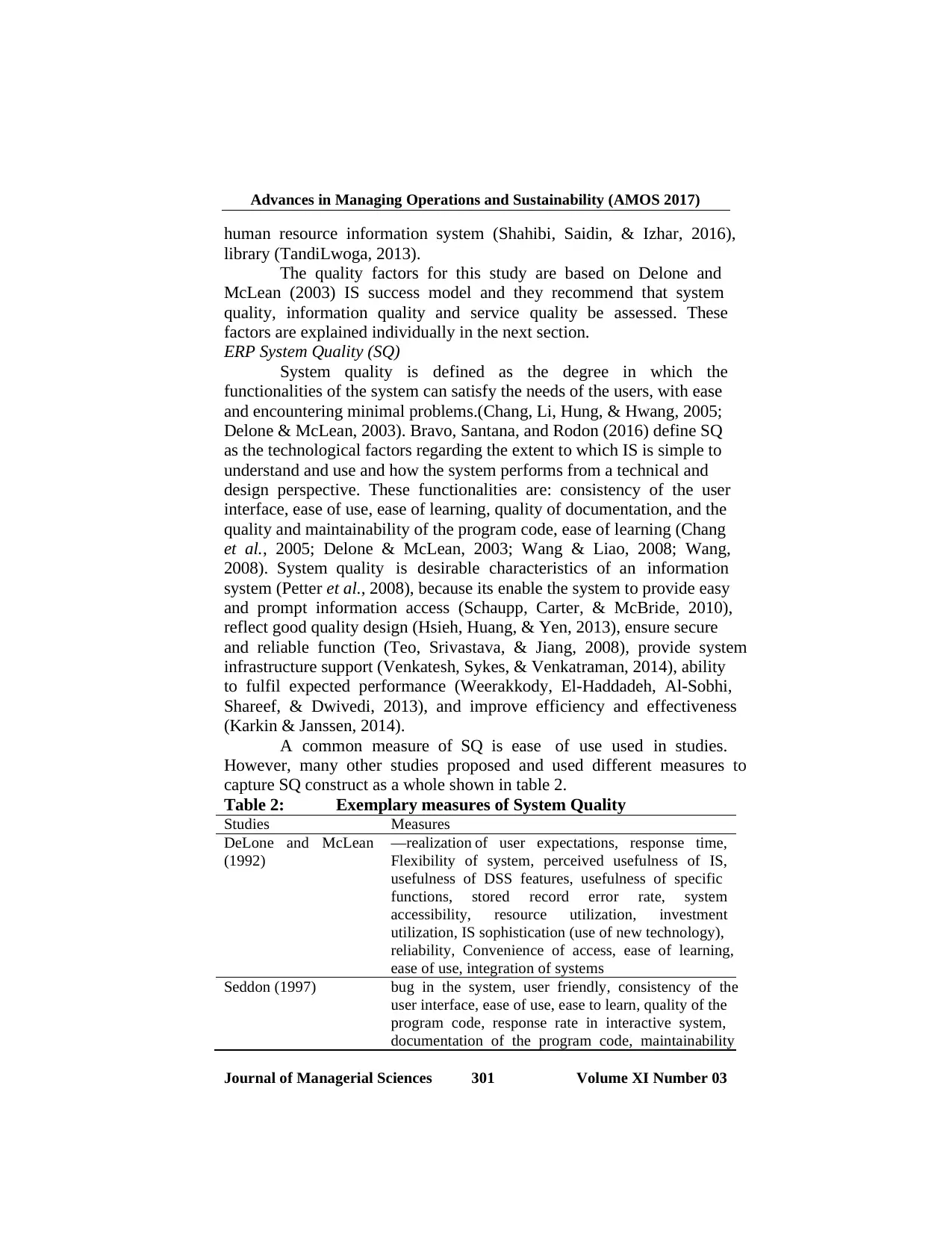
Advances in Managing Operations and Sustainability (AMOS 2017)
Journal of Managerial Sciences 301 Volume XI Number 03
human resource information system (Shahibi, Saidin, & Izhar, 2016),
library (TandiLwoga, 2013).
The quality factors for this study are based on Delone and
McLean (2003) IS success model and they recommend that system
quality, information quality and service quality be assessed. These
factors are explained individually in the next section.
ERP System Quality (SQ)
System quality is defined as the degree in which the
functionalities of the system can satisfy the needs of the users, with ease
and encountering minimal problems.(Chang, Li, Hung, & Hwang, 2005;
Delone & McLean, 2003). Bravo, Santana, and Rodon (2016) define SQ
as the technological factors regarding the extent to which IS is simple to
understand and use and how the system performs from a technical and
design perspective. These functionalities are: consistency of the user
interface, ease of use, ease of learning, quality of documentation, and the
quality and maintainability of the program code, ease of learning (Chang
et al., 2005; Delone & McLean, 2003; Wang & Liao, 2008; Wang,
2008). System quality is desirable characteristics of an information
system (Petter et al., 2008), because its enable the system to provide easy
and prompt information access (Schaupp, Carter, & McBride, 2010),
reflect good quality design (Hsieh, Huang, & Yen, 2013), ensure secure
and reliable function (Teo, Srivastava, & Jiang, 2008), provide system
infrastructure support (Venkatesh, Sykes, & Venkatraman, 2014), ability
to fulfil expected performance (Weerakkody, El-Haddadeh, Al-Sobhi,
Shareef, & Dwivedi, 2013), and improve efficiency and effectiveness
(Karkin & Janssen, 2014).
A common measure of SQ is ease of use used in studies.
However, many other studies proposed and used different measures to
capture SQ construct as a whole shown in table 2.
Table 2: Exemplary measures of System Quality
Studies Measures
DeLone and McLean
(1992)
―realization of user expectations, response time,
Flexibility of system, perceived usefulness of IS,
usefulness of DSS features, usefulness of specific
functions, stored record error rate, system
accessibility, resource utilization, investment
utilization, IS sophistication (use of new technology),
reliability, Convenience of access, ease of learning,
ease of use, integration of systems
Seddon (1997) bug in the system, user friendly, consistency of the
user interface, ease of use, ease to learn, quality of the
program code, response rate in interactive system,
documentation of the program code, maintainability
Journal of Managerial Sciences 301 Volume XI Number 03
human resource information system (Shahibi, Saidin, & Izhar, 2016),
library (TandiLwoga, 2013).
The quality factors for this study are based on Delone and
McLean (2003) IS success model and they recommend that system
quality, information quality and service quality be assessed. These
factors are explained individually in the next section.
ERP System Quality (SQ)
System quality is defined as the degree in which the
functionalities of the system can satisfy the needs of the users, with ease
and encountering minimal problems.(Chang, Li, Hung, & Hwang, 2005;
Delone & McLean, 2003). Bravo, Santana, and Rodon (2016) define SQ
as the technological factors regarding the extent to which IS is simple to
understand and use and how the system performs from a technical and
design perspective. These functionalities are: consistency of the user
interface, ease of use, ease of learning, quality of documentation, and the
quality and maintainability of the program code, ease of learning (Chang
et al., 2005; Delone & McLean, 2003; Wang & Liao, 2008; Wang,
2008). System quality is desirable characteristics of an information
system (Petter et al., 2008), because its enable the system to provide easy
and prompt information access (Schaupp, Carter, & McBride, 2010),
reflect good quality design (Hsieh, Huang, & Yen, 2013), ensure secure
and reliable function (Teo, Srivastava, & Jiang, 2008), provide system
infrastructure support (Venkatesh, Sykes, & Venkatraman, 2014), ability
to fulfil expected performance (Weerakkody, El-Haddadeh, Al-Sobhi,
Shareef, & Dwivedi, 2013), and improve efficiency and effectiveness
(Karkin & Janssen, 2014).
A common measure of SQ is ease of use used in studies.
However, many other studies proposed and used different measures to
capture SQ construct as a whole shown in table 2.
Table 2: Exemplary measures of System Quality
Studies Measures
DeLone and McLean
(1992)
―realization of user expectations, response time,
Flexibility of system, perceived usefulness of IS,
usefulness of DSS features, usefulness of specific
functions, stored record error rate, system
accessibility, resource utilization, investment
utilization, IS sophistication (use of new technology),
reliability, Convenience of access, ease of learning,
ease of use, integration of systems
Seddon (1997) bug in the system, user friendly, consistency of the
user interface, ease of use, ease to learn, quality of the
program code, response rate in interactive system,
documentation of the program code, maintainability
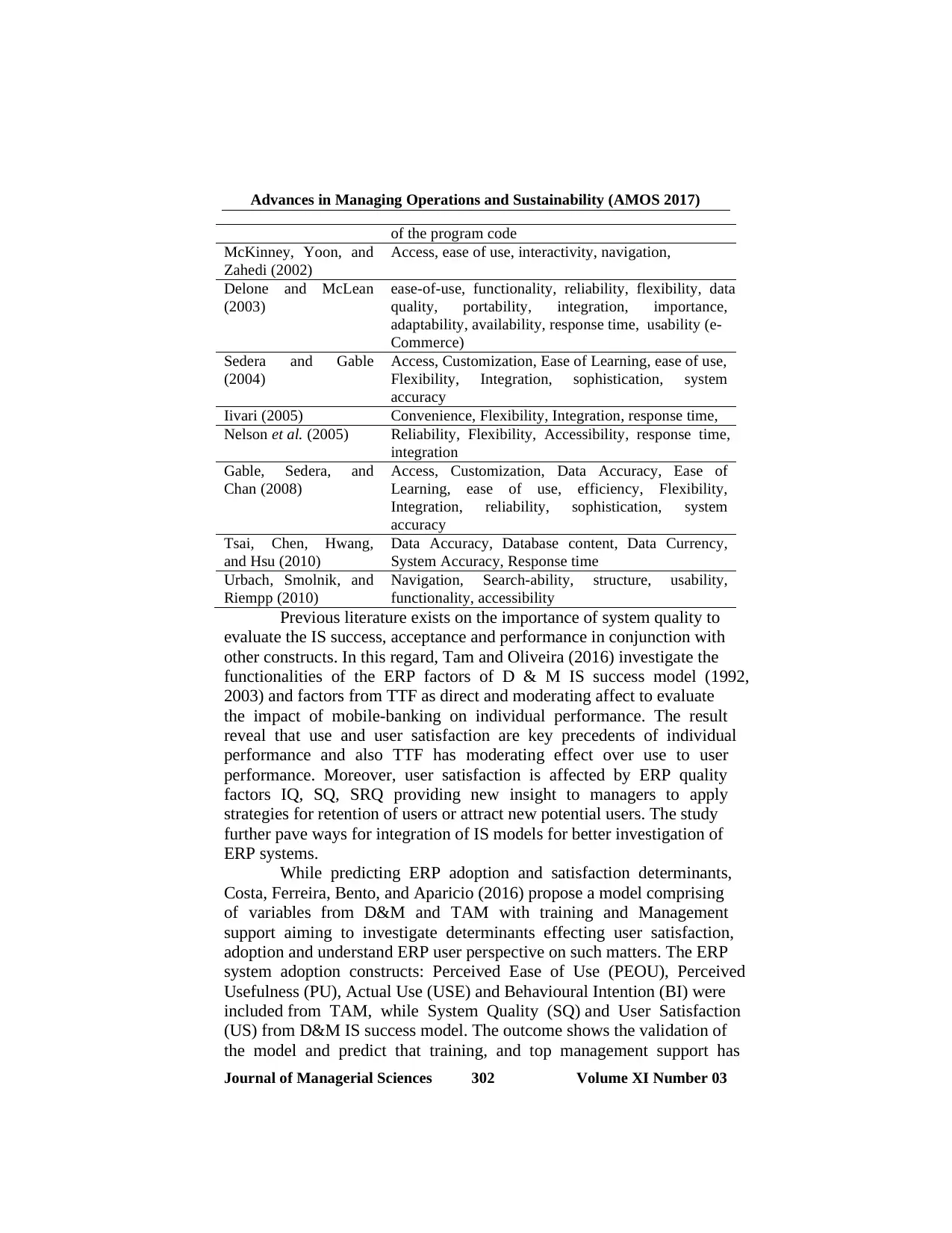
Advances in Managing Operations and Sustainability (AMOS 2017)
Journal of Managerial Sciences 302 Volume XI Number 03
of the program code
McKinney, Yoon, and
Zahedi (2002)
Access, ease of use, interactivity, navigation,
Delone and McLean
(2003)
ease-of-use, functionality, reliability, flexibility, data
quality, portability, integration, importance,
adaptability, availability, response time, usability (e-
Commerce)
Sedera and Gable
(2004)
Access, Customization, Ease of Learning, ease of use,
Flexibility, Integration, sophistication, system
accuracy
Iivari (2005) Convenience, Flexibility, Integration, response time,
Nelson et al. (2005) Reliability, Flexibility, Accessibility, response time,
integration
Gable, Sedera, and
Chan (2008)
Access, Customization, Data Accuracy, Ease of
Learning, ease of use, efficiency, Flexibility,
Integration, reliability, sophistication, system
accuracy
Tsai, Chen, Hwang,
and Hsu (2010)
Data Accuracy, Database content, Data Currency,
System Accuracy, Response time
Urbach, Smolnik, and
Riempp (2010)
Navigation, Search-ability, structure, usability,
functionality, accessibility
Previous literature exists on the importance of system quality to
evaluate the IS success, acceptance and performance in conjunction with
other constructs. In this regard, Tam and Oliveira (2016) investigate the
functionalities of the ERP factors of D & M IS success model (1992,
2003) and factors from TTF as direct and moderating affect to evaluate
the impact of mobile-banking on individual performance. The result
reveal that use and user satisfaction are key precedents of individual
performance and also TTF has moderating effect over use to user
performance. Moreover, user satisfaction is affected by ERP quality
factors IQ, SQ, SRQ providing new insight to managers to apply
strategies for retention of users or attract new potential users. The study
further pave ways for integration of IS models for better investigation of
ERP systems.
While predicting ERP adoption and satisfaction determinants,
Costa, Ferreira, Bento, and Aparicio (2016) propose a model comprising
of variables from D&M and TAM with training and Management
support aiming to investigate determinants effecting user satisfaction,
adoption and understand ERP user perspective on such matters. The ERP
system adoption constructs: Perceived Ease of Use (PEOU), Perceived
Usefulness (PU), Actual Use (USE) and Behavioural Intention (BI) were
included from TAM, while System Quality (SQ) and User Satisfaction
(US) from D&M IS success model. The outcome shows the validation of
the model and predict that training, and top management support has
Journal of Managerial Sciences 302 Volume XI Number 03
of the program code
McKinney, Yoon, and
Zahedi (2002)
Access, ease of use, interactivity, navigation,
Delone and McLean
(2003)
ease-of-use, functionality, reliability, flexibility, data
quality, portability, integration, importance,
adaptability, availability, response time, usability (e-
Commerce)
Sedera and Gable
(2004)
Access, Customization, Ease of Learning, ease of use,
Flexibility, Integration, sophistication, system
accuracy
Iivari (2005) Convenience, Flexibility, Integration, response time,
Nelson et al. (2005) Reliability, Flexibility, Accessibility, response time,
integration
Gable, Sedera, and
Chan (2008)
Access, Customization, Data Accuracy, Ease of
Learning, ease of use, efficiency, Flexibility,
Integration, reliability, sophistication, system
accuracy
Tsai, Chen, Hwang,
and Hsu (2010)
Data Accuracy, Database content, Data Currency,
System Accuracy, Response time
Urbach, Smolnik, and
Riempp (2010)
Navigation, Search-ability, structure, usability,
functionality, accessibility
Previous literature exists on the importance of system quality to
evaluate the IS success, acceptance and performance in conjunction with
other constructs. In this regard, Tam and Oliveira (2016) investigate the
functionalities of the ERP factors of D & M IS success model (1992,
2003) and factors from TTF as direct and moderating affect to evaluate
the impact of mobile-banking on individual performance. The result
reveal that use and user satisfaction are key precedents of individual
performance and also TTF has moderating effect over use to user
performance. Moreover, user satisfaction is affected by ERP quality
factors IQ, SQ, SRQ providing new insight to managers to apply
strategies for retention of users or attract new potential users. The study
further pave ways for integration of IS models for better investigation of
ERP systems.
While predicting ERP adoption and satisfaction determinants,
Costa, Ferreira, Bento, and Aparicio (2016) propose a model comprising
of variables from D&M and TAM with training and Management
support aiming to investigate determinants effecting user satisfaction,
adoption and understand ERP user perspective on such matters. The ERP
system adoption constructs: Perceived Ease of Use (PEOU), Perceived
Usefulness (PU), Actual Use (USE) and Behavioural Intention (BI) were
included from TAM, while System Quality (SQ) and User Satisfaction
(US) from D&M IS success model. The outcome shows the validation of
the model and predict that training, and top management support has
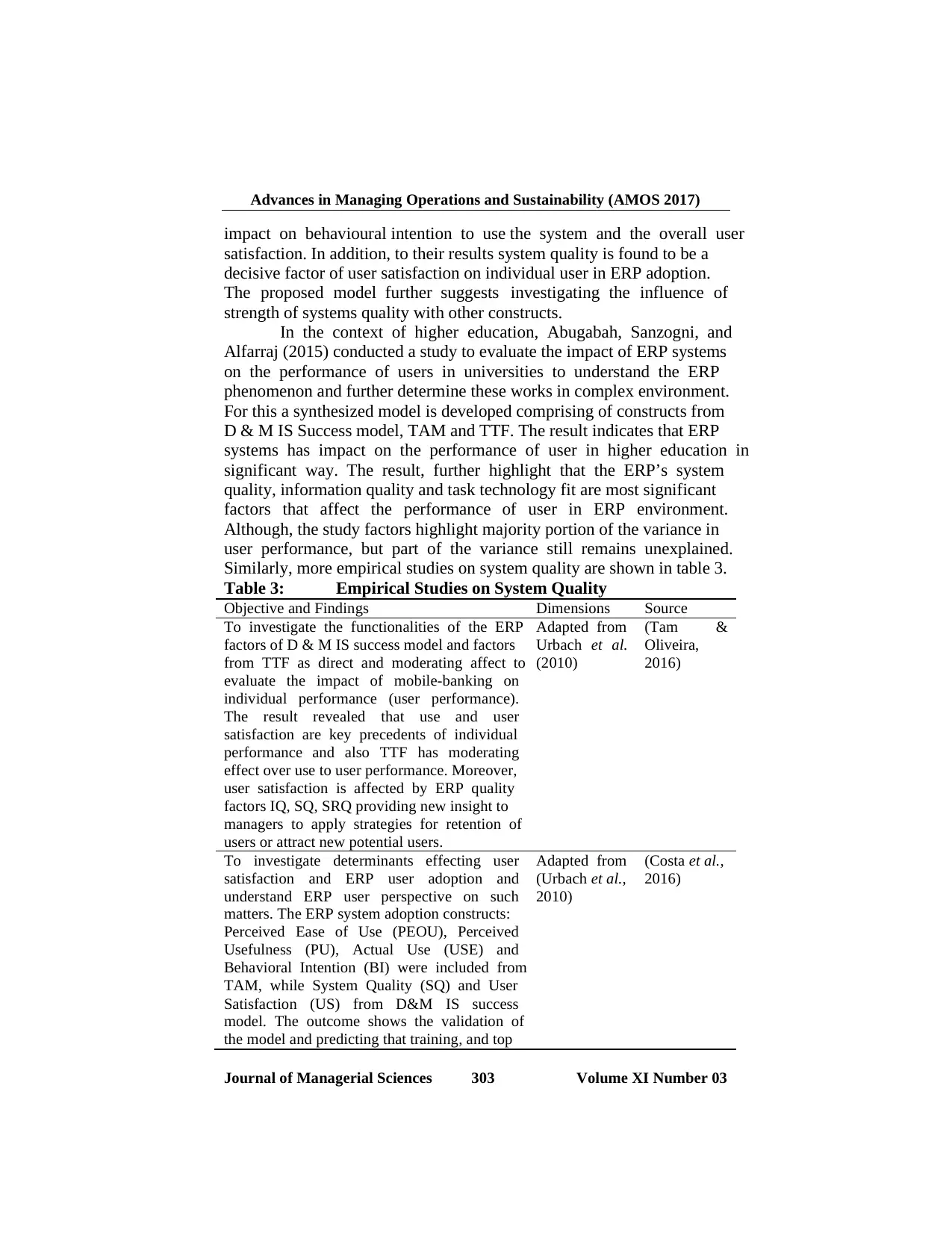
Advances in Managing Operations and Sustainability (AMOS 2017)
Journal of Managerial Sciences 303 Volume XI Number 03
impact on behavioural intention to use the system and the overall user
satisfaction. In addition, to their results system quality is found to be a
decisive factor of user satisfaction on individual user in ERP adoption.
The proposed model further suggests investigating the influence of
strength of systems quality with other constructs.
In the context of higher education, Abugabah, Sanzogni, and
Alfarraj (2015) conducted a study to evaluate the impact of ERP systems
on the performance of users in universities to understand the ERP
phenomenon and further determine these works in complex environment.
For this a synthesized model is developed comprising of constructs from
D & M IS Success model, TAM and TTF. The result indicates that ERP
systems has impact on the performance of user in higher education in
significant way. The result, further highlight that the ERP’s system
quality, information quality and task technology fit are most significant
factors that affect the performance of user in ERP environment.
Although, the study factors highlight majority portion of the variance in
user performance, but part of the variance still remains unexplained.
Similarly, more empirical studies on system quality are shown in table 3.
Table 3: Empirical Studies on System Quality
Objective and Findings Dimensions Source
To investigate the functionalities of the ERP
factors of D & M IS success model and factors
from TTF as direct and moderating affect to
evaluate the impact of mobile-banking on
individual performance (user performance).
The result revealed that use and user
satisfaction are key precedents of individual
performance and also TTF has moderating
effect over use to user performance. Moreover,
user satisfaction is affected by ERP quality
factors IQ, SQ, SRQ providing new insight to
managers to apply strategies for retention of
users or attract new potential users.
Adapted from
Urbach et al.
(2010)
(Tam &
Oliveira,
2016)
To investigate determinants effecting user
satisfaction and ERP user adoption and
understand ERP user perspective on such
matters. The ERP system adoption constructs:
Perceived Ease of Use (PEOU), Perceived
Usefulness (PU), Actual Use (USE) and
Behavioral Intention (BI) were included from
TAM, while System Quality (SQ) and User
Satisfaction (US) from D&M IS success
model. The outcome shows the validation of
the model and predicting that training, and top
Adapted from
(Urbach et al.,
2010)
(Costa et al.,
2016)
Journal of Managerial Sciences 303 Volume XI Number 03
impact on behavioural intention to use the system and the overall user
satisfaction. In addition, to their results system quality is found to be a
decisive factor of user satisfaction on individual user in ERP adoption.
The proposed model further suggests investigating the influence of
strength of systems quality with other constructs.
In the context of higher education, Abugabah, Sanzogni, and
Alfarraj (2015) conducted a study to evaluate the impact of ERP systems
on the performance of users in universities to understand the ERP
phenomenon and further determine these works in complex environment.
For this a synthesized model is developed comprising of constructs from
D & M IS Success model, TAM and TTF. The result indicates that ERP
systems has impact on the performance of user in higher education in
significant way. The result, further highlight that the ERP’s system
quality, information quality and task technology fit are most significant
factors that affect the performance of user in ERP environment.
Although, the study factors highlight majority portion of the variance in
user performance, but part of the variance still remains unexplained.
Similarly, more empirical studies on system quality are shown in table 3.
Table 3: Empirical Studies on System Quality
Objective and Findings Dimensions Source
To investigate the functionalities of the ERP
factors of D & M IS success model and factors
from TTF as direct and moderating affect to
evaluate the impact of mobile-banking on
individual performance (user performance).
The result revealed that use and user
satisfaction are key precedents of individual
performance and also TTF has moderating
effect over use to user performance. Moreover,
user satisfaction is affected by ERP quality
factors IQ, SQ, SRQ providing new insight to
managers to apply strategies for retention of
users or attract new potential users.
Adapted from
Urbach et al.
(2010)
(Tam &
Oliveira,
2016)
To investigate determinants effecting user
satisfaction and ERP user adoption and
understand ERP user perspective on such
matters. The ERP system adoption constructs:
Perceived Ease of Use (PEOU), Perceived
Usefulness (PU), Actual Use (USE) and
Behavioral Intention (BI) were included from
TAM, while System Quality (SQ) and User
Satisfaction (US) from D&M IS success
model. The outcome shows the validation of
the model and predicting that training, and top
Adapted from
(Urbach et al.,
2010)
(Costa et al.,
2016)
Paraphrase This Document
Need a fresh take? Get an instant paraphrase of this document with our AI Paraphraser
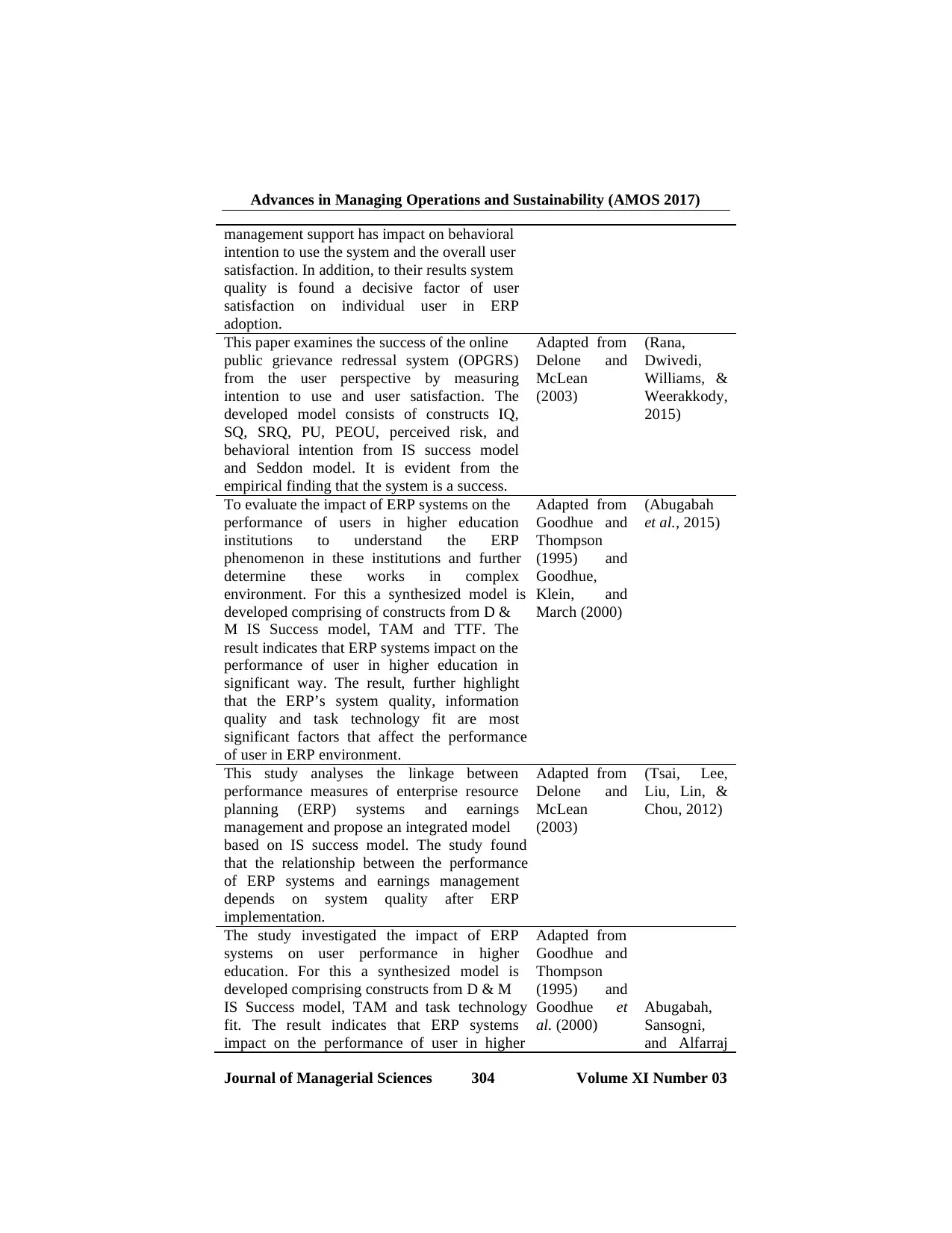
Advances in Managing Operations and Sustainability (AMOS 2017)
Journal of Managerial Sciences 304 Volume XI Number 03
management support has impact on behavioral
intention to use the system and the overall user
satisfaction. In addition, to their results system
quality is found a decisive factor of user
satisfaction on individual user in ERP
adoption.
This paper examines the success of the online
public grievance redressal system (OPGRS)
from the user perspective by measuring
intention to use and user satisfaction. The
developed model consists of constructs IQ,
SQ, SRQ, PU, PEOU, perceived risk, and
behavioral intention from IS success model
and Seddon model. It is evident from the
empirical finding that the system is a success.
Adapted from
Delone and
McLean
(2003)
(Rana,
Dwivedi,
Williams, &
Weerakkody,
2015)
To evaluate the impact of ERP systems on the
performance of users in higher education
institutions to understand the ERP
phenomenon in these institutions and further
determine these works in complex
environment. For this a synthesized model is
developed comprising of constructs from D &
M IS Success model, TAM and TTF. The
result indicates that ERP systems impact on the
performance of user in higher education in
significant way. The result, further highlight
that the ERP’s system quality, information
quality and task technology fit are most
significant factors that affect the performance
of user in ERP environment.
Adapted from
Goodhue and
Thompson
(1995) and
Goodhue,
Klein, and
March (2000)
(Abugabah
et al., 2015)
This study analyses the linkage between
performance measures of enterprise resource
planning (ERP) systems and earnings
management and propose an integrated model
based on IS success model. The study found
that the relationship between the performance
of ERP systems and earnings management
depends on system quality after ERP
implementation.
Adapted from
Delone and
McLean
(2003)
(Tsai, Lee,
Liu, Lin, &
Chou, 2012)
The study investigated the impact of ERP
systems on user performance in higher
education. For this a synthesized model is
developed comprising constructs from D & M
IS Success model, TAM and task technology
fit. The result indicates that ERP systems
impact on the performance of user in higher
Adapted from
Goodhue and
Thompson
(1995) and
Goodhue et
al. (2000)
Abugabah,
Sansogni,
and Alfarraj
Journal of Managerial Sciences 304 Volume XI Number 03
management support has impact on behavioral
intention to use the system and the overall user
satisfaction. In addition, to their results system
quality is found a decisive factor of user
satisfaction on individual user in ERP
adoption.
This paper examines the success of the online
public grievance redressal system (OPGRS)
from the user perspective by measuring
intention to use and user satisfaction. The
developed model consists of constructs IQ,
SQ, SRQ, PU, PEOU, perceived risk, and
behavioral intention from IS success model
and Seddon model. It is evident from the
empirical finding that the system is a success.
Adapted from
Delone and
McLean
(2003)
(Rana,
Dwivedi,
Williams, &
Weerakkody,
2015)
To evaluate the impact of ERP systems on the
performance of users in higher education
institutions to understand the ERP
phenomenon in these institutions and further
determine these works in complex
environment. For this a synthesized model is
developed comprising of constructs from D &
M IS Success model, TAM and TTF. The
result indicates that ERP systems impact on the
performance of user in higher education in
significant way. The result, further highlight
that the ERP’s system quality, information
quality and task technology fit are most
significant factors that affect the performance
of user in ERP environment.
Adapted from
Goodhue and
Thompson
(1995) and
Goodhue,
Klein, and
March (2000)
(Abugabah
et al., 2015)
This study analyses the linkage between
performance measures of enterprise resource
planning (ERP) systems and earnings
management and propose an integrated model
based on IS success model. The study found
that the relationship between the performance
of ERP systems and earnings management
depends on system quality after ERP
implementation.
Adapted from
Delone and
McLean
(2003)
(Tsai, Lee,
Liu, Lin, &
Chou, 2012)
The study investigated the impact of ERP
systems on user performance in higher
education. For this a synthesized model is
developed comprising constructs from D & M
IS Success model, TAM and task technology
fit. The result indicates that ERP systems
impact on the performance of user in higher
Adapted from
Goodhue and
Thompson
(1995) and
Goodhue et
al. (2000)
Abugabah,
Sansogni,
and Alfarraj
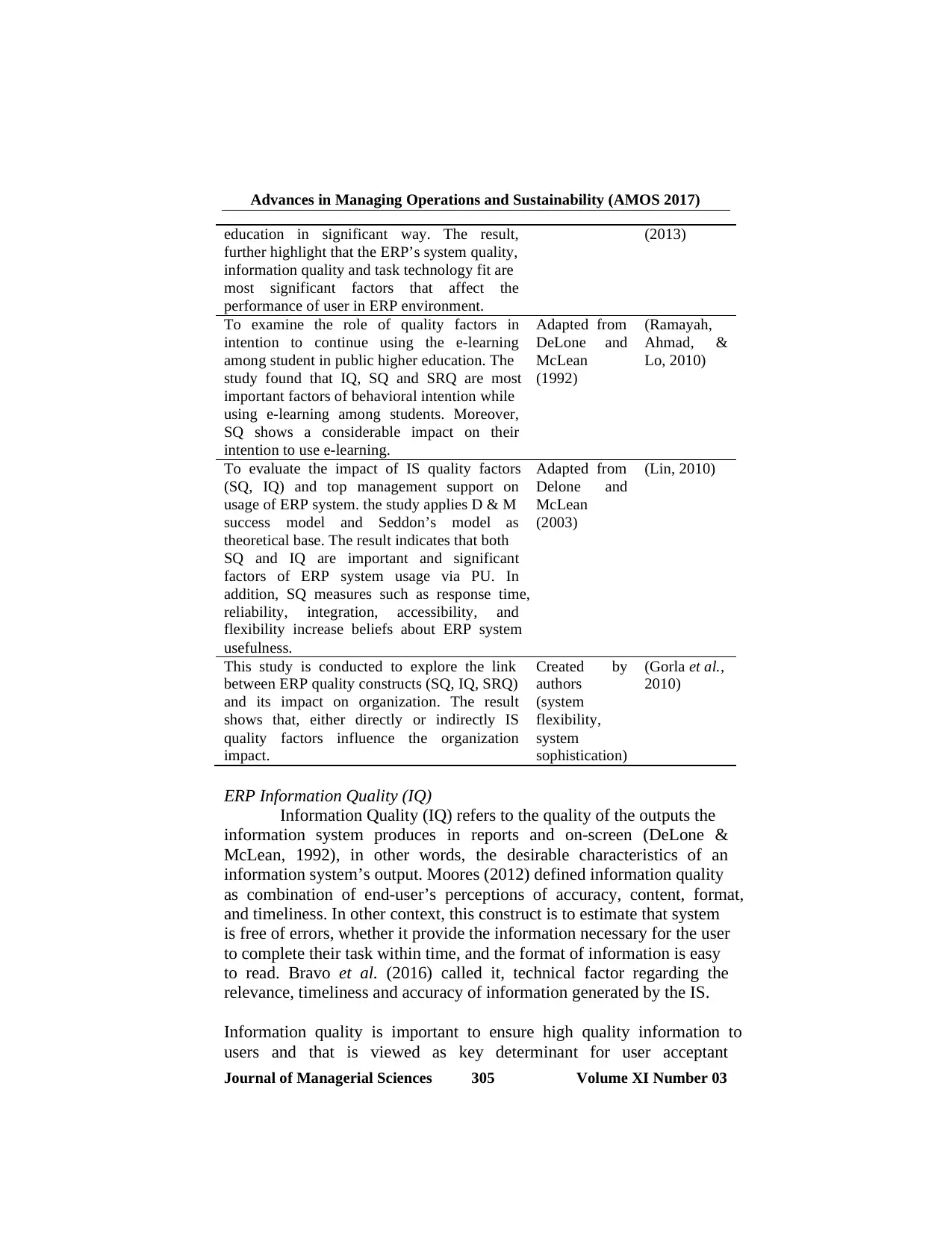
Advances in Managing Operations and Sustainability (AMOS 2017)
Journal of Managerial Sciences 305 Volume XI Number 03
education in significant way. The result,
further highlight that the ERP’s system quality,
information quality and task technology fit are
most significant factors that affect the
performance of user in ERP environment.
(2013)
To examine the role of quality factors in
intention to continue using the e-learning
among student in public higher education. The
study found that IQ, SQ and SRQ are most
important factors of behavioral intention while
using e-learning among students. Moreover,
SQ shows a considerable impact on their
intention to use e-learning.
Adapted from
DeLone and
McLean
(1992)
(Ramayah,
Ahmad, &
Lo, 2010)
To evaluate the impact of IS quality factors
(SQ, IQ) and top management support on
usage of ERP system. the study applies D & M
success model and Seddon’s model as
theoretical base. The result indicates that both
SQ and IQ are important and significant
factors of ERP system usage via PU. In
addition, SQ measures such as response time,
reliability, integration, accessibility, and
flexibility increase beliefs about ERP system
usefulness.
Adapted from
Delone and
McLean
(2003)
(Lin, 2010)
This study is conducted to explore the link
between ERP quality constructs (SQ, IQ, SRQ)
and its impact on organization. The result
shows that, either directly or indirectly IS
quality factors influence the organization
impact.
Created by
authors
(system
flexibility,
system
sophistication)
(Gorla et al.,
2010)
ERP Information Quality (IQ)
Information Quality (IQ) refers to the quality of the outputs the
information system produces in reports and on-screen (DeLone &
McLean, 1992), in other words, the desirable characteristics of an
information system’s output. Moores (2012) defined information quality
as combination of end-user’s perceptions of accuracy, content, format,
and timeliness. In other context, this construct is to estimate that system
is free of errors, whether it provide the information necessary for the user
to complete their task within time, and the format of information is easy
to read. Bravo et al. (2016) called it, technical factor regarding the
relevance, timeliness and accuracy of information generated by the IS.
Information quality is important to ensure high quality information to
users and that is viewed as key determinant for user acceptant
Journal of Managerial Sciences 305 Volume XI Number 03
education in significant way. The result,
further highlight that the ERP’s system quality,
information quality and task technology fit are
most significant factors that affect the
performance of user in ERP environment.
(2013)
To examine the role of quality factors in
intention to continue using the e-learning
among student in public higher education. The
study found that IQ, SQ and SRQ are most
important factors of behavioral intention while
using e-learning among students. Moreover,
SQ shows a considerable impact on their
intention to use e-learning.
Adapted from
DeLone and
McLean
(1992)
(Ramayah,
Ahmad, &
Lo, 2010)
To evaluate the impact of IS quality factors
(SQ, IQ) and top management support on
usage of ERP system. the study applies D & M
success model and Seddon’s model as
theoretical base. The result indicates that both
SQ and IQ are important and significant
factors of ERP system usage via PU. In
addition, SQ measures such as response time,
reliability, integration, accessibility, and
flexibility increase beliefs about ERP system
usefulness.
Adapted from
Delone and
McLean
(2003)
(Lin, 2010)
This study is conducted to explore the link
between ERP quality constructs (SQ, IQ, SRQ)
and its impact on organization. The result
shows that, either directly or indirectly IS
quality factors influence the organization
impact.
Created by
authors
(system
flexibility,
system
sophistication)
(Gorla et al.,
2010)
ERP Information Quality (IQ)
Information Quality (IQ) refers to the quality of the outputs the
information system produces in reports and on-screen (DeLone &
McLean, 1992), in other words, the desirable characteristics of an
information system’s output. Moores (2012) defined information quality
as combination of end-user’s perceptions of accuracy, content, format,
and timeliness. In other context, this construct is to estimate that system
is free of errors, whether it provide the information necessary for the user
to complete their task within time, and the format of information is easy
to read. Bravo et al. (2016) called it, technical factor regarding the
relevance, timeliness and accuracy of information generated by the IS.
Information quality is important to ensure high quality information to
users and that is viewed as key determinant for user acceptant
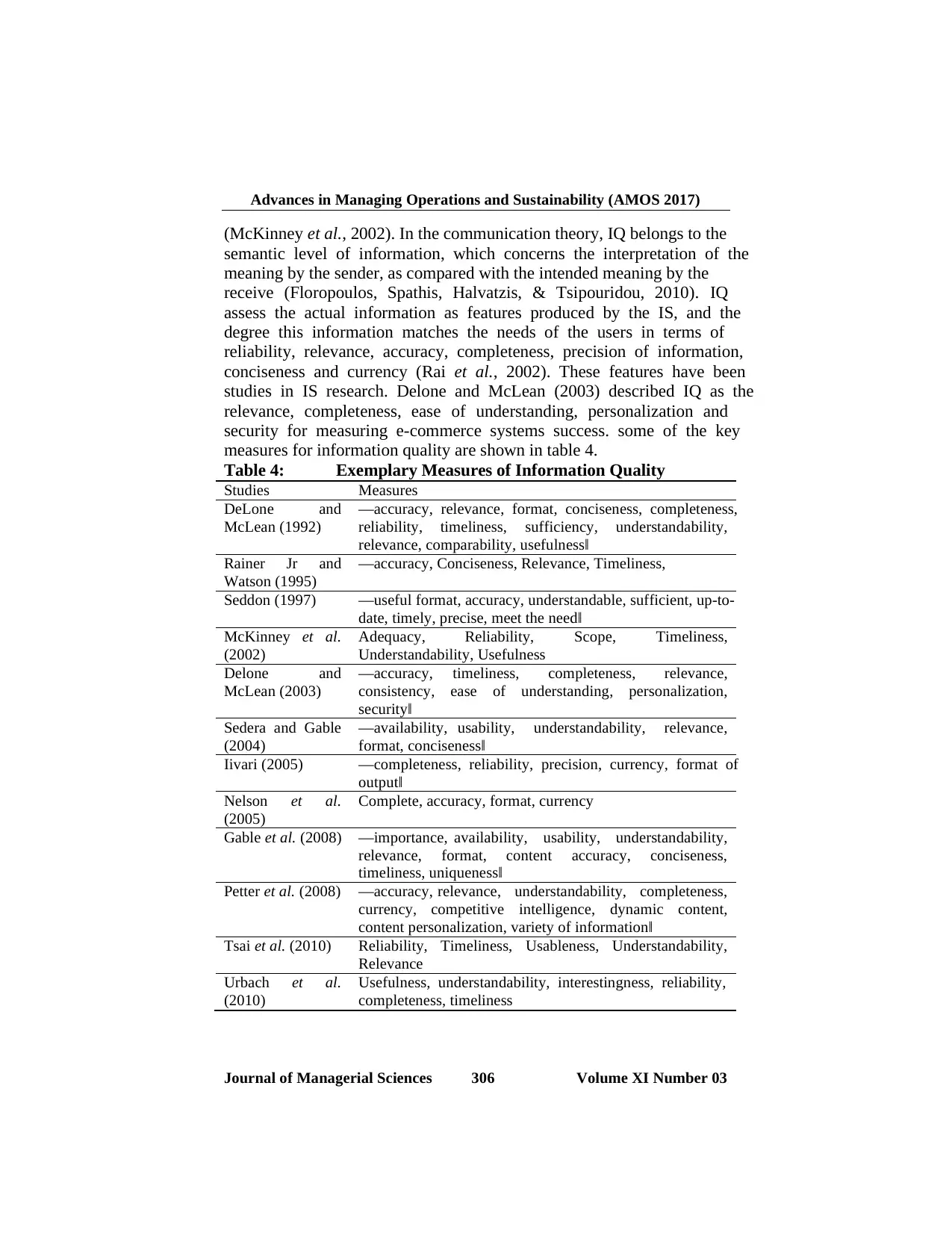
Advances in Managing Operations and Sustainability (AMOS 2017)
Journal of Managerial Sciences 306 Volume XI Number 03
(McKinney et al., 2002). In the communication theory, IQ belongs to the
semantic level of information, which concerns the interpretation of the
meaning by the sender, as compared with the intended meaning by the
receive (Floropoulos, Spathis, Halvatzis, & Tsipouridou, 2010). IQ
assess the actual information as features produced by the IS, and the
degree this information matches the needs of the users in terms of
reliability, relevance, accuracy, completeness, precision of information,
conciseness and currency (Rai et al., 2002). These features have been
studies in IS research. Delone and McLean (2003) described IQ as the
relevance, completeness, ease of understanding, personalization and
security for measuring e-commerce systems success. some of the key
measures for information quality are shown in table 4.
Table 4: Exemplary Measures of Information Quality
Studies Measures
DeLone and
McLean (1992)
―accuracy, relevance, format, conciseness, completeness,
reliability, timeliness, sufficiency, understandability,
relevance, comparability, usefulness‖
Rainer Jr and
Watson (1995)
―accuracy, Conciseness, Relevance, Timeliness,
Seddon (1997) ―useful format, accuracy, understandable, sufficient, up-to-
date, timely, precise, meet the need‖
McKinney et al.
(2002)
Adequacy, Reliability, Scope, Timeliness,
Understandability, Usefulness
Delone and
McLean (2003)
―accuracy, timeliness, completeness, relevance,
consistency, ease of understanding, personalization,
security‖
Sedera and Gable
(2004)
―availability, usability, understandability, relevance,
format, conciseness‖
Iivari (2005) ―completeness, reliability, precision, currency, format of
output‖
Nelson et al.
(2005)
Complete, accuracy, format, currency
Gable et al. (2008) ―importance, availability, usability, understandability,
relevance, format, content accuracy, conciseness,
timeliness, uniqueness‖
Petter et al. (2008) ―accuracy, relevance, understandability, completeness,
currency, competitive intelligence, dynamic content,
content personalization, variety of information‖
Tsai et al. (2010) Reliability, Timeliness, Usableness, Understandability,
Relevance
Urbach et al.
(2010)
Usefulness, understandability, interestingness, reliability,
completeness, timeliness
Journal of Managerial Sciences 306 Volume XI Number 03
(McKinney et al., 2002). In the communication theory, IQ belongs to the
semantic level of information, which concerns the interpretation of the
meaning by the sender, as compared with the intended meaning by the
receive (Floropoulos, Spathis, Halvatzis, & Tsipouridou, 2010). IQ
assess the actual information as features produced by the IS, and the
degree this information matches the needs of the users in terms of
reliability, relevance, accuracy, completeness, precision of information,
conciseness and currency (Rai et al., 2002). These features have been
studies in IS research. Delone and McLean (2003) described IQ as the
relevance, completeness, ease of understanding, personalization and
security for measuring e-commerce systems success. some of the key
measures for information quality are shown in table 4.
Table 4: Exemplary Measures of Information Quality
Studies Measures
DeLone and
McLean (1992)
―accuracy, relevance, format, conciseness, completeness,
reliability, timeliness, sufficiency, understandability,
relevance, comparability, usefulness‖
Rainer Jr and
Watson (1995)
―accuracy, Conciseness, Relevance, Timeliness,
Seddon (1997) ―useful format, accuracy, understandable, sufficient, up-to-
date, timely, precise, meet the need‖
McKinney et al.
(2002)
Adequacy, Reliability, Scope, Timeliness,
Understandability, Usefulness
Delone and
McLean (2003)
―accuracy, timeliness, completeness, relevance,
consistency, ease of understanding, personalization,
security‖
Sedera and Gable
(2004)
―availability, usability, understandability, relevance,
format, conciseness‖
Iivari (2005) ―completeness, reliability, precision, currency, format of
output‖
Nelson et al.
(2005)
Complete, accuracy, format, currency
Gable et al. (2008) ―importance, availability, usability, understandability,
relevance, format, content accuracy, conciseness,
timeliness, uniqueness‖
Petter et al. (2008) ―accuracy, relevance, understandability, completeness,
currency, competitive intelligence, dynamic content,
content personalization, variety of information‖
Tsai et al. (2010) Reliability, Timeliness, Usableness, Understandability,
Relevance
Urbach et al.
(2010)
Usefulness, understandability, interestingness, reliability,
completeness, timeliness
Secure Best Marks with AI Grader
Need help grading? Try our AI Grader for instant feedback on your assignments.
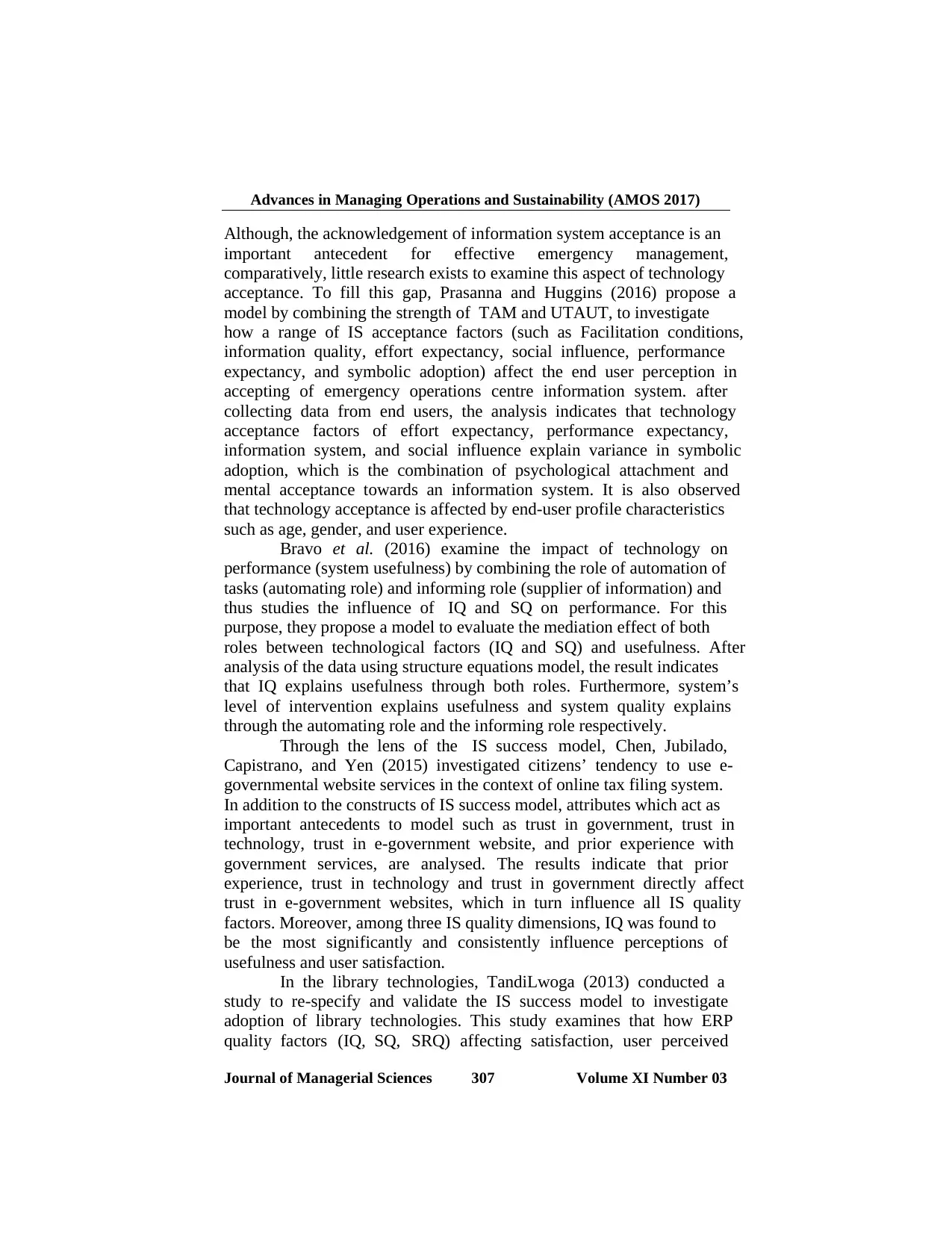
Advances in Managing Operations and Sustainability (AMOS 2017)
Journal of Managerial Sciences 307 Volume XI Number 03
Although, the acknowledgement of information system acceptance is an
important antecedent for effective emergency management,
comparatively, little research exists to examine this aspect of technology
acceptance. To fill this gap, Prasanna and Huggins (2016) propose a
model by combining the strength of TAM and UTAUT, to investigate
how a range of IS acceptance factors (such as Facilitation conditions,
information quality, effort expectancy, social influence, performance
expectancy, and symbolic adoption) affect the end user perception in
accepting of emergency operations centre information system. after
collecting data from end users, the analysis indicates that technology
acceptance factors of effort expectancy, performance expectancy,
information system, and social influence explain variance in symbolic
adoption, which is the combination of psychological attachment and
mental acceptance towards an information system. It is also observed
that technology acceptance is affected by end-user profile characteristics
such as age, gender, and user experience.
Bravo et al. (2016) examine the impact of technology on
performance (system usefulness) by combining the role of automation of
tasks (automating role) and informing role (supplier of information) and
thus studies the influence of IQ and SQ on performance. For this
purpose, they propose a model to evaluate the mediation effect of both
roles between technological factors (IQ and SQ) and usefulness. After
analysis of the data using structure equations model, the result indicates
that IQ explains usefulness through both roles. Furthermore, system’s
level of intervention explains usefulness and system quality explains
through the automating role and the informing role respectively.
Through the lens of the IS success model, Chen, Jubilado,
Capistrano, and Yen (2015) investigated citizens’ tendency to use e-
governmental website services in the context of online tax filing system.
In addition to the constructs of IS success model, attributes which act as
important antecedents to model such as trust in government, trust in
technology, trust in e-government website, and prior experience with
government services, are analysed. The results indicate that prior
experience, trust in technology and trust in government directly affect
trust in e-government websites, which in turn influence all IS quality
factors. Moreover, among three IS quality dimensions, IQ was found to
be the most significantly and consistently influence perceptions of
usefulness and user satisfaction.
In the library technologies, TandiLwoga (2013) conducted a
study to re-specify and validate the IS success model to investigate
adoption of library technologies. This study examines that how ERP
quality factors (IQ, SQ, SRQ) affecting satisfaction, user perceived
Journal of Managerial Sciences 307 Volume XI Number 03
Although, the acknowledgement of information system acceptance is an
important antecedent for effective emergency management,
comparatively, little research exists to examine this aspect of technology
acceptance. To fill this gap, Prasanna and Huggins (2016) propose a
model by combining the strength of TAM and UTAUT, to investigate
how a range of IS acceptance factors (such as Facilitation conditions,
information quality, effort expectancy, social influence, performance
expectancy, and symbolic adoption) affect the end user perception in
accepting of emergency operations centre information system. after
collecting data from end users, the analysis indicates that technology
acceptance factors of effort expectancy, performance expectancy,
information system, and social influence explain variance in symbolic
adoption, which is the combination of psychological attachment and
mental acceptance towards an information system. It is also observed
that technology acceptance is affected by end-user profile characteristics
such as age, gender, and user experience.
Bravo et al. (2016) examine the impact of technology on
performance (system usefulness) by combining the role of automation of
tasks (automating role) and informing role (supplier of information) and
thus studies the influence of IQ and SQ on performance. For this
purpose, they propose a model to evaluate the mediation effect of both
roles between technological factors (IQ and SQ) and usefulness. After
analysis of the data using structure equations model, the result indicates
that IQ explains usefulness through both roles. Furthermore, system’s
level of intervention explains usefulness and system quality explains
through the automating role and the informing role respectively.
Through the lens of the IS success model, Chen, Jubilado,
Capistrano, and Yen (2015) investigated citizens’ tendency to use e-
governmental website services in the context of online tax filing system.
In addition to the constructs of IS success model, attributes which act as
important antecedents to model such as trust in government, trust in
technology, trust in e-government website, and prior experience with
government services, are analysed. The results indicate that prior
experience, trust in technology and trust in government directly affect
trust in e-government websites, which in turn influence all IS quality
factors. Moreover, among three IS quality dimensions, IQ was found to
be the most significantly and consistently influence perceptions of
usefulness and user satisfaction.
In the library technologies, TandiLwoga (2013) conducted a
study to re-specify and validate the IS success model to investigate
adoption of library technologies. This study examines that how ERP
quality factors (IQ, SQ, SRQ) affecting satisfaction, user perceived
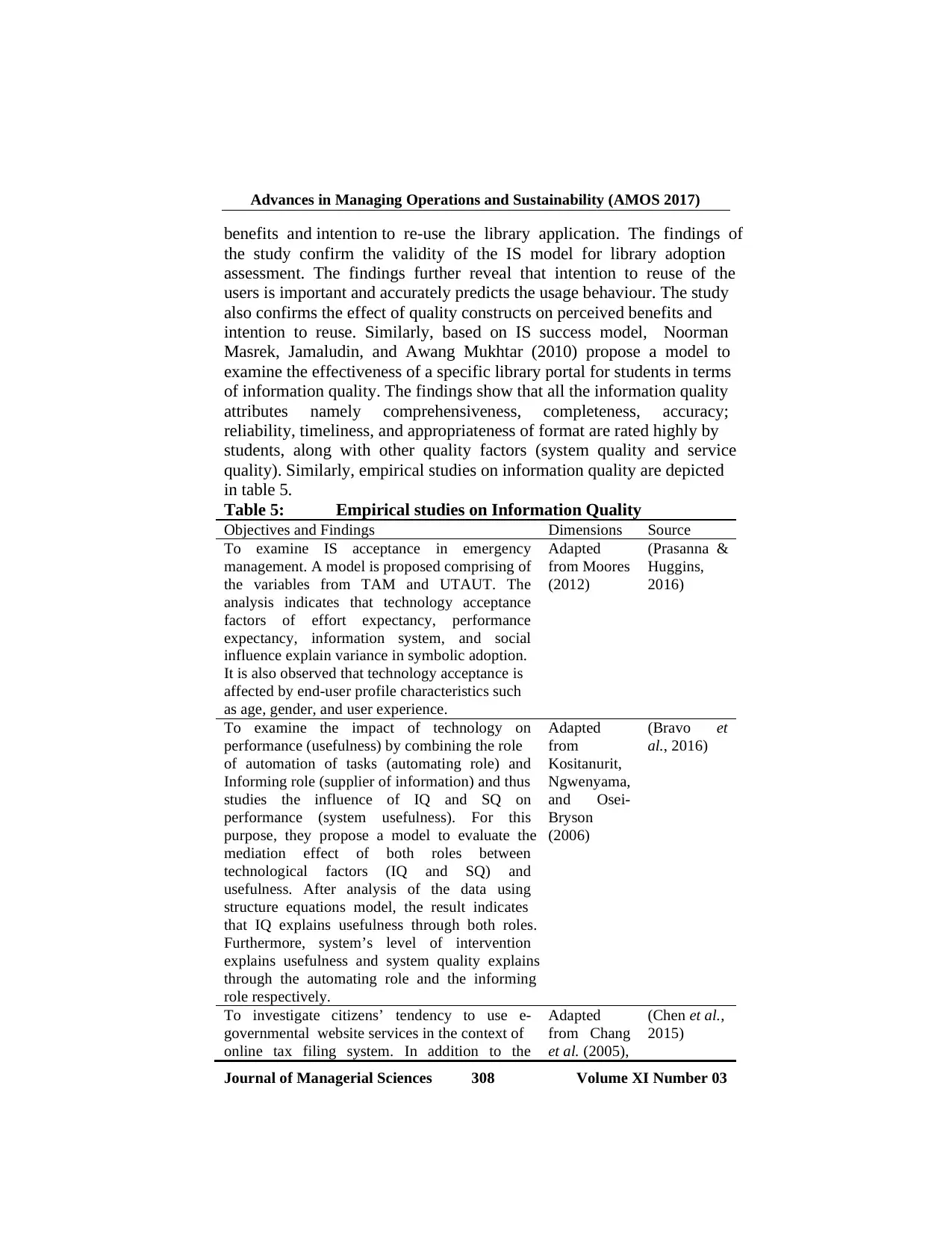
Advances in Managing Operations and Sustainability (AMOS 2017)
Journal of Managerial Sciences 308 Volume XI Number 03
benefits and intention to re-use the library application. The findings of
the study confirm the validity of the IS model for library adoption
assessment. The findings further reveal that intention to reuse of the
users is important and accurately predicts the usage behaviour. The study
also confirms the effect of quality constructs on perceived benefits and
intention to reuse. Similarly, based on IS success model, Noorman
Masrek, Jamaludin, and Awang Mukhtar (2010) propose a model to
examine the effectiveness of a specific library portal for students in terms
of information quality. The findings show that all the information quality
attributes namely comprehensiveness, completeness, accuracy;
reliability, timeliness, and appropriateness of format are rated highly by
students, along with other quality factors (system quality and service
quality). Similarly, empirical studies on information quality are depicted
in table 5.
Table 5: Empirical studies on Information Quality
Objectives and Findings Dimensions Source
To examine IS acceptance in emergency
management. A model is proposed comprising of
the variables from TAM and UTAUT. The
analysis indicates that technology acceptance
factors of effort expectancy, performance
expectancy, information system, and social
influence explain variance in symbolic adoption.
It is also observed that technology acceptance is
affected by end-user profile characteristics such
as age, gender, and user experience.
Adapted
from Moores
(2012)
(Prasanna &
Huggins,
2016)
To examine the impact of technology on
performance (usefulness) by combining the role
of automation of tasks (automating role) and
Informing role (supplier of information) and thus
studies the influence of IQ and SQ on
performance (system usefulness). For this
purpose, they propose a model to evaluate the
mediation effect of both roles between
technological factors (IQ and SQ) and
usefulness. After analysis of the data using
structure equations model, the result indicates
that IQ explains usefulness through both roles.
Furthermore, system’s level of intervention
explains usefulness and system quality explains
through the automating role and the informing
role respectively.
Adapted
from
Kositanurit,
Ngwenyama,
and Osei-
Bryson
(2006)
(Bravo et
al., 2016)
To investigate citizens’ tendency to use e-
governmental website services in the context of
online tax filing system. In addition to the
Adapted
from Chang
et al. (2005),
(Chen et al.,
2015)
Journal of Managerial Sciences 308 Volume XI Number 03
benefits and intention to re-use the library application. The findings of
the study confirm the validity of the IS model for library adoption
assessment. The findings further reveal that intention to reuse of the
users is important and accurately predicts the usage behaviour. The study
also confirms the effect of quality constructs on perceived benefits and
intention to reuse. Similarly, based on IS success model, Noorman
Masrek, Jamaludin, and Awang Mukhtar (2010) propose a model to
examine the effectiveness of a specific library portal for students in terms
of information quality. The findings show that all the information quality
attributes namely comprehensiveness, completeness, accuracy;
reliability, timeliness, and appropriateness of format are rated highly by
students, along with other quality factors (system quality and service
quality). Similarly, empirical studies on information quality are depicted
in table 5.
Table 5: Empirical studies on Information Quality
Objectives and Findings Dimensions Source
To examine IS acceptance in emergency
management. A model is proposed comprising of
the variables from TAM and UTAUT. The
analysis indicates that technology acceptance
factors of effort expectancy, performance
expectancy, information system, and social
influence explain variance in symbolic adoption.
It is also observed that technology acceptance is
affected by end-user profile characteristics such
as age, gender, and user experience.
Adapted
from Moores
(2012)
(Prasanna &
Huggins,
2016)
To examine the impact of technology on
performance (usefulness) by combining the role
of automation of tasks (automating role) and
Informing role (supplier of information) and thus
studies the influence of IQ and SQ on
performance (system usefulness). For this
purpose, they propose a model to evaluate the
mediation effect of both roles between
technological factors (IQ and SQ) and
usefulness. After analysis of the data using
structure equations model, the result indicates
that IQ explains usefulness through both roles.
Furthermore, system’s level of intervention
explains usefulness and system quality explains
through the automating role and the informing
role respectively.
Adapted
from
Kositanurit,
Ngwenyama,
and Osei-
Bryson
(2006)
(Bravo et
al., 2016)
To investigate citizens’ tendency to use e-
governmental website services in the context of
online tax filing system. In addition to the
Adapted
from Chang
et al. (2005),
(Chen et al.,
2015)
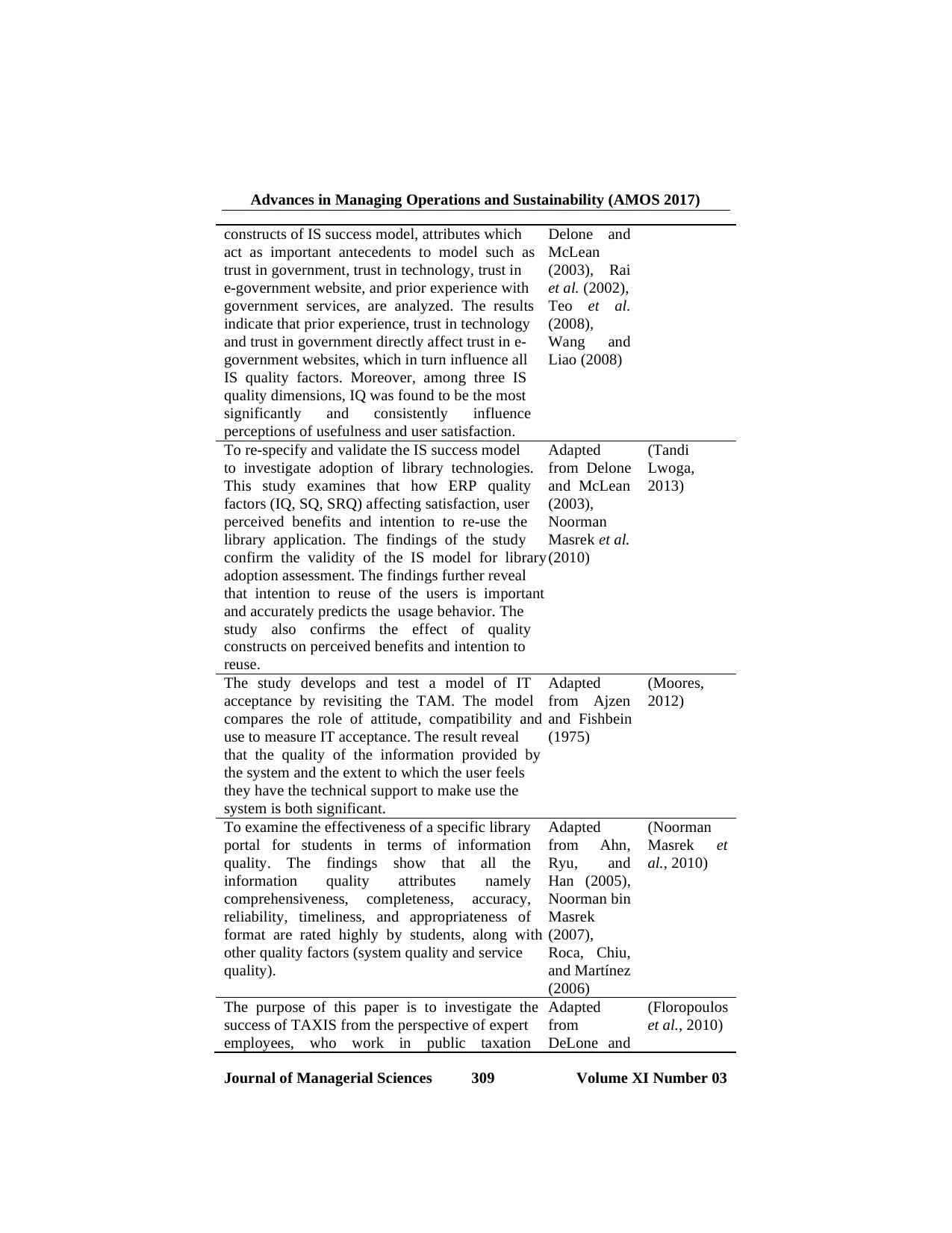
Advances in Managing Operations and Sustainability (AMOS 2017)
Journal of Managerial Sciences 309 Volume XI Number 03
constructs of IS success model, attributes which
act as important antecedents to model such as
trust in government, trust in technology, trust in
e-government website, and prior experience with
government services, are analyzed. The results
indicate that prior experience, trust in technology
and trust in government directly affect trust in e-
government websites, which in turn influence all
IS quality factors. Moreover, among three IS
quality dimensions, IQ was found to be the most
significantly and consistently influence
perceptions of usefulness and user satisfaction.
Delone and
McLean
(2003), Rai
et al. (2002),
Teo et al.
(2008),
Wang and
Liao (2008)
To re-specify and validate the IS success model
to investigate adoption of library technologies.
This study examines that how ERP quality
factors (IQ, SQ, SRQ) affecting satisfaction, user
perceived benefits and intention to re-use the
library application. The findings of the study
confirm the validity of the IS model for library
adoption assessment. The findings further reveal
that intention to reuse of the users is important
and accurately predicts the usage behavior. The
study also confirms the effect of quality
constructs on perceived benefits and intention to
reuse.
Adapted
from Delone
and McLean
(2003),
Noorman
Masrek et al.
(2010)
(Tandi
Lwoga,
2013)
The study develops and test a model of IT
acceptance by revisiting the TAM. The model
compares the role of attitude, compatibility and
use to measure IT acceptance. The result reveal
that the quality of the information provided by
the system and the extent to which the user feels
they have the technical support to make use the
system is both significant.
Adapted
from Ajzen
and Fishbein
(1975)
(Moores,
2012)
To examine the effectiveness of a specific library
portal for students in terms of information
quality. The findings show that all the
information quality attributes namely
comprehensiveness, completeness, accuracy,
reliability, timeliness, and appropriateness of
format are rated highly by students, along with
other quality factors (system quality and service
quality).
Adapted
from Ahn,
Ryu, and
Han (2005),
Noorman bin
Masrek
(2007),
Roca, Chiu,
and Martínez
(2006)
(Noorman
Masrek et
al., 2010)
The purpose of this paper is to investigate the
success of TAXIS from the perspective of expert
employees, who work in public taxation
Adapted
from
DeLone and
(Floropoulos
et al., 2010)
Journal of Managerial Sciences 309 Volume XI Number 03
constructs of IS success model, attributes which
act as important antecedents to model such as
trust in government, trust in technology, trust in
e-government website, and prior experience with
government services, are analyzed. The results
indicate that prior experience, trust in technology
and trust in government directly affect trust in e-
government websites, which in turn influence all
IS quality factors. Moreover, among three IS
quality dimensions, IQ was found to be the most
significantly and consistently influence
perceptions of usefulness and user satisfaction.
Delone and
McLean
(2003), Rai
et al. (2002),
Teo et al.
(2008),
Wang and
Liao (2008)
To re-specify and validate the IS success model
to investigate adoption of library technologies.
This study examines that how ERP quality
factors (IQ, SQ, SRQ) affecting satisfaction, user
perceived benefits and intention to re-use the
library application. The findings of the study
confirm the validity of the IS model for library
adoption assessment. The findings further reveal
that intention to reuse of the users is important
and accurately predicts the usage behavior. The
study also confirms the effect of quality
constructs on perceived benefits and intention to
reuse.
Adapted
from Delone
and McLean
(2003),
Noorman
Masrek et al.
(2010)
(Tandi
Lwoga,
2013)
The study develops and test a model of IT
acceptance by revisiting the TAM. The model
compares the role of attitude, compatibility and
use to measure IT acceptance. The result reveal
that the quality of the information provided by
the system and the extent to which the user feels
they have the technical support to make use the
system is both significant.
Adapted
from Ajzen
and Fishbein
(1975)
(Moores,
2012)
To examine the effectiveness of a specific library
portal for students in terms of information
quality. The findings show that all the
information quality attributes namely
comprehensiveness, completeness, accuracy,
reliability, timeliness, and appropriateness of
format are rated highly by students, along with
other quality factors (system quality and service
quality).
Adapted
from Ahn,
Ryu, and
Han (2005),
Noorman bin
Masrek
(2007),
Roca, Chiu,
and Martínez
(2006)
(Noorman
Masrek et
al., 2010)
The purpose of this paper is to investigate the
success of TAXIS from the perspective of expert
employees, who work in public taxation
Adapted
from
DeLone and
(Floropoulos
et al., 2010)
Paraphrase This Document
Need a fresh take? Get an instant paraphrase of this document with our AI Paraphraser
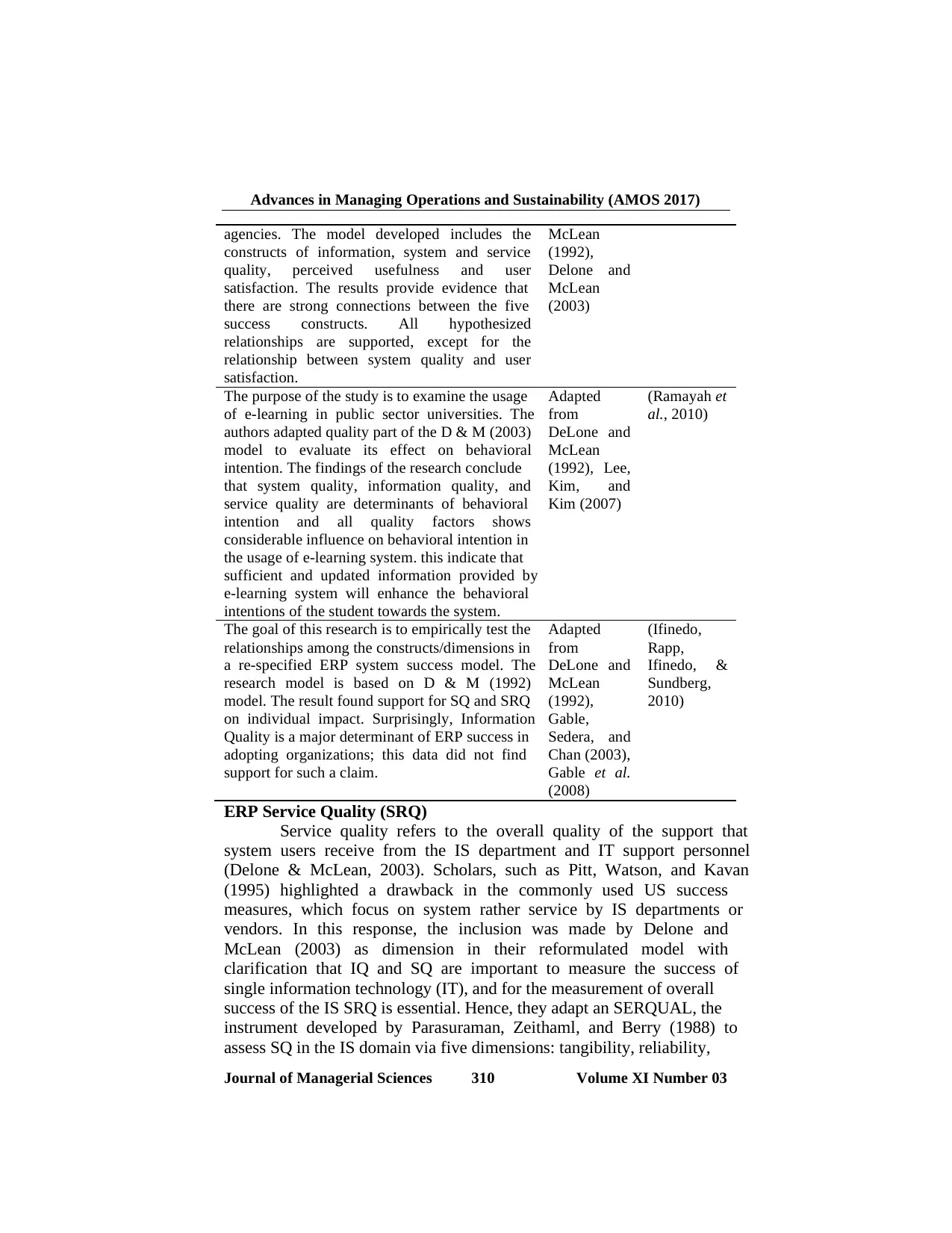
Advances in Managing Operations and Sustainability (AMOS 2017)
Journal of Managerial Sciences 310 Volume XI Number 03
agencies. The model developed includes the
constructs of information, system and service
quality, perceived usefulness and user
satisfaction. The results provide evidence that
there are strong connections between the five
success constructs. All hypothesized
relationships are supported, except for the
relationship between system quality and user
satisfaction.
McLean
(1992),
Delone and
McLean
(2003)
The purpose of the study is to examine the usage
of e-learning in public sector universities. The
authors adapted quality part of the D & M (2003)
model to evaluate its effect on behavioral
intention. The findings of the research conclude
that system quality, information quality, and
service quality are determinants of behavioral
intention and all quality factors shows
considerable influence on behavioral intention in
the usage of e-learning system. this indicate that
sufficient and updated information provided by
e-learning system will enhance the behavioral
intentions of the student towards the system.
Adapted
from
DeLone and
McLean
(1992), Lee,
Kim, and
Kim (2007)
(Ramayah et
al., 2010)
The goal of this research is to empirically test the
relationships among the constructs/dimensions in
a re-specified ERP system success model. The
research model is based on D & M (1992)
model. The result found support for SQ and SRQ
on individual impact. Surprisingly, Information
Quality is a major determinant of ERP success in
adopting organizations; this data did not find
support for such a claim.
Adapted
from
DeLone and
McLean
(1992),
Gable,
Sedera, and
Chan (2003),
Gable et al.
(2008)
(Ifinedo,
Rapp,
Ifinedo, &
Sundberg,
2010)
ERP Service Quality (SRQ)
Service quality refers to the overall quality of the support that
system users receive from the IS department and IT support personnel
(Delone & McLean, 2003). Scholars, such as Pitt, Watson, and Kavan
(1995) highlighted a drawback in the commonly used US success
measures, which focus on system rather service by IS departments or
vendors. In this response, the inclusion was made by Delone and
McLean (2003) as dimension in their reformulated model with
clarification that IQ and SQ are important to measure the success of
single information technology (IT), and for the measurement of overall
success of the IS SRQ is essential. Hence, they adapt an SERQUAL, the
instrument developed by Parasuraman, Zeithaml, and Berry (1988) to
assess SQ in the IS domain via five dimensions: tangibility, reliability,
Journal of Managerial Sciences 310 Volume XI Number 03
agencies. The model developed includes the
constructs of information, system and service
quality, perceived usefulness and user
satisfaction. The results provide evidence that
there are strong connections between the five
success constructs. All hypothesized
relationships are supported, except for the
relationship between system quality and user
satisfaction.
McLean
(1992),
Delone and
McLean
(2003)
The purpose of the study is to examine the usage
of e-learning in public sector universities. The
authors adapted quality part of the D & M (2003)
model to evaluate its effect on behavioral
intention. The findings of the research conclude
that system quality, information quality, and
service quality are determinants of behavioral
intention and all quality factors shows
considerable influence on behavioral intention in
the usage of e-learning system. this indicate that
sufficient and updated information provided by
e-learning system will enhance the behavioral
intentions of the student towards the system.
Adapted
from
DeLone and
McLean
(1992), Lee,
Kim, and
Kim (2007)
(Ramayah et
al., 2010)
The goal of this research is to empirically test the
relationships among the constructs/dimensions in
a re-specified ERP system success model. The
research model is based on D & M (1992)
model. The result found support for SQ and SRQ
on individual impact. Surprisingly, Information
Quality is a major determinant of ERP success in
adopting organizations; this data did not find
support for such a claim.
Adapted
from
DeLone and
McLean
(1992),
Gable,
Sedera, and
Chan (2003),
Gable et al.
(2008)
(Ifinedo,
Rapp,
Ifinedo, &
Sundberg,
2010)
ERP Service Quality (SRQ)
Service quality refers to the overall quality of the support that
system users receive from the IS department and IT support personnel
(Delone & McLean, 2003). Scholars, such as Pitt, Watson, and Kavan
(1995) highlighted a drawback in the commonly used US success
measures, which focus on system rather service by IS departments or
vendors. In this response, the inclusion was made by Delone and
McLean (2003) as dimension in their reformulated model with
clarification that IQ and SQ are important to measure the success of
single information technology (IT), and for the measurement of overall
success of the IS SRQ is essential. Hence, they adapt an SERQUAL, the
instrument developed by Parasuraman, Zeithaml, and Berry (1988) to
assess SQ in the IS domain via five dimensions: tangibility, reliability,
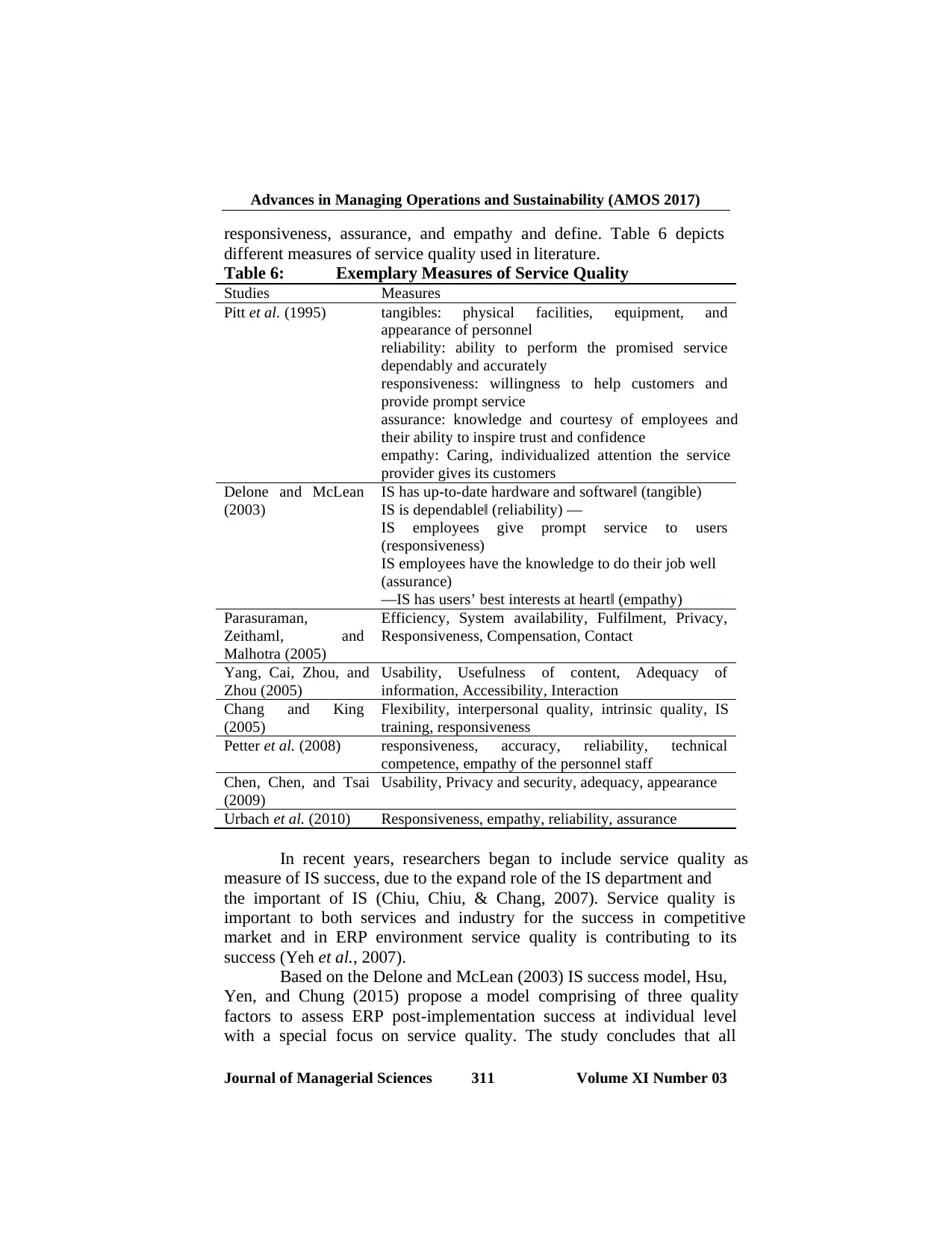
Advances in Managing Operations and Sustainability (AMOS 2017)
Journal of Managerial Sciences 311 Volume XI Number 03
responsiveness, assurance, and empathy and define. Table 6 depicts
different measures of service quality used in literature.
Table 6: Exemplary Measures of Service Quality
Studies Measures
Pitt et al. (1995) tangibles: physical facilities, equipment, and
appearance of personnel
reliability: ability to perform the promised service
dependably and accurately
responsiveness: willingness to help customers and
provide prompt service
assurance: knowledge and courtesy of employees and
their ability to inspire trust and confidence
empathy: Caring, individualized attention the service
provider gives its customers
Delone and McLean
(2003)
IS has up-to-date hardware and software‖ (tangible)
IS is dependable‖ (reliability) ―
IS employees give prompt service to users
(responsiveness)
IS employees have the knowledge to do their job well
(assurance)
―IS has users’ best interests at heart‖ (empathy)
Parasuraman,
Zeithaml, and
Malhotra (2005)
Efficiency, System availability, Fulfilment, Privacy,
Responsiveness, Compensation, Contact
Yang, Cai, Zhou, and
Zhou (2005)
Usability, Usefulness of content, Adequacy of
information, Accessibility, Interaction
Chang and King
(2005)
Flexibility, interpersonal quality, intrinsic quality, IS
training, responsiveness
Petter et al. (2008) responsiveness, accuracy, reliability, technical
competence, empathy of the personnel staff
Chen, Chen, and Tsai
(2009)
Usability, Privacy and security, adequacy, appearance
Urbach et al. (2010) Responsiveness, empathy, reliability, assurance
In recent years, researchers began to include service quality as
measure of IS success, due to the expand role of the IS department and
the important of IS (Chiu, Chiu, & Chang, 2007). Service quality is
important to both services and industry for the success in competitive
market and in ERP environment service quality is contributing to its
success (Yeh et al., 2007).
Based on the Delone and McLean (2003) IS success model, Hsu,
Yen, and Chung (2015) propose a model comprising of three quality
factors to assess ERP post-implementation success at individual level
with a special focus on service quality. The study concludes that all
Journal of Managerial Sciences 311 Volume XI Number 03
responsiveness, assurance, and empathy and define. Table 6 depicts
different measures of service quality used in literature.
Table 6: Exemplary Measures of Service Quality
Studies Measures
Pitt et al. (1995) tangibles: physical facilities, equipment, and
appearance of personnel
reliability: ability to perform the promised service
dependably and accurately
responsiveness: willingness to help customers and
provide prompt service
assurance: knowledge and courtesy of employees and
their ability to inspire trust and confidence
empathy: Caring, individualized attention the service
provider gives its customers
Delone and McLean
(2003)
IS has up-to-date hardware and software‖ (tangible)
IS is dependable‖ (reliability) ―
IS employees give prompt service to users
(responsiveness)
IS employees have the knowledge to do their job well
(assurance)
―IS has users’ best interests at heart‖ (empathy)
Parasuraman,
Zeithaml, and
Malhotra (2005)
Efficiency, System availability, Fulfilment, Privacy,
Responsiveness, Compensation, Contact
Yang, Cai, Zhou, and
Zhou (2005)
Usability, Usefulness of content, Adequacy of
information, Accessibility, Interaction
Chang and King
(2005)
Flexibility, interpersonal quality, intrinsic quality, IS
training, responsiveness
Petter et al. (2008) responsiveness, accuracy, reliability, technical
competence, empathy of the personnel staff
Chen, Chen, and Tsai
(2009)
Usability, Privacy and security, adequacy, appearance
Urbach et al. (2010) Responsiveness, empathy, reliability, assurance
In recent years, researchers began to include service quality as
measure of IS success, due to the expand role of the IS department and
the important of IS (Chiu, Chiu, & Chang, 2007). Service quality is
important to both services and industry for the success in competitive
market and in ERP environment service quality is contributing to its
success (Yeh et al., 2007).
Based on the Delone and McLean (2003) IS success model, Hsu,
Yen, and Chung (2015) propose a model comprising of three quality
factors to assess ERP post-implementation success at individual level
with a special focus on service quality. The study concludes that all
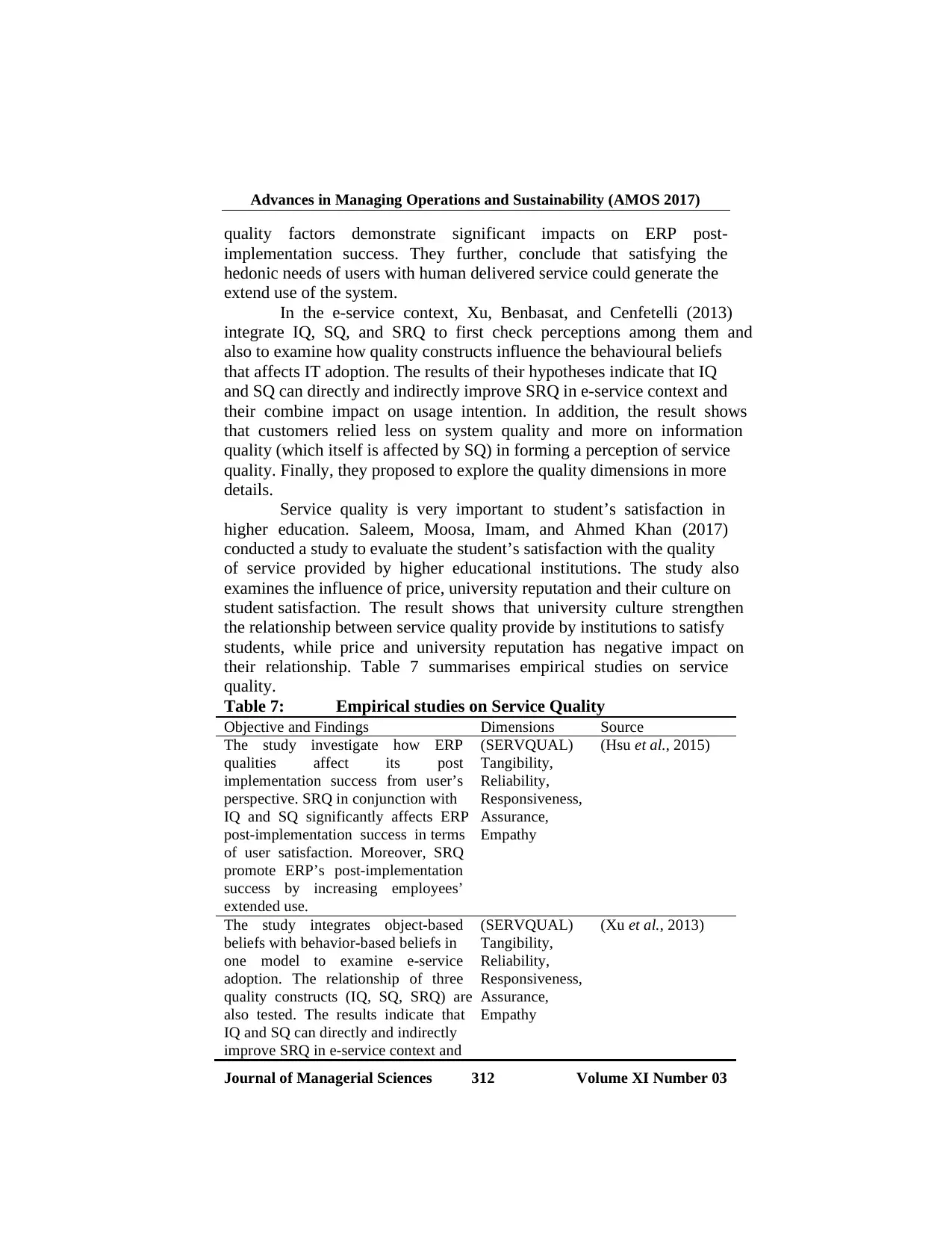
Advances in Managing Operations and Sustainability (AMOS 2017)
Journal of Managerial Sciences 312 Volume XI Number 03
quality factors demonstrate significant impacts on ERP post-
implementation success. They further, conclude that satisfying the
hedonic needs of users with human delivered service could generate the
extend use of the system.
In the e-service context, Xu, Benbasat, and Cenfetelli (2013)
integrate IQ, SQ, and SRQ to first check perceptions among them and
also to examine how quality constructs influence the behavioural beliefs
that affects IT adoption. The results of their hypotheses indicate that IQ
and SQ can directly and indirectly improve SRQ in e-service context and
their combine impact on usage intention. In addition, the result shows
that customers relied less on system quality and more on information
quality (which itself is affected by SQ) in forming a perception of service
quality. Finally, they proposed to explore the quality dimensions in more
details.
Service quality is very important to student’s satisfaction in
higher education. Saleem, Moosa, Imam, and Ahmed Khan (2017)
conducted a study to evaluate the student’s satisfaction with the quality
of service provided by higher educational institutions. The study also
examines the influence of price, university reputation and their culture on
student satisfaction. The result shows that university culture strengthen
the relationship between service quality provide by institutions to satisfy
students, while price and university reputation has negative impact on
their relationship. Table 7 summarises empirical studies on service
quality.
Table 7: Empirical studies on Service Quality
Objective and Findings Dimensions Source
The study investigate how ERP
qualities affect its post
implementation success from user’s
perspective. SRQ in conjunction with
IQ and SQ significantly affects ERP
post-implementation success in terms
of user satisfaction. Moreover, SRQ
promote ERP’s post-implementation
success by increasing employees’
extended use.
(SERVQUAL)
Tangibility,
Reliability,
Responsiveness,
Assurance,
Empathy
(Hsu et al., 2015)
The study integrates object-based
beliefs with behavior-based beliefs in
one model to examine e-service
adoption. The relationship of three
quality constructs (IQ, SQ, SRQ) are
also tested. The results indicate that
IQ and SQ can directly and indirectly
improve SRQ in e-service context and
(SERVQUAL)
Tangibility,
Reliability,
Responsiveness,
Assurance,
Empathy
(Xu et al., 2013)
Journal of Managerial Sciences 312 Volume XI Number 03
quality factors demonstrate significant impacts on ERP post-
implementation success. They further, conclude that satisfying the
hedonic needs of users with human delivered service could generate the
extend use of the system.
In the e-service context, Xu, Benbasat, and Cenfetelli (2013)
integrate IQ, SQ, and SRQ to first check perceptions among them and
also to examine how quality constructs influence the behavioural beliefs
that affects IT adoption. The results of their hypotheses indicate that IQ
and SQ can directly and indirectly improve SRQ in e-service context and
their combine impact on usage intention. In addition, the result shows
that customers relied less on system quality and more on information
quality (which itself is affected by SQ) in forming a perception of service
quality. Finally, they proposed to explore the quality dimensions in more
details.
Service quality is very important to student’s satisfaction in
higher education. Saleem, Moosa, Imam, and Ahmed Khan (2017)
conducted a study to evaluate the student’s satisfaction with the quality
of service provided by higher educational institutions. The study also
examines the influence of price, university reputation and their culture on
student satisfaction. The result shows that university culture strengthen
the relationship between service quality provide by institutions to satisfy
students, while price and university reputation has negative impact on
their relationship. Table 7 summarises empirical studies on service
quality.
Table 7: Empirical studies on Service Quality
Objective and Findings Dimensions Source
The study investigate how ERP
qualities affect its post
implementation success from user’s
perspective. SRQ in conjunction with
IQ and SQ significantly affects ERP
post-implementation success in terms
of user satisfaction. Moreover, SRQ
promote ERP’s post-implementation
success by increasing employees’
extended use.
(SERVQUAL)
Tangibility,
Reliability,
Responsiveness,
Assurance,
Empathy
(Hsu et al., 2015)
The study integrates object-based
beliefs with behavior-based beliefs in
one model to examine e-service
adoption. The relationship of three
quality constructs (IQ, SQ, SRQ) are
also tested. The results indicate that
IQ and SQ can directly and indirectly
improve SRQ in e-service context and
(SERVQUAL)
Tangibility,
Reliability,
Responsiveness,
Assurance,
Empathy
(Xu et al., 2013)
Secure Best Marks with AI Grader
Need help grading? Try our AI Grader for instant feedback on your assignments.
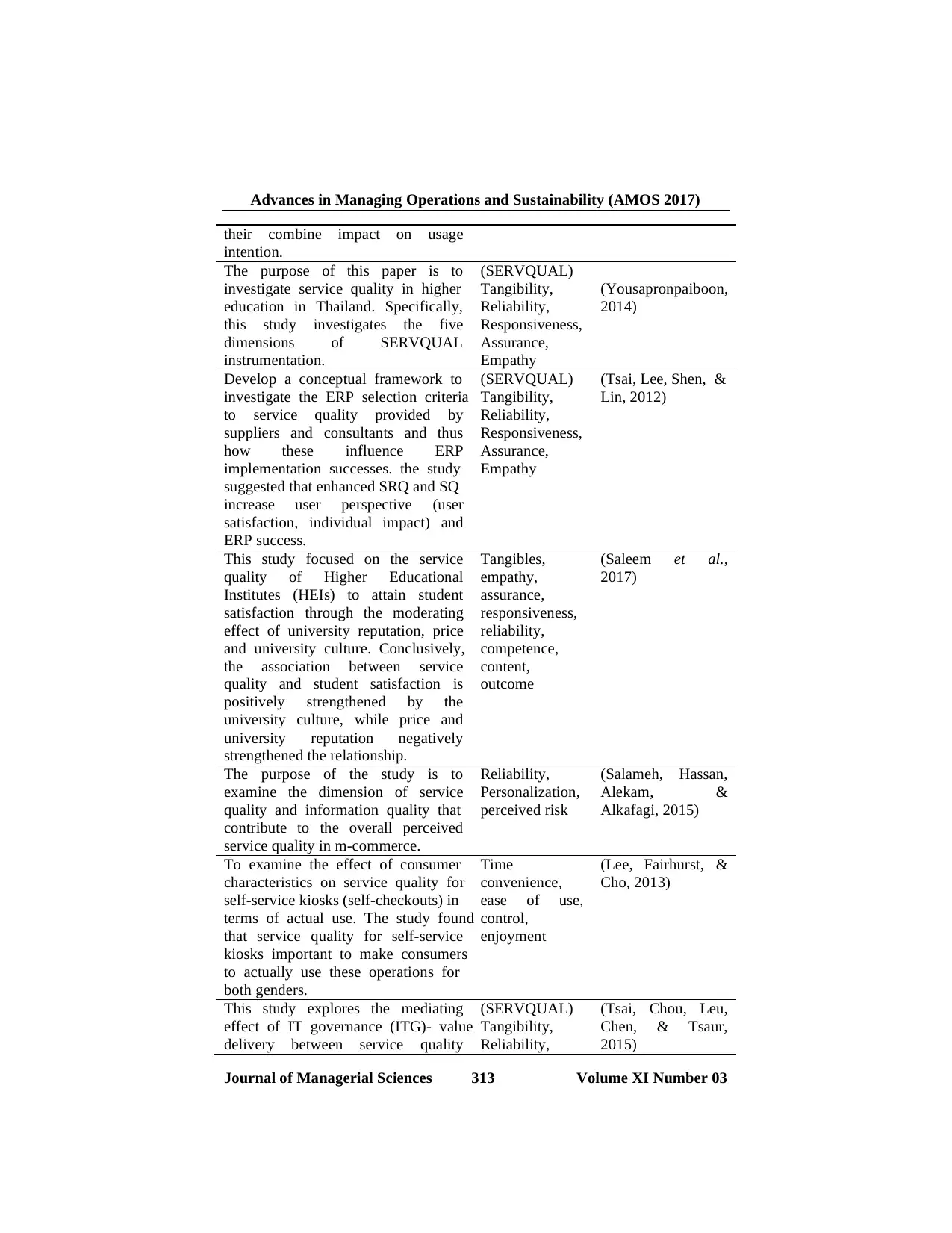
Advances in Managing Operations and Sustainability (AMOS 2017)
Journal of Managerial Sciences 313 Volume XI Number 03
their combine impact on usage
intention.
The purpose of this paper is to
investigate service quality in higher
education in Thailand. Specifically,
this study investigates the five
dimensions of SERVQUAL
instrumentation.
(SERVQUAL)
Tangibility,
Reliability,
Responsiveness,
Assurance,
Empathy
(Yousapronpaiboon,
2014)
Develop a conceptual framework to
investigate the ERP selection criteria
to service quality provided by
suppliers and consultants and thus
how these influence ERP
implementation successes. the study
suggested that enhanced SRQ and SQ
increase user perspective (user
satisfaction, individual impact) and
ERP success.
(SERVQUAL)
Tangibility,
Reliability,
Responsiveness,
Assurance,
Empathy
(Tsai, Lee, Shen, &
Lin, 2012)
This study focused on the service
quality of Higher Educational
Institutes (HEIs) to attain student
satisfaction through the moderating
effect of university reputation, price
and university culture. Conclusively,
the association between service
quality and student satisfaction is
positively strengthened by the
university culture, while price and
university reputation negatively
strengthened the relationship.
Tangibles,
empathy,
assurance,
responsiveness,
reliability,
competence,
content,
outcome
(Saleem et al.,
2017)
The purpose of the study is to
examine the dimension of service
quality and information quality that
contribute to the overall perceived
service quality in m-commerce.
Reliability,
Personalization,
perceived risk
(Salameh, Hassan,
Alekam, &
Alkafagi, 2015)
To examine the effect of consumer
characteristics on service quality for
self-service kiosks (self-checkouts) in
terms of actual use. The study found
that service quality for self-service
kiosks important to make consumers
to actually use these operations for
both genders.
Time
convenience,
ease of use,
control,
enjoyment
(Lee, Fairhurst, &
Cho, 2013)
This study explores the mediating
effect of IT governance (ITG)- value
delivery between service quality
(SERVQUAL)
Tangibility,
Reliability,
(Tsai, Chou, Leu,
Chen, & Tsaur,
2015)
Journal of Managerial Sciences 313 Volume XI Number 03
their combine impact on usage
intention.
The purpose of this paper is to
investigate service quality in higher
education in Thailand. Specifically,
this study investigates the five
dimensions of SERVQUAL
instrumentation.
(SERVQUAL)
Tangibility,
Reliability,
Responsiveness,
Assurance,
Empathy
(Yousapronpaiboon,
2014)
Develop a conceptual framework to
investigate the ERP selection criteria
to service quality provided by
suppliers and consultants and thus
how these influence ERP
implementation successes. the study
suggested that enhanced SRQ and SQ
increase user perspective (user
satisfaction, individual impact) and
ERP success.
(SERVQUAL)
Tangibility,
Reliability,
Responsiveness,
Assurance,
Empathy
(Tsai, Lee, Shen, &
Lin, 2012)
This study focused on the service
quality of Higher Educational
Institutes (HEIs) to attain student
satisfaction through the moderating
effect of university reputation, price
and university culture. Conclusively,
the association between service
quality and student satisfaction is
positively strengthened by the
university culture, while price and
university reputation negatively
strengthened the relationship.
Tangibles,
empathy,
assurance,
responsiveness,
reliability,
competence,
content,
outcome
(Saleem et al.,
2017)
The purpose of the study is to
examine the dimension of service
quality and information quality that
contribute to the overall perceived
service quality in m-commerce.
Reliability,
Personalization,
perceived risk
(Salameh, Hassan,
Alekam, &
Alkafagi, 2015)
To examine the effect of consumer
characteristics on service quality for
self-service kiosks (self-checkouts) in
terms of actual use. The study found
that service quality for self-service
kiosks important to make consumers
to actually use these operations for
both genders.
Time
convenience,
ease of use,
control,
enjoyment
(Lee, Fairhurst, &
Cho, 2013)
This study explores the mediating
effect of IT governance (ITG)- value
delivery between service quality
(SERVQUAL)
Tangibility,
Reliability,
(Tsai, Chou, Leu,
Chen, & Tsaur,
2015)
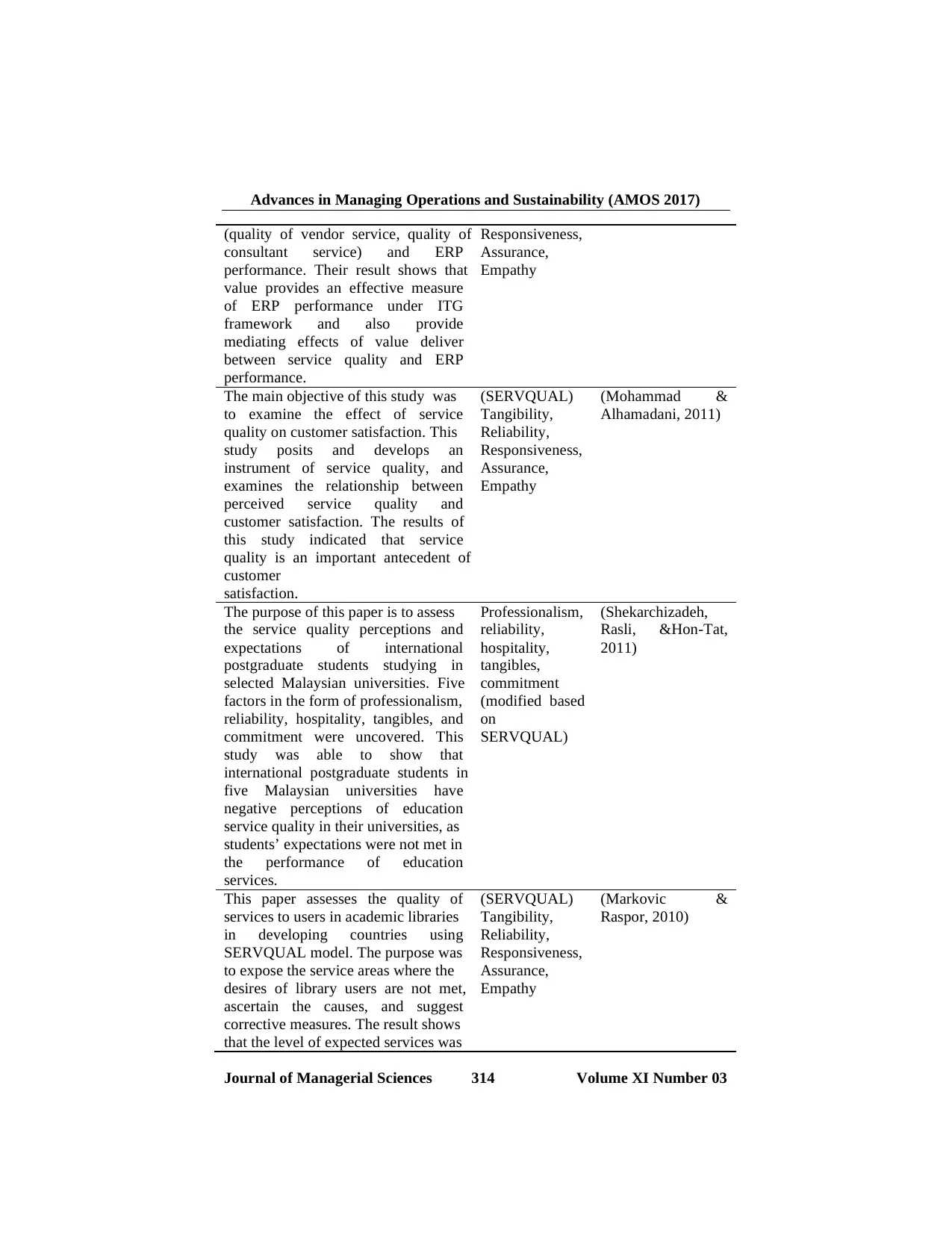
Advances in Managing Operations and Sustainability (AMOS 2017)
Journal of Managerial Sciences 314 Volume XI Number 03
(quality of vendor service, quality of
consultant service) and ERP
performance. Their result shows that
value provides an effective measure
of ERP performance under ITG
framework and also provide
mediating effects of value deliver
between service quality and ERP
performance.
Responsiveness,
Assurance,
Empathy
The main objective of this study was
to examine the effect of service
quality on customer satisfaction. This
study posits and develops an
instrument of service quality, and
examines the relationship between
perceived service quality and
customer satisfaction. The results of
this study indicated that service
quality is an important antecedent of
customer
satisfaction.
(SERVQUAL)
Tangibility,
Reliability,
Responsiveness,
Assurance,
Empathy
(Mohammad &
Alhamadani, 2011)
The purpose of this paper is to assess
the service quality perceptions and
expectations of international
postgraduate students studying in
selected Malaysian universities. Five
factors in the form of professionalism,
reliability, hospitality, tangibles, and
commitment were uncovered. This
study was able to show that
international postgraduate students in
five Malaysian universities have
negative perceptions of education
service quality in their universities, as
students’ expectations were not met in
the performance of education
services.
Professionalism,
reliability,
hospitality,
tangibles,
commitment
(modified based
on
SERVQUAL)
(Shekarchizadeh,
Rasli, &Hon-Tat,
2011)
This paper assesses the quality of
services to users in academic libraries
in developing countries using
SERVQUAL model. The purpose was
to expose the service areas where the
desires of library users are not met,
ascertain the causes, and suggest
corrective measures. The result shows
that the level of expected services was
(SERVQUAL)
Tangibility,
Reliability,
Responsiveness,
Assurance,
Empathy
(Markovic &
Raspor, 2010)
Journal of Managerial Sciences 314 Volume XI Number 03
(quality of vendor service, quality of
consultant service) and ERP
performance. Their result shows that
value provides an effective measure
of ERP performance under ITG
framework and also provide
mediating effects of value deliver
between service quality and ERP
performance.
Responsiveness,
Assurance,
Empathy
The main objective of this study was
to examine the effect of service
quality on customer satisfaction. This
study posits and develops an
instrument of service quality, and
examines the relationship between
perceived service quality and
customer satisfaction. The results of
this study indicated that service
quality is an important antecedent of
customer
satisfaction.
(SERVQUAL)
Tangibility,
Reliability,
Responsiveness,
Assurance,
Empathy
(Mohammad &
Alhamadani, 2011)
The purpose of this paper is to assess
the service quality perceptions and
expectations of international
postgraduate students studying in
selected Malaysian universities. Five
factors in the form of professionalism,
reliability, hospitality, tangibles, and
commitment were uncovered. This
study was able to show that
international postgraduate students in
five Malaysian universities have
negative perceptions of education
service quality in their universities, as
students’ expectations were not met in
the performance of education
services.
Professionalism,
reliability,
hospitality,
tangibles,
commitment
(modified based
on
SERVQUAL)
(Shekarchizadeh,
Rasli, &Hon-Tat,
2011)
This paper assesses the quality of
services to users in academic libraries
in developing countries using
SERVQUAL model. The purpose was
to expose the service areas where the
desires of library users are not met,
ascertain the causes, and suggest
corrective measures. The result shows
that the level of expected services was
(SERVQUAL)
Tangibility,
Reliability,
Responsiveness,
Assurance,
Empathy
(Markovic &
Raspor, 2010)
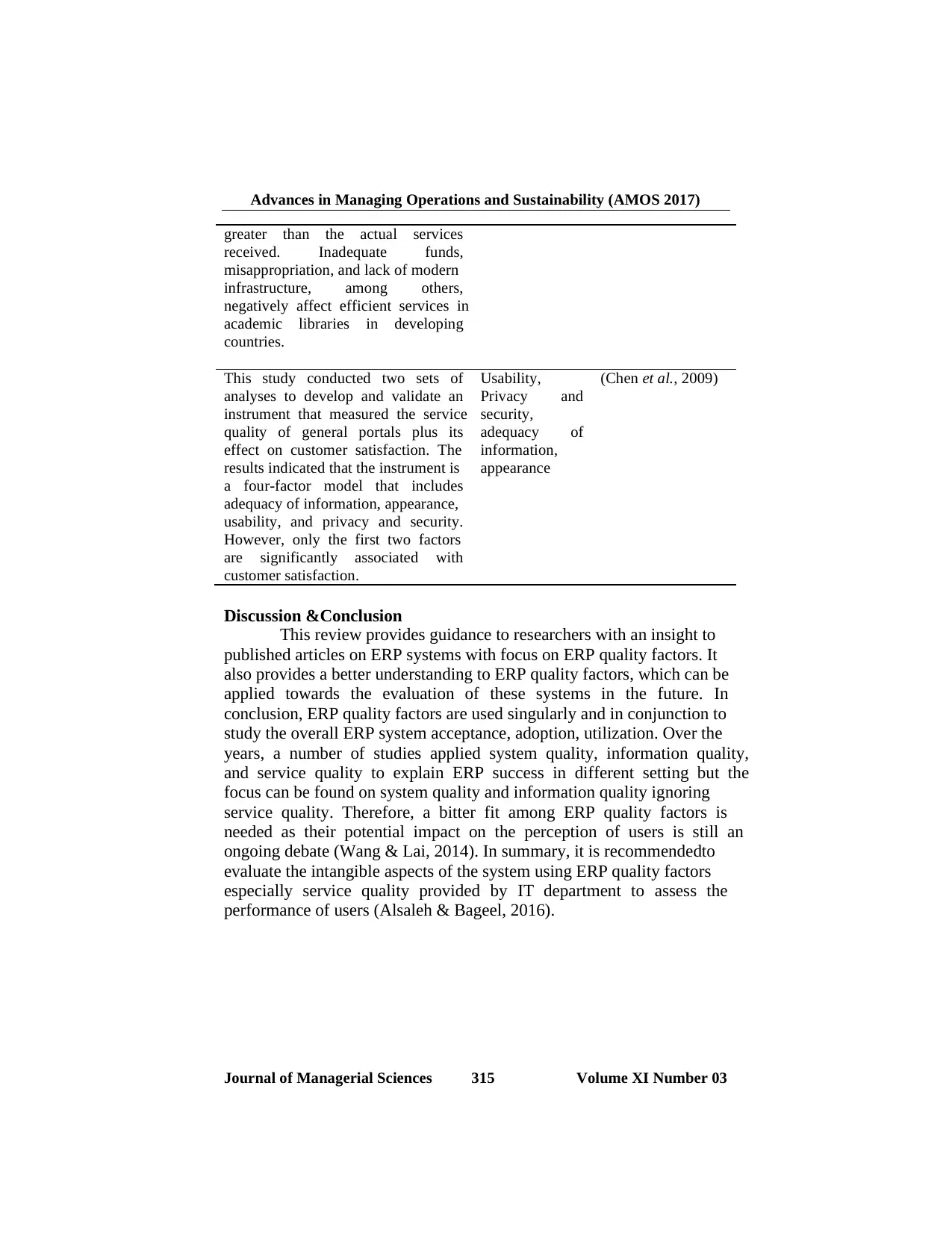
Advances in Managing Operations and Sustainability (AMOS 2017)
Journal of Managerial Sciences 315 Volume XI Number 03
greater than the actual services
received. Inadequate funds,
misappropriation, and lack of modern
infrastructure, among others,
negatively affect efficient services in
academic libraries in developing
countries.
This study conducted two sets of
analyses to develop and validate an
instrument that measured the service
quality of general portals plus its
effect on customer satisfaction. The
results indicated that the instrument is
a four-factor model that includes
adequacy of information, appearance,
usability, and privacy and security.
However, only the first two factors
are significantly associated with
customer satisfaction.
Usability,
Privacy and
security,
adequacy of
information,
appearance
(Chen et al., 2009)
Discussion &Conclusion
This review provides guidance to researchers with an insight to
published articles on ERP systems with focus on ERP quality factors. It
also provides a better understanding to ERP quality factors, which can be
applied towards the evaluation of these systems in the future. In
conclusion, ERP quality factors are used singularly and in conjunction to
study the overall ERP system acceptance, adoption, utilization. Over the
years, a number of studies applied system quality, information quality,
and service quality to explain ERP success in different setting but the
focus can be found on system quality and information quality ignoring
service quality. Therefore, a bitter fit among ERP quality factors is
needed as their potential impact on the perception of users is still an
ongoing debate (Wang & Lai, 2014). In summary, it is recommendedto
evaluate the intangible aspects of the system using ERP quality factors
especially service quality provided by IT department to assess the
performance of users (Alsaleh & Bageel, 2016).
Journal of Managerial Sciences 315 Volume XI Number 03
greater than the actual services
received. Inadequate funds,
misappropriation, and lack of modern
infrastructure, among others,
negatively affect efficient services in
academic libraries in developing
countries.
This study conducted two sets of
analyses to develop and validate an
instrument that measured the service
quality of general portals plus its
effect on customer satisfaction. The
results indicated that the instrument is
a four-factor model that includes
adequacy of information, appearance,
usability, and privacy and security.
However, only the first two factors
are significantly associated with
customer satisfaction.
Usability,
Privacy and
security,
adequacy of
information,
appearance
(Chen et al., 2009)
Discussion &Conclusion
This review provides guidance to researchers with an insight to
published articles on ERP systems with focus on ERP quality factors. It
also provides a better understanding to ERP quality factors, which can be
applied towards the evaluation of these systems in the future. In
conclusion, ERP quality factors are used singularly and in conjunction to
study the overall ERP system acceptance, adoption, utilization. Over the
years, a number of studies applied system quality, information quality,
and service quality to explain ERP success in different setting but the
focus can be found on system quality and information quality ignoring
service quality. Therefore, a bitter fit among ERP quality factors is
needed as their potential impact on the perception of users is still an
ongoing debate (Wang & Lai, 2014). In summary, it is recommendedto
evaluate the intangible aspects of the system using ERP quality factors
especially service quality provided by IT department to assess the
performance of users (Alsaleh & Bageel, 2016).
Paraphrase This Document
Need a fresh take? Get an instant paraphrase of this document with our AI Paraphraser
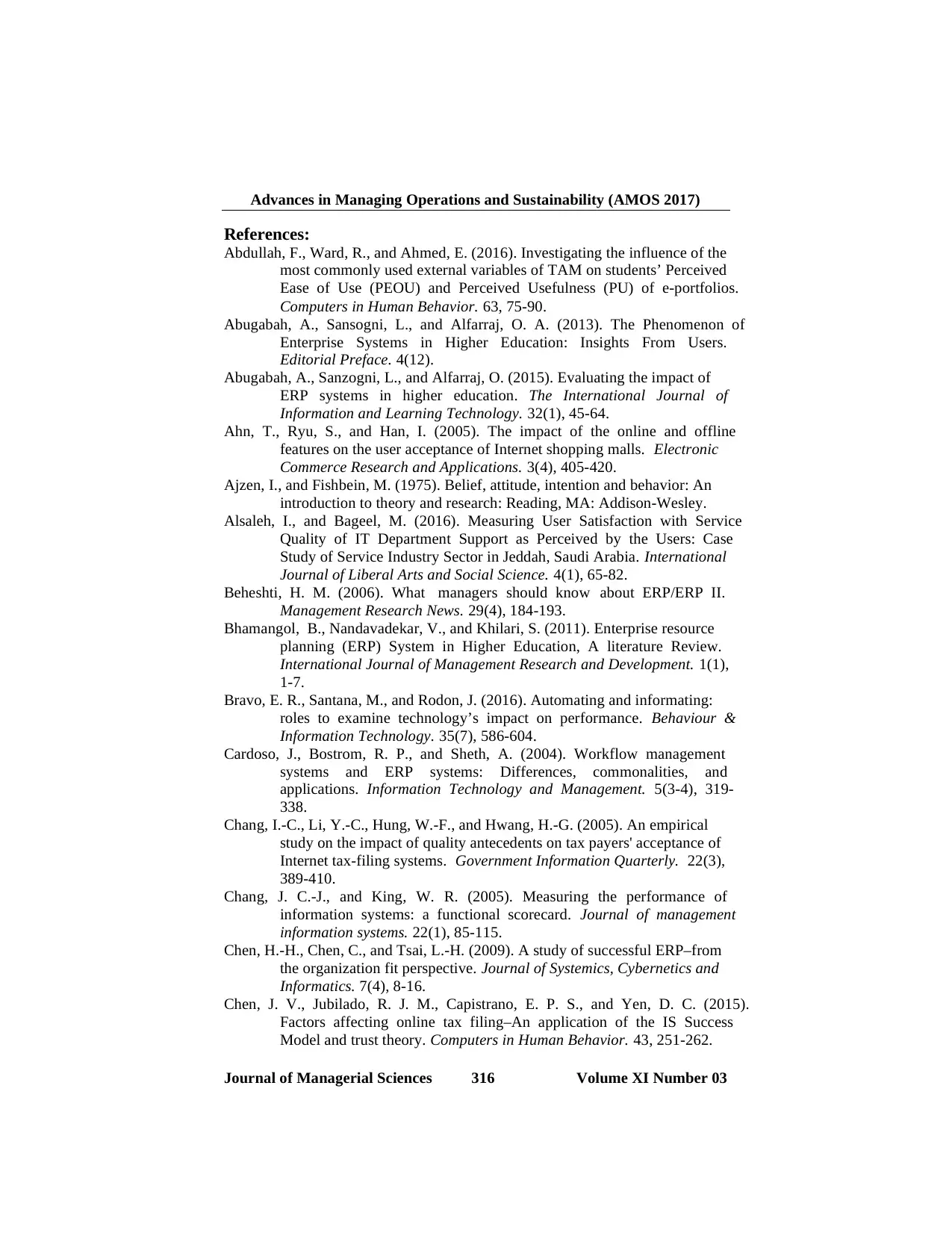
Advances in Managing Operations and Sustainability (AMOS 2017)
Journal of Managerial Sciences 316 Volume XI Number 03
References:
Abdullah, F., Ward, R., and Ahmed, E. (2016). Investigating the influence of the
most commonly used external variables of TAM on students’ Perceived
Ease of Use (PEOU) and Perceived Usefulness (PU) of e-portfolios.
Computers in Human Behavior. 63, 75-90.
Abugabah, A., Sansogni, L., and Alfarraj, O. A. (2013). The Phenomenon of
Enterprise Systems in Higher Education: Insights From Users.
Editorial Preface. 4(12).
Abugabah, A., Sanzogni, L., and Alfarraj, O. (2015). Evaluating the impact of
ERP systems in higher education. The International Journal of
Information and Learning Technology. 32(1), 45-64.
Ahn, T., Ryu, S., and Han, I. (2005). The impact of the online and offline
features on the user acceptance of Internet shopping malls. Electronic
Commerce Research and Applications. 3(4), 405-420.
Ajzen, I., and Fishbein, M. (1975). Belief, attitude, intention and behavior: An
introduction to theory and research: Reading, MA: Addison-Wesley.
Alsaleh, I., and Bageel, M. (2016). Measuring User Satisfaction with Service
Quality of IT Department Support as Perceived by the Users: Case
Study of Service Industry Sector in Jeddah, Saudi Arabia. International
Journal of Liberal Arts and Social Science. 4(1), 65-82.
Beheshti, H. M. (2006). What managers should know about ERP/ERP II.
Management Research News. 29(4), 184-193.
Bhamangol, B., Nandavadekar, V., and Khilari, S. (2011). Enterprise resource
planning (ERP) System in Higher Education, A literature Review.
International Journal of Management Research and Development. 1(1),
1-7.
Bravo, E. R., Santana, M., and Rodon, J. (2016). Automating and informating:
roles to examine technology’s impact on performance. Behaviour &
Information Technology. 35(7), 586-604.
Cardoso, J., Bostrom, R. P., and Sheth, A. (2004). Workflow management
systems and ERP systems: Differences, commonalities, and
applications. Information Technology and Management. 5(3-4), 319-
338.
Chang, I.-C., Li, Y.-C., Hung, W.-F., and Hwang, H.-G. (2005). An empirical
study on the impact of quality antecedents on tax payers' acceptance of
Internet tax-filing systems. Government Information Quarterly. 22(3),
389-410.
Chang, J. C.-J., and King, W. R. (2005). Measuring the performance of
information systems: a functional scorecard. Journal of management
information systems. 22(1), 85-115.
Chen, H.-H., Chen, C., and Tsai, L.-H. (2009). A study of successful ERP–from
the organization fit perspective. Journal of Systemics, Cybernetics and
Informatics. 7(4), 8-16.
Chen, J. V., Jubilado, R. J. M., Capistrano, E. P. S., and Yen, D. C. (2015).
Factors affecting online tax filing–An application of the IS Success
Model and trust theory. Computers in Human Behavior. 43, 251-262.
Journal of Managerial Sciences 316 Volume XI Number 03
References:
Abdullah, F., Ward, R., and Ahmed, E. (2016). Investigating the influence of the
most commonly used external variables of TAM on students’ Perceived
Ease of Use (PEOU) and Perceived Usefulness (PU) of e-portfolios.
Computers in Human Behavior. 63, 75-90.
Abugabah, A., Sansogni, L., and Alfarraj, O. A. (2013). The Phenomenon of
Enterprise Systems in Higher Education: Insights From Users.
Editorial Preface. 4(12).
Abugabah, A., Sanzogni, L., and Alfarraj, O. (2015). Evaluating the impact of
ERP systems in higher education. The International Journal of
Information and Learning Technology. 32(1), 45-64.
Ahn, T., Ryu, S., and Han, I. (2005). The impact of the online and offline
features on the user acceptance of Internet shopping malls. Electronic
Commerce Research and Applications. 3(4), 405-420.
Ajzen, I., and Fishbein, M. (1975). Belief, attitude, intention and behavior: An
introduction to theory and research: Reading, MA: Addison-Wesley.
Alsaleh, I., and Bageel, M. (2016). Measuring User Satisfaction with Service
Quality of IT Department Support as Perceived by the Users: Case
Study of Service Industry Sector in Jeddah, Saudi Arabia. International
Journal of Liberal Arts and Social Science. 4(1), 65-82.
Beheshti, H. M. (2006). What managers should know about ERP/ERP II.
Management Research News. 29(4), 184-193.
Bhamangol, B., Nandavadekar, V., and Khilari, S. (2011). Enterprise resource
planning (ERP) System in Higher Education, A literature Review.
International Journal of Management Research and Development. 1(1),
1-7.
Bravo, E. R., Santana, M., and Rodon, J. (2016). Automating and informating:
roles to examine technology’s impact on performance. Behaviour &
Information Technology. 35(7), 586-604.
Cardoso, J., Bostrom, R. P., and Sheth, A. (2004). Workflow management
systems and ERP systems: Differences, commonalities, and
applications. Information Technology and Management. 5(3-4), 319-
338.
Chang, I.-C., Li, Y.-C., Hung, W.-F., and Hwang, H.-G. (2005). An empirical
study on the impact of quality antecedents on tax payers' acceptance of
Internet tax-filing systems. Government Information Quarterly. 22(3),
389-410.
Chang, J. C.-J., and King, W. R. (2005). Measuring the performance of
information systems: a functional scorecard. Journal of management
information systems. 22(1), 85-115.
Chen, H.-H., Chen, C., and Tsai, L.-H. (2009). A study of successful ERP–from
the organization fit perspective. Journal of Systemics, Cybernetics and
Informatics. 7(4), 8-16.
Chen, J. V., Jubilado, R. J. M., Capistrano, E. P. S., and Yen, D. C. (2015).
Factors affecting online tax filing–An application of the IS Success
Model and trust theory. Computers in Human Behavior. 43, 251-262.
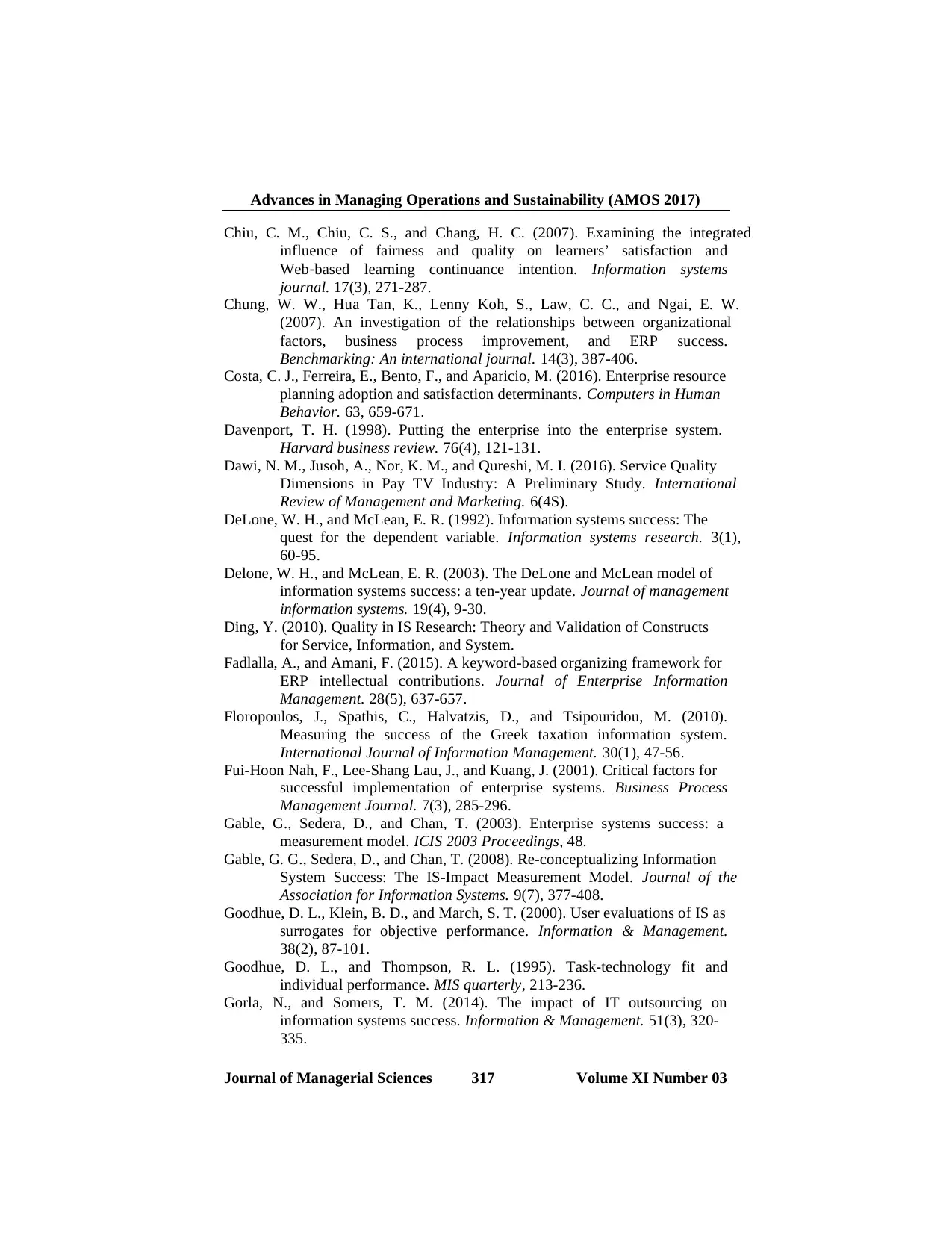
Advances in Managing Operations and Sustainability (AMOS 2017)
Journal of Managerial Sciences 317 Volume XI Number 03
Chiu, C. M., Chiu, C. S., and Chang, H. C. (2007). Examining the integrated
influence of fairness and quality on learners’ satisfaction and
Web‐based learning continuance intention. Information systems
journal. 17(3), 271-287.
Chung, W. W., Hua Tan, K., Lenny Koh, S., Law, C. C., and Ngai, E. W.
(2007). An investigation of the relationships between organizational
factors, business process improvement, and ERP success.
Benchmarking: An international journal. 14(3), 387-406.
Costa, C. J., Ferreira, E., Bento, F., and Aparicio, M. (2016). Enterprise resource
planning adoption and satisfaction determinants. Computers in Human
Behavior. 63, 659-671.
Davenport, T. H. (1998). Putting the enterprise into the enterprise system.
Harvard business review. 76(4), 121-131.
Dawi, N. M., Jusoh, A., Nor, K. M., and Qureshi, M. I. (2016). Service Quality
Dimensions in Pay TV Industry: A Preliminary Study. International
Review of Management and Marketing. 6(4S).
DeLone, W. H., and McLean, E. R. (1992). Information systems success: The
quest for the dependent variable. Information systems research. 3(1),
60-95.
Delone, W. H., and McLean, E. R. (2003). The DeLone and McLean model of
information systems success: a ten-year update. Journal of management
information systems. 19(4), 9-30.
Ding, Y. (2010). Quality in IS Research: Theory and Validation of Constructs
for Service, Information, and System.
Fadlalla, A., and Amani, F. (2015). A keyword-based organizing framework for
ERP intellectual contributions. Journal of Enterprise Information
Management. 28(5), 637-657.
Floropoulos, J., Spathis, C., Halvatzis, D., and Tsipouridou, M. (2010).
Measuring the success of the Greek taxation information system.
International Journal of Information Management. 30(1), 47-56.
Fui-Hoon Nah, F., Lee-Shang Lau, J., and Kuang, J. (2001). Critical factors for
successful implementation of enterprise systems. Business Process
Management Journal. 7(3), 285-296.
Gable, G., Sedera, D., and Chan, T. (2003). Enterprise systems success: a
measurement model. ICIS 2003 Proceedings, 48.
Gable, G. G., Sedera, D., and Chan, T. (2008). Re-conceptualizing Information
System Success: The IS-Impact Measurement Model. Journal of the
Association for Information Systems. 9(7), 377-408.
Goodhue, D. L., Klein, B. D., and March, S. T. (2000). User evaluations of IS as
surrogates for objective performance. Information & Management.
38(2), 87-101.
Goodhue, D. L., and Thompson, R. L. (1995). Task-technology fit and
individual performance. MIS quarterly, 213-236.
Gorla, N., and Somers, T. M. (2014). The impact of IT outsourcing on
information systems success. Information & Management. 51(3), 320-
335.
Journal of Managerial Sciences 317 Volume XI Number 03
Chiu, C. M., Chiu, C. S., and Chang, H. C. (2007). Examining the integrated
influence of fairness and quality on learners’ satisfaction and
Web‐based learning continuance intention. Information systems
journal. 17(3), 271-287.
Chung, W. W., Hua Tan, K., Lenny Koh, S., Law, C. C., and Ngai, E. W.
(2007). An investigation of the relationships between organizational
factors, business process improvement, and ERP success.
Benchmarking: An international journal. 14(3), 387-406.
Costa, C. J., Ferreira, E., Bento, F., and Aparicio, M. (2016). Enterprise resource
planning adoption and satisfaction determinants. Computers in Human
Behavior. 63, 659-671.
Davenport, T. H. (1998). Putting the enterprise into the enterprise system.
Harvard business review. 76(4), 121-131.
Dawi, N. M., Jusoh, A., Nor, K. M., and Qureshi, M. I. (2016). Service Quality
Dimensions in Pay TV Industry: A Preliminary Study. International
Review of Management and Marketing. 6(4S).
DeLone, W. H., and McLean, E. R. (1992). Information systems success: The
quest for the dependent variable. Information systems research. 3(1),
60-95.
Delone, W. H., and McLean, E. R. (2003). The DeLone and McLean model of
information systems success: a ten-year update. Journal of management
information systems. 19(4), 9-30.
Ding, Y. (2010). Quality in IS Research: Theory and Validation of Constructs
for Service, Information, and System.
Fadlalla, A., and Amani, F. (2015). A keyword-based organizing framework for
ERP intellectual contributions. Journal of Enterprise Information
Management. 28(5), 637-657.
Floropoulos, J., Spathis, C., Halvatzis, D., and Tsipouridou, M. (2010).
Measuring the success of the Greek taxation information system.
International Journal of Information Management. 30(1), 47-56.
Fui-Hoon Nah, F., Lee-Shang Lau, J., and Kuang, J. (2001). Critical factors for
successful implementation of enterprise systems. Business Process
Management Journal. 7(3), 285-296.
Gable, G., Sedera, D., and Chan, T. (2003). Enterprise systems success: a
measurement model. ICIS 2003 Proceedings, 48.
Gable, G. G., Sedera, D., and Chan, T. (2008). Re-conceptualizing Information
System Success: The IS-Impact Measurement Model. Journal of the
Association for Information Systems. 9(7), 377-408.
Goodhue, D. L., Klein, B. D., and March, S. T. (2000). User evaluations of IS as
surrogates for objective performance. Information & Management.
38(2), 87-101.
Goodhue, D. L., and Thompson, R. L. (1995). Task-technology fit and
individual performance. MIS quarterly, 213-236.
Gorla, N., and Somers, T. M. (2014). The impact of IT outsourcing on
information systems success. Information & Management. 51(3), 320-
335.
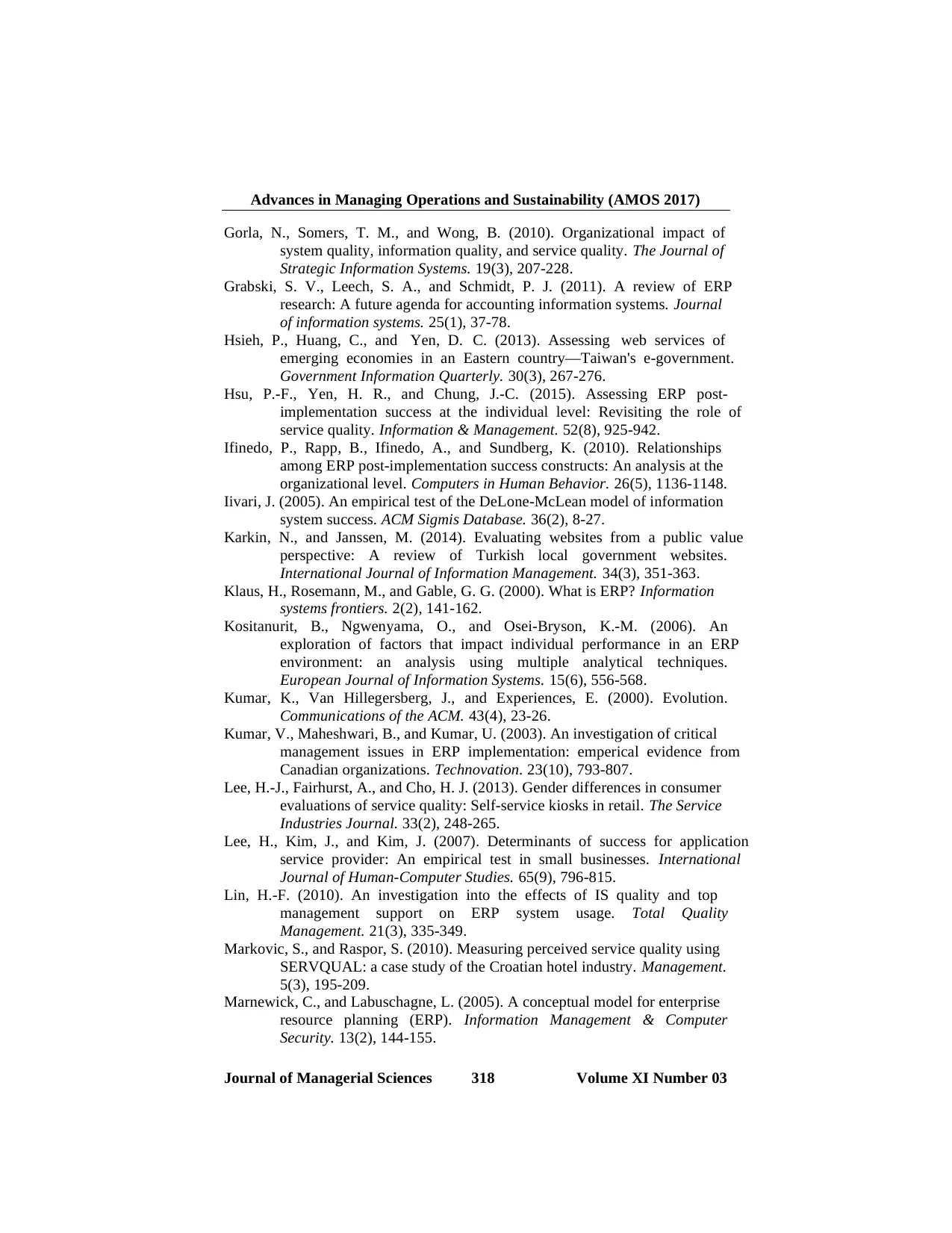
Advances in Managing Operations and Sustainability (AMOS 2017)
Journal of Managerial Sciences 318 Volume XI Number 03
Gorla, N., Somers, T. M., and Wong, B. (2010). Organizational impact of
system quality, information quality, and service quality. The Journal of
Strategic Information Systems. 19(3), 207-228.
Grabski, S. V., Leech, S. A., and Schmidt, P. J. (2011). A review of ERP
research: A future agenda for accounting information systems. Journal
of information systems. 25(1), 37-78.
Hsieh, P., Huang, C., and Yen, D. C. (2013). Assessing web services of
emerging economies in an Eastern country—Taiwan's e-government.
Government Information Quarterly. 30(3), 267-276.
Hsu, P.-F., Yen, H. R., and Chung, J.-C. (2015). Assessing ERP post-
implementation success at the individual level: Revisiting the role of
service quality. Information & Management. 52(8), 925-942.
Ifinedo, P., Rapp, B., Ifinedo, A., and Sundberg, K. (2010). Relationships
among ERP post-implementation success constructs: An analysis at the
organizational level. Computers in Human Behavior. 26(5), 1136-1148.
Iivari, J. (2005). An empirical test of the DeLone-McLean model of information
system success. ACM Sigmis Database. 36(2), 8-27.
Karkin, N., and Janssen, M. (2014). Evaluating websites from a public value
perspective: A review of Turkish local government websites.
International Journal of Information Management. 34(3), 351-363.
Klaus, H., Rosemann, M., and Gable, G. G. (2000). What is ERP? Information
systems frontiers. 2(2), 141-162.
Kositanurit, B., Ngwenyama, O., and Osei-Bryson, K.-M. (2006). An
exploration of factors that impact individual performance in an ERP
environment: an analysis using multiple analytical techniques.
European Journal of Information Systems. 15(6), 556-568.
Kumar, K., Van Hillegersberg, J., and Experiences, E. (2000). Evolution.
Communications of the ACM. 43(4), 23-26.
Kumar, V., Maheshwari, B., and Kumar, U. (2003). An investigation of critical
management issues in ERP implementation: emperical evidence from
Canadian organizations. Technovation. 23(10), 793-807.
Lee, H.-J., Fairhurst, A., and Cho, H. J. (2013). Gender differences in consumer
evaluations of service quality: Self-service kiosks in retail. The Service
Industries Journal. 33(2), 248-265.
Lee, H., Kim, J., and Kim, J. (2007). Determinants of success for application
service provider: An empirical test in small businesses. International
Journal of Human-Computer Studies. 65(9), 796-815.
Lin, H.-F. (2010). An investigation into the effects of IS quality and top
management support on ERP system usage. Total Quality
Management. 21(3), 335-349.
Markovic, S., and Raspor, S. (2010). Measuring perceived service quality using
SERVQUAL: a case study of the Croatian hotel industry. Management.
5(3), 195-209.
Marnewick, C., and Labuschagne, L. (2005). A conceptual model for enterprise
resource planning (ERP). Information Management & Computer
Security. 13(2), 144-155.
Journal of Managerial Sciences 318 Volume XI Number 03
Gorla, N., Somers, T. M., and Wong, B. (2010). Organizational impact of
system quality, information quality, and service quality. The Journal of
Strategic Information Systems. 19(3), 207-228.
Grabski, S. V., Leech, S. A., and Schmidt, P. J. (2011). A review of ERP
research: A future agenda for accounting information systems. Journal
of information systems. 25(1), 37-78.
Hsieh, P., Huang, C., and Yen, D. C. (2013). Assessing web services of
emerging economies in an Eastern country—Taiwan's e-government.
Government Information Quarterly. 30(3), 267-276.
Hsu, P.-F., Yen, H. R., and Chung, J.-C. (2015). Assessing ERP post-
implementation success at the individual level: Revisiting the role of
service quality. Information & Management. 52(8), 925-942.
Ifinedo, P., Rapp, B., Ifinedo, A., and Sundberg, K. (2010). Relationships
among ERP post-implementation success constructs: An analysis at the
organizational level. Computers in Human Behavior. 26(5), 1136-1148.
Iivari, J. (2005). An empirical test of the DeLone-McLean model of information
system success. ACM Sigmis Database. 36(2), 8-27.
Karkin, N., and Janssen, M. (2014). Evaluating websites from a public value
perspective: A review of Turkish local government websites.
International Journal of Information Management. 34(3), 351-363.
Klaus, H., Rosemann, M., and Gable, G. G. (2000). What is ERP? Information
systems frontiers. 2(2), 141-162.
Kositanurit, B., Ngwenyama, O., and Osei-Bryson, K.-M. (2006). An
exploration of factors that impact individual performance in an ERP
environment: an analysis using multiple analytical techniques.
European Journal of Information Systems. 15(6), 556-568.
Kumar, K., Van Hillegersberg, J., and Experiences, E. (2000). Evolution.
Communications of the ACM. 43(4), 23-26.
Kumar, V., Maheshwari, B., and Kumar, U. (2003). An investigation of critical
management issues in ERP implementation: emperical evidence from
Canadian organizations. Technovation. 23(10), 793-807.
Lee, H.-J., Fairhurst, A., and Cho, H. J. (2013). Gender differences in consumer
evaluations of service quality: Self-service kiosks in retail. The Service
Industries Journal. 33(2), 248-265.
Lee, H., Kim, J., and Kim, J. (2007). Determinants of success for application
service provider: An empirical test in small businesses. International
Journal of Human-Computer Studies. 65(9), 796-815.
Lin, H.-F. (2010). An investigation into the effects of IS quality and top
management support on ERP system usage. Total Quality
Management. 21(3), 335-349.
Markovic, S., and Raspor, S. (2010). Measuring perceived service quality using
SERVQUAL: a case study of the Croatian hotel industry. Management.
5(3), 195-209.
Marnewick, C., and Labuschagne, L. (2005). A conceptual model for enterprise
resource planning (ERP). Information Management & Computer
Security. 13(2), 144-155.
Secure Best Marks with AI Grader
Need help grading? Try our AI Grader for instant feedback on your assignments.
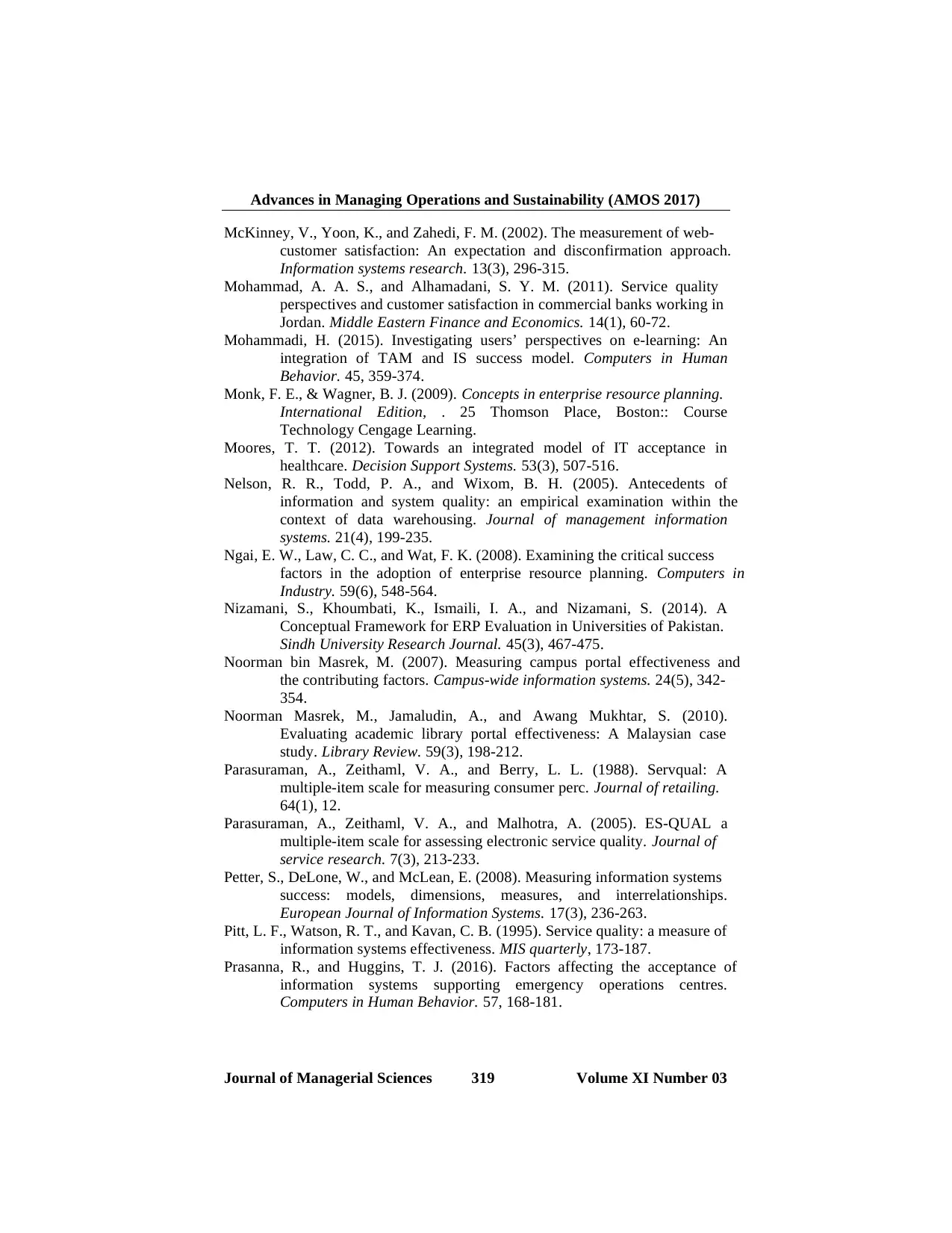
Advances in Managing Operations and Sustainability (AMOS 2017)
Journal of Managerial Sciences 319 Volume XI Number 03
McKinney, V., Yoon, K., and Zahedi, F. M. (2002). The measurement of web-
customer satisfaction: An expectation and disconfirmation approach.
Information systems research. 13(3), 296-315.
Mohammad, A. A. S., and Alhamadani, S. Y. M. (2011). Service quality
perspectives and customer satisfaction in commercial banks working in
Jordan. Middle Eastern Finance and Economics. 14(1), 60-72.
Mohammadi, H. (2015). Investigating users’ perspectives on e-learning: An
integration of TAM and IS success model. Computers in Human
Behavior. 45, 359-374.
Monk, F. E., & Wagner, B. J. (2009). Concepts in enterprise resource planning.
International Edition, . 25 Thomson Place, Boston:: Course
Technology Cengage Learning.
Moores, T. T. (2012). Towards an integrated model of IT acceptance in
healthcare. Decision Support Systems. 53(3), 507-516.
Nelson, R. R., Todd, P. A., and Wixom, B. H. (2005). Antecedents of
information and system quality: an empirical examination within the
context of data warehousing. Journal of management information
systems. 21(4), 199-235.
Ngai, E. W., Law, C. C., and Wat, F. K. (2008). Examining the critical success
factors in the adoption of enterprise resource planning. Computers in
Industry. 59(6), 548-564.
Nizamani, S., Khoumbati, K., Ismaili, I. A., and Nizamani, S. (2014). A
Conceptual Framework for ERP Evaluation in Universities of Pakistan.
Sindh University Research Journal. 45(3), 467-475.
Noorman bin Masrek, M. (2007). Measuring campus portal effectiveness and
the contributing factors. Campus-wide information systems. 24(5), 342-
354.
Noorman Masrek, M., Jamaludin, A., and Awang Mukhtar, S. (2010).
Evaluating academic library portal effectiveness: A Malaysian case
study. Library Review. 59(3), 198-212.
Parasuraman, A., Zeithaml, V. A., and Berry, L. L. (1988). Servqual: A
multiple-item scale for measuring consumer perc. Journal of retailing.
64(1), 12.
Parasuraman, A., Zeithaml, V. A., and Malhotra, A. (2005). ES-QUAL a
multiple-item scale for assessing electronic service quality. Journal of
service research. 7(3), 213-233.
Petter, S., DeLone, W., and McLean, E. (2008). Measuring information systems
success: models, dimensions, measures, and interrelationships.
European Journal of Information Systems. 17(3), 236-263.
Pitt, L. F., Watson, R. T., and Kavan, C. B. (1995). Service quality: a measure of
information systems effectiveness. MIS quarterly, 173-187.
Prasanna, R., and Huggins, T. J. (2016). Factors affecting the acceptance of
information systems supporting emergency operations centres.
Computers in Human Behavior. 57, 168-181.
Journal of Managerial Sciences 319 Volume XI Number 03
McKinney, V., Yoon, K., and Zahedi, F. M. (2002). The measurement of web-
customer satisfaction: An expectation and disconfirmation approach.
Information systems research. 13(3), 296-315.
Mohammad, A. A. S., and Alhamadani, S. Y. M. (2011). Service quality
perspectives and customer satisfaction in commercial banks working in
Jordan. Middle Eastern Finance and Economics. 14(1), 60-72.
Mohammadi, H. (2015). Investigating users’ perspectives on e-learning: An
integration of TAM and IS success model. Computers in Human
Behavior. 45, 359-374.
Monk, F. E., & Wagner, B. J. (2009). Concepts in enterprise resource planning.
International Edition, . 25 Thomson Place, Boston:: Course
Technology Cengage Learning.
Moores, T. T. (2012). Towards an integrated model of IT acceptance in
healthcare. Decision Support Systems. 53(3), 507-516.
Nelson, R. R., Todd, P. A., and Wixom, B. H. (2005). Antecedents of
information and system quality: an empirical examination within the
context of data warehousing. Journal of management information
systems. 21(4), 199-235.
Ngai, E. W., Law, C. C., and Wat, F. K. (2008). Examining the critical success
factors in the adoption of enterprise resource planning. Computers in
Industry. 59(6), 548-564.
Nizamani, S., Khoumbati, K., Ismaili, I. A., and Nizamani, S. (2014). A
Conceptual Framework for ERP Evaluation in Universities of Pakistan.
Sindh University Research Journal. 45(3), 467-475.
Noorman bin Masrek, M. (2007). Measuring campus portal effectiveness and
the contributing factors. Campus-wide information systems. 24(5), 342-
354.
Noorman Masrek, M., Jamaludin, A., and Awang Mukhtar, S. (2010).
Evaluating academic library portal effectiveness: A Malaysian case
study. Library Review. 59(3), 198-212.
Parasuraman, A., Zeithaml, V. A., and Berry, L. L. (1988). Servqual: A
multiple-item scale for measuring consumer perc. Journal of retailing.
64(1), 12.
Parasuraman, A., Zeithaml, V. A., and Malhotra, A. (2005). ES-QUAL a
multiple-item scale for assessing electronic service quality. Journal of
service research. 7(3), 213-233.
Petter, S., DeLone, W., and McLean, E. (2008). Measuring information systems
success: models, dimensions, measures, and interrelationships.
European Journal of Information Systems. 17(3), 236-263.
Pitt, L. F., Watson, R. T., and Kavan, C. B. (1995). Service quality: a measure of
information systems effectiveness. MIS quarterly, 173-187.
Prasanna, R., and Huggins, T. J. (2016). Factors affecting the acceptance of
information systems supporting emergency operations centres.
Computers in Human Behavior. 57, 168-181.
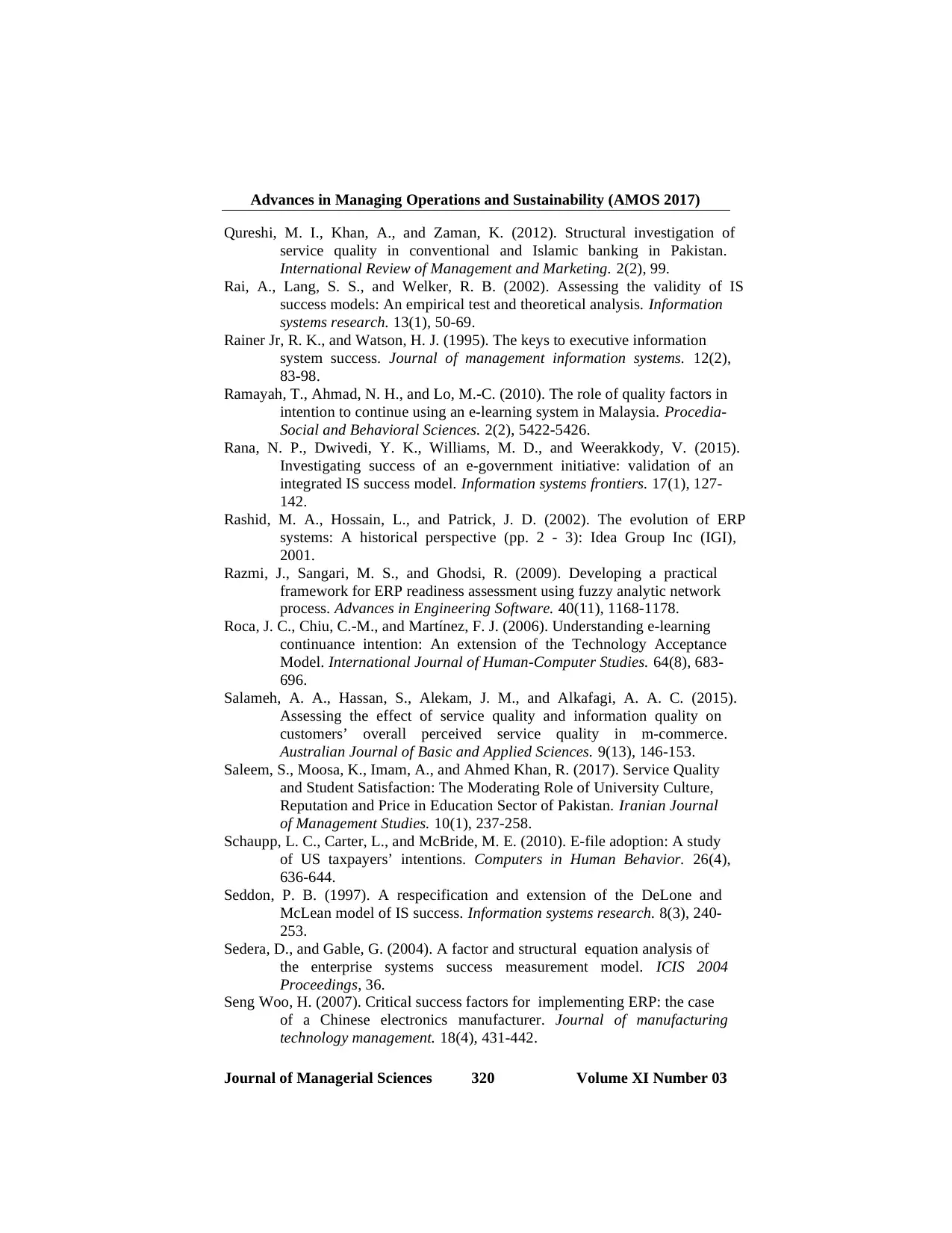
Advances in Managing Operations and Sustainability (AMOS 2017)
Journal of Managerial Sciences 320 Volume XI Number 03
Qureshi, M. I., Khan, A., and Zaman, K. (2012). Structural investigation of
service quality in conventional and Islamic banking in Pakistan.
International Review of Management and Marketing. 2(2), 99.
Rai, A., Lang, S. S., and Welker, R. B. (2002). Assessing the validity of IS
success models: An empirical test and theoretical analysis. Information
systems research. 13(1), 50-69.
Rainer Jr, R. K., and Watson, H. J. (1995). The keys to executive information
system success. Journal of management information systems. 12(2),
83-98.
Ramayah, T., Ahmad, N. H., and Lo, M.-C. (2010). The role of quality factors in
intention to continue using an e-learning system in Malaysia. Procedia-
Social and Behavioral Sciences. 2(2), 5422-5426.
Rana, N. P., Dwivedi, Y. K., Williams, M. D., and Weerakkody, V. (2015).
Investigating success of an e-government initiative: validation of an
integrated IS success model. Information systems frontiers. 17(1), 127-
142.
Rashid, M. A., Hossain, L., and Patrick, J. D. (2002). The evolution of ERP
systems: A historical perspective (pp. 2 - 3): Idea Group Inc (IGI),
2001.
Razmi, J., Sangari, M. S., and Ghodsi, R. (2009). Developing a practical
framework for ERP readiness assessment using fuzzy analytic network
process. Advances in Engineering Software. 40(11), 1168-1178.
Roca, J. C., Chiu, C.-M., and Martínez, F. J. (2006). Understanding e-learning
continuance intention: An extension of the Technology Acceptance
Model. International Journal of Human-Computer Studies. 64(8), 683-
696.
Salameh, A. A., Hassan, S., Alekam, J. M., and Alkafagi, A. A. C. (2015).
Assessing the effect of service quality and information quality on
customers’ overall perceived service quality in m-commerce.
Australian Journal of Basic and Applied Sciences. 9(13), 146-153.
Saleem, S., Moosa, K., Imam, A., and Ahmed Khan, R. (2017). Service Quality
and Student Satisfaction: The Moderating Role of University Culture,
Reputation and Price in Education Sector of Pakistan. Iranian Journal
of Management Studies. 10(1), 237-258.
Schaupp, L. C., Carter, L., and McBride, M. E. (2010). E-file adoption: A study
of US taxpayers’ intentions. Computers in Human Behavior. 26(4),
636-644.
Seddon, P. B. (1997). A respecification and extension of the DeLone and
McLean model of IS success. Information systems research. 8(3), 240-
253.
Sedera, D., and Gable, G. (2004). A factor and structural equation analysis of
the enterprise systems success measurement model. ICIS 2004
Proceedings, 36.
Seng Woo, H. (2007). Critical success factors for implementing ERP: the case
of a Chinese electronics manufacturer. Journal of manufacturing
technology management. 18(4), 431-442.
Journal of Managerial Sciences 320 Volume XI Number 03
Qureshi, M. I., Khan, A., and Zaman, K. (2012). Structural investigation of
service quality in conventional and Islamic banking in Pakistan.
International Review of Management and Marketing. 2(2), 99.
Rai, A., Lang, S. S., and Welker, R. B. (2002). Assessing the validity of IS
success models: An empirical test and theoretical analysis. Information
systems research. 13(1), 50-69.
Rainer Jr, R. K., and Watson, H. J. (1995). The keys to executive information
system success. Journal of management information systems. 12(2),
83-98.
Ramayah, T., Ahmad, N. H., and Lo, M.-C. (2010). The role of quality factors in
intention to continue using an e-learning system in Malaysia. Procedia-
Social and Behavioral Sciences. 2(2), 5422-5426.
Rana, N. P., Dwivedi, Y. K., Williams, M. D., and Weerakkody, V. (2015).
Investigating success of an e-government initiative: validation of an
integrated IS success model. Information systems frontiers. 17(1), 127-
142.
Rashid, M. A., Hossain, L., and Patrick, J. D. (2002). The evolution of ERP
systems: A historical perspective (pp. 2 - 3): Idea Group Inc (IGI),
2001.
Razmi, J., Sangari, M. S., and Ghodsi, R. (2009). Developing a practical
framework for ERP readiness assessment using fuzzy analytic network
process. Advances in Engineering Software. 40(11), 1168-1178.
Roca, J. C., Chiu, C.-M., and Martínez, F. J. (2006). Understanding e-learning
continuance intention: An extension of the Technology Acceptance
Model. International Journal of Human-Computer Studies. 64(8), 683-
696.
Salameh, A. A., Hassan, S., Alekam, J. M., and Alkafagi, A. A. C. (2015).
Assessing the effect of service quality and information quality on
customers’ overall perceived service quality in m-commerce.
Australian Journal of Basic and Applied Sciences. 9(13), 146-153.
Saleem, S., Moosa, K., Imam, A., and Ahmed Khan, R. (2017). Service Quality
and Student Satisfaction: The Moderating Role of University Culture,
Reputation and Price in Education Sector of Pakistan. Iranian Journal
of Management Studies. 10(1), 237-258.
Schaupp, L. C., Carter, L., and McBride, M. E. (2010). E-file adoption: A study
of US taxpayers’ intentions. Computers in Human Behavior. 26(4),
636-644.
Seddon, P. B. (1997). A respecification and extension of the DeLone and
McLean model of IS success. Information systems research. 8(3), 240-
253.
Sedera, D., and Gable, G. (2004). A factor and structural equation analysis of
the enterprise systems success measurement model. ICIS 2004
Proceedings, 36.
Seng Woo, H. (2007). Critical success factors for implementing ERP: the case
of a Chinese electronics manufacturer. Journal of manufacturing
technology management. 18(4), 431-442.
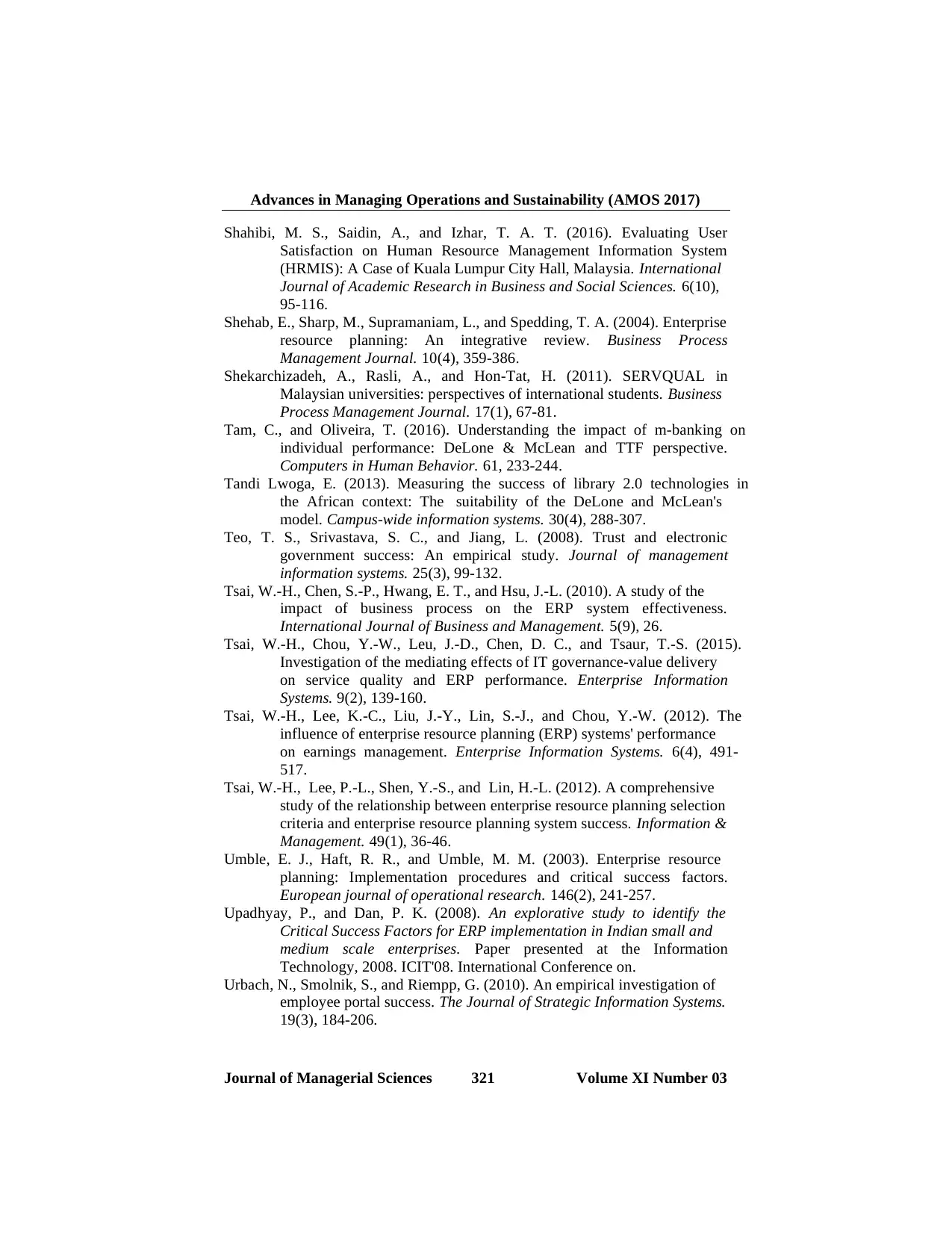
Advances in Managing Operations and Sustainability (AMOS 2017)
Journal of Managerial Sciences 321 Volume XI Number 03
Shahibi, M. S., Saidin, A., and Izhar, T. A. T. (2016). Evaluating User
Satisfaction on Human Resource Management Information System
(HRMIS): A Case of Kuala Lumpur City Hall, Malaysia. International
Journal of Academic Research in Business and Social Sciences. 6(10),
95-116.
Shehab, E., Sharp, M., Supramaniam, L., and Spedding, T. A. (2004). Enterprise
resource planning: An integrative review. Business Process
Management Journal. 10(4), 359-386.
Shekarchizadeh, A., Rasli, A., and Hon-Tat, H. (2011). SERVQUAL in
Malaysian universities: perspectives of international students. Business
Process Management Journal. 17(1), 67-81.
Tam, C., and Oliveira, T. (2016). Understanding the impact of m-banking on
individual performance: DeLone & McLean and TTF perspective.
Computers in Human Behavior. 61, 233-244.
Tandi Lwoga, E. (2013). Measuring the success of library 2.0 technologies in
the African context: The suitability of the DeLone and McLean's
model. Campus-wide information systems. 30(4), 288-307.
Teo, T. S., Srivastava, S. C., and Jiang, L. (2008). Trust and electronic
government success: An empirical study. Journal of management
information systems. 25(3), 99-132.
Tsai, W.-H., Chen, S.-P., Hwang, E. T., and Hsu, J.-L. (2010). A study of the
impact of business process on the ERP system effectiveness.
International Journal of Business and Management. 5(9), 26.
Tsai, W.-H., Chou, Y.-W., Leu, J.-D., Chen, D. C., and Tsaur, T.-S. (2015).
Investigation of the mediating effects of IT governance-value delivery
on service quality and ERP performance. Enterprise Information
Systems. 9(2), 139-160.
Tsai, W.-H., Lee, K.-C., Liu, J.-Y., Lin, S.-J., and Chou, Y.-W. (2012). The
influence of enterprise resource planning (ERP) systems' performance
on earnings management. Enterprise Information Systems. 6(4), 491-
517.
Tsai, W.-H., Lee, P.-L., Shen, Y.-S., and Lin, H.-L. (2012). A comprehensive
study of the relationship between enterprise resource planning selection
criteria and enterprise resource planning system success. Information &
Management. 49(1), 36-46.
Umble, E. J., Haft, R. R., and Umble, M. M. (2003). Enterprise resource
planning: Implementation procedures and critical success factors.
European journal of operational research. 146(2), 241-257.
Upadhyay, P., and Dan, P. K. (2008). An explorative study to identify the
Critical Success Factors for ERP implementation in Indian small and
medium scale enterprises. Paper presented at the Information
Technology, 2008. ICIT'08. International Conference on.
Urbach, N., Smolnik, S., and Riempp, G. (2010). An empirical investigation of
employee portal success. The Journal of Strategic Information Systems.
19(3), 184-206.
Journal of Managerial Sciences 321 Volume XI Number 03
Shahibi, M. S., Saidin, A., and Izhar, T. A. T. (2016). Evaluating User
Satisfaction on Human Resource Management Information System
(HRMIS): A Case of Kuala Lumpur City Hall, Malaysia. International
Journal of Academic Research in Business and Social Sciences. 6(10),
95-116.
Shehab, E., Sharp, M., Supramaniam, L., and Spedding, T. A. (2004). Enterprise
resource planning: An integrative review. Business Process
Management Journal. 10(4), 359-386.
Shekarchizadeh, A., Rasli, A., and Hon-Tat, H. (2011). SERVQUAL in
Malaysian universities: perspectives of international students. Business
Process Management Journal. 17(1), 67-81.
Tam, C., and Oliveira, T. (2016). Understanding the impact of m-banking on
individual performance: DeLone & McLean and TTF perspective.
Computers in Human Behavior. 61, 233-244.
Tandi Lwoga, E. (2013). Measuring the success of library 2.0 technologies in
the African context: The suitability of the DeLone and McLean's
model. Campus-wide information systems. 30(4), 288-307.
Teo, T. S., Srivastava, S. C., and Jiang, L. (2008). Trust and electronic
government success: An empirical study. Journal of management
information systems. 25(3), 99-132.
Tsai, W.-H., Chen, S.-P., Hwang, E. T., and Hsu, J.-L. (2010). A study of the
impact of business process on the ERP system effectiveness.
International Journal of Business and Management. 5(9), 26.
Tsai, W.-H., Chou, Y.-W., Leu, J.-D., Chen, D. C., and Tsaur, T.-S. (2015).
Investigation of the mediating effects of IT governance-value delivery
on service quality and ERP performance. Enterprise Information
Systems. 9(2), 139-160.
Tsai, W.-H., Lee, K.-C., Liu, J.-Y., Lin, S.-J., and Chou, Y.-W. (2012). The
influence of enterprise resource planning (ERP) systems' performance
on earnings management. Enterprise Information Systems. 6(4), 491-
517.
Tsai, W.-H., Lee, P.-L., Shen, Y.-S., and Lin, H.-L. (2012). A comprehensive
study of the relationship between enterprise resource planning selection
criteria and enterprise resource planning system success. Information &
Management. 49(1), 36-46.
Umble, E. J., Haft, R. R., and Umble, M. M. (2003). Enterprise resource
planning: Implementation procedures and critical success factors.
European journal of operational research. 146(2), 241-257.
Upadhyay, P., and Dan, P. K. (2008). An explorative study to identify the
Critical Success Factors for ERP implementation in Indian small and
medium scale enterprises. Paper presented at the Information
Technology, 2008. ICIT'08. International Conference on.
Urbach, N., Smolnik, S., and Riempp, G. (2010). An empirical investigation of
employee portal success. The Journal of Strategic Information Systems.
19(3), 184-206.
Paraphrase This Document
Need a fresh take? Get an instant paraphrase of this document with our AI Paraphraser
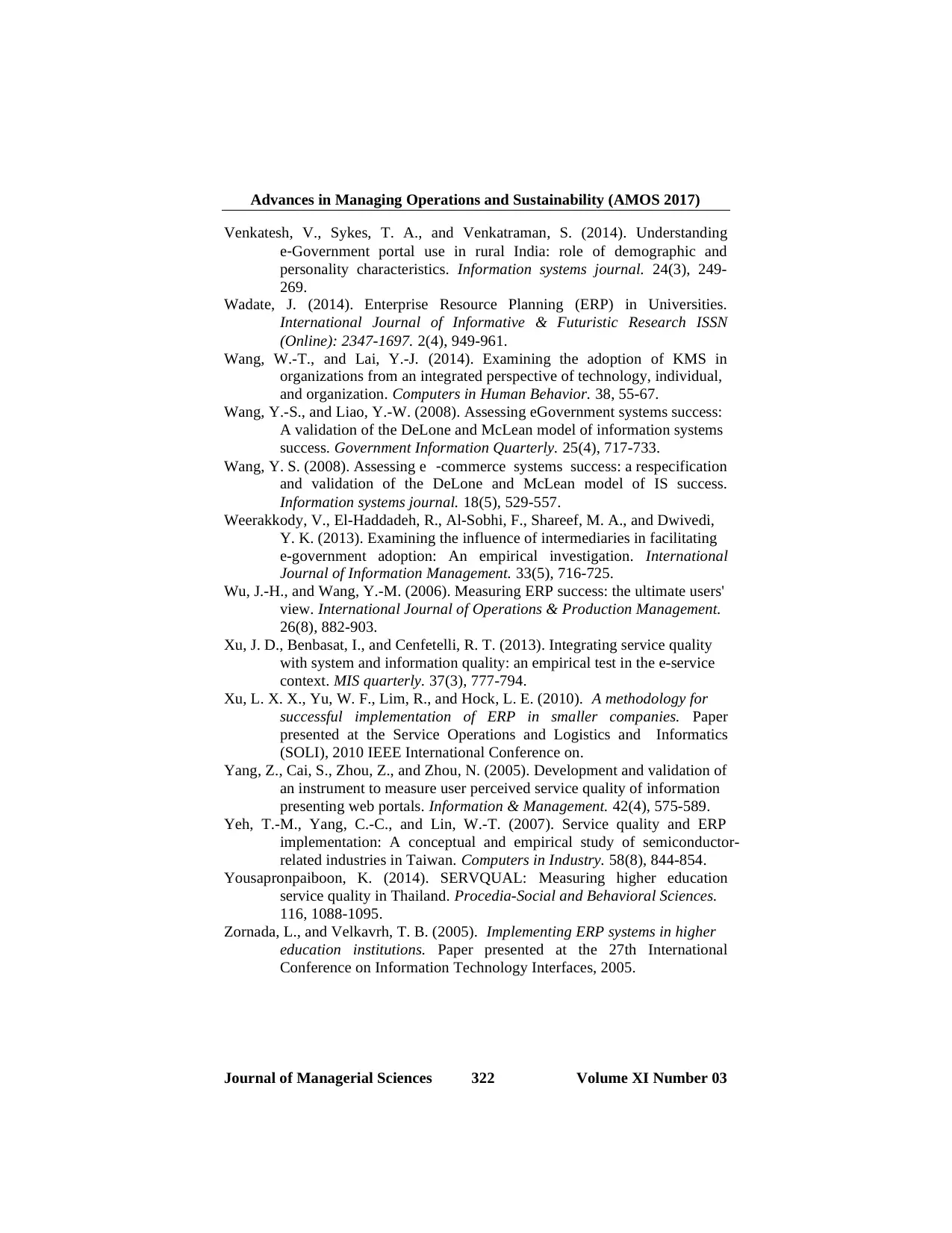
Advances in Managing Operations and Sustainability (AMOS 2017)
Journal of Managerial Sciences 322 Volume XI Number 03
Venkatesh, V., Sykes, T. A., and Venkatraman, S. (2014). Understanding
e‐Government portal use in rural India: role of demographic and
personality characteristics. Information systems journal. 24(3), 249-
269.
Wadate, J. (2014). Enterprise Resource Planning (ERP) in Universities.
International Journal of Informative & Futuristic Research ISSN
(Online): 2347-1697. 2(4), 949-961.
Wang, W.-T., and Lai, Y.-J. (2014). Examining the adoption of KMS in
organizations from an integrated perspective of technology, individual,
and organization. Computers in Human Behavior. 38, 55-67.
Wang, Y.-S., and Liao, Y.-W. (2008). Assessing eGovernment systems success:
A validation of the DeLone and McLean model of information systems
success. Government Information Quarterly. 25(4), 717-733.
Wang, Y. S. (2008). Assessing e ‐commerce systems success: a respecification
and validation of the DeLone and McLean model of IS success.
Information systems journal. 18(5), 529-557.
Weerakkody, V., El-Haddadeh, R., Al-Sobhi, F., Shareef, M. A., and Dwivedi,
Y. K. (2013). Examining the influence of intermediaries in facilitating
e-government adoption: An empirical investigation. International
Journal of Information Management. 33(5), 716-725.
Wu, J.-H., and Wang, Y.-M. (2006). Measuring ERP success: the ultimate users'
view. International Journal of Operations & Production Management.
26(8), 882-903.
Xu, J. D., Benbasat, I., and Cenfetelli, R. T. (2013). Integrating service quality
with system and information quality: an empirical test in the e-service
context. MIS quarterly. 37(3), 777-794.
Xu, L. X. X., Yu, W. F., Lim, R., and Hock, L. E. (2010). A methodology for
successful implementation of ERP in smaller companies. Paper
presented at the Service Operations and Logistics and Informatics
(SOLI), 2010 IEEE International Conference on.
Yang, Z., Cai, S., Zhou, Z., and Zhou, N. (2005). Development and validation of
an instrument to measure user perceived service quality of information
presenting web portals. Information & Management. 42(4), 575-589.
Yeh, T.-M., Yang, C.-C., and Lin, W.-T. (2007). Service quality and ERP
implementation: A conceptual and empirical study of semiconductor-
related industries in Taiwan. Computers in Industry. 58(8), 844-854.
Yousapronpaiboon, K. (2014). SERVQUAL: Measuring higher education
service quality in Thailand. Procedia-Social and Behavioral Sciences.
116, 1088-1095.
Zornada, L., and Velkavrh, T. B. (2005). Implementing ERP systems in higher
education institutions. Paper presented at the 27th International
Conference on Information Technology Interfaces, 2005.
Journal of Managerial Sciences 322 Volume XI Number 03
Venkatesh, V., Sykes, T. A., and Venkatraman, S. (2014). Understanding
e‐Government portal use in rural India: role of demographic and
personality characteristics. Information systems journal. 24(3), 249-
269.
Wadate, J. (2014). Enterprise Resource Planning (ERP) in Universities.
International Journal of Informative & Futuristic Research ISSN
(Online): 2347-1697. 2(4), 949-961.
Wang, W.-T., and Lai, Y.-J. (2014). Examining the adoption of KMS in
organizations from an integrated perspective of technology, individual,
and organization. Computers in Human Behavior. 38, 55-67.
Wang, Y.-S., and Liao, Y.-W. (2008). Assessing eGovernment systems success:
A validation of the DeLone and McLean model of information systems
success. Government Information Quarterly. 25(4), 717-733.
Wang, Y. S. (2008). Assessing e ‐commerce systems success: a respecification
and validation of the DeLone and McLean model of IS success.
Information systems journal. 18(5), 529-557.
Weerakkody, V., El-Haddadeh, R., Al-Sobhi, F., Shareef, M. A., and Dwivedi,
Y. K. (2013). Examining the influence of intermediaries in facilitating
e-government adoption: An empirical investigation. International
Journal of Information Management. 33(5), 716-725.
Wu, J.-H., and Wang, Y.-M. (2006). Measuring ERP success: the ultimate users'
view. International Journal of Operations & Production Management.
26(8), 882-903.
Xu, J. D., Benbasat, I., and Cenfetelli, R. T. (2013). Integrating service quality
with system and information quality: an empirical test in the e-service
context. MIS quarterly. 37(3), 777-794.
Xu, L. X. X., Yu, W. F., Lim, R., and Hock, L. E. (2010). A methodology for
successful implementation of ERP in smaller companies. Paper
presented at the Service Operations and Logistics and Informatics
(SOLI), 2010 IEEE International Conference on.
Yang, Z., Cai, S., Zhou, Z., and Zhou, N. (2005). Development and validation of
an instrument to measure user perceived service quality of information
presenting web portals. Information & Management. 42(4), 575-589.
Yeh, T.-M., Yang, C.-C., and Lin, W.-T. (2007). Service quality and ERP
implementation: A conceptual and empirical study of semiconductor-
related industries in Taiwan. Computers in Industry. 58(8), 844-854.
Yousapronpaiboon, K. (2014). SERVQUAL: Measuring higher education
service quality in Thailand. Procedia-Social and Behavioral Sciences.
116, 1088-1095.
Zornada, L., and Velkavrh, T. B. (2005). Implementing ERP systems in higher
education institutions. Paper presented at the 27th International
Conference on Information Technology Interfaces, 2005.
1 out of 26
Your All-in-One AI-Powered Toolkit for Academic Success.
+13062052269
info@desklib.com
Available 24*7 on WhatsApp / Email
![[object Object]](/_next/static/media/star-bottom.7253800d.svg)
Unlock your academic potential
© 2024 | Zucol Services PVT LTD | All rights reserved.